

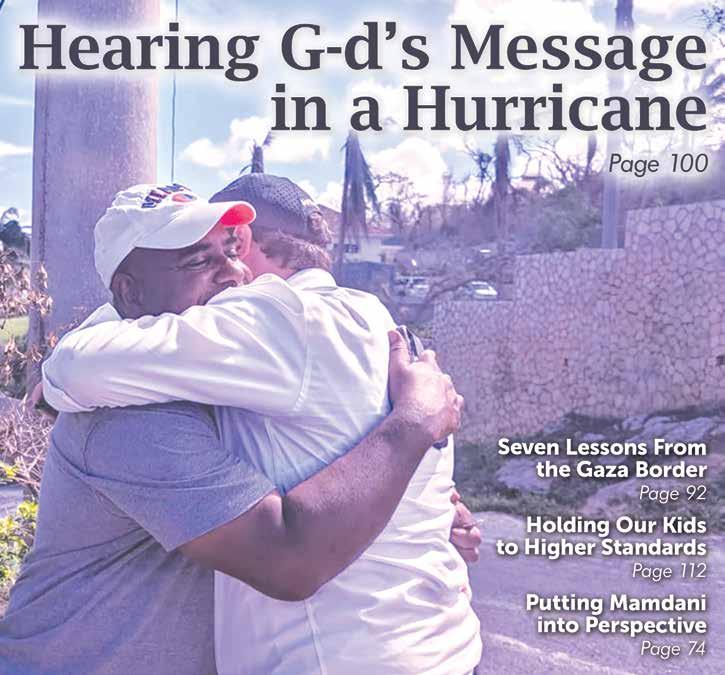






















We can live in faith.
Or we can live in fear.
The two are mutually exclusive.
A life of faith is a life anchored in the support of the One Above. It is unwavering, it is committed, it is steady, it is calming.
A life of fear blows hot and cold, swinging from one concern to the next.
Living in our era, there’s no need for one to conjure their own fears – the media has a never-ending bag of worries and terrors that can tear at a person’s psyche and destabilize their world.
One day, the fear is the economy. The next day, it’s a war in Iran. Then it’s China coming to get your savings and businesses. And then it’s politicians who hate you and your people. The fears creep in with different masks at different times, each one seeming more valid and solid than the other.
But a person who grasps at those masks will live a life holding onto pieces of panic, clinging to their worries without a moment’s peace.
But what if they threw away that baggage? What if they decided to disregard the fears that paralyze them? What if they understood that those concerns were flimsy justifications from the yetzer hara to sway
them away from their faith and trust in the One Above?
This week’s fear came in the form of a mayor of New York. His rhetoric on the campaign trail was blatantly anti-Jew and anti-Israel. And so, as a community, we galvanized to work to ensure that he wouldn’t become the leader of the most important city in the world.
But alas, Hashem has other plans. And His plan was that Zohran Mamdani with his smile and his deceit and anti-democratic ideals – don’t forget his delightful wife! –would be living in Gracie Mansion for the next four years.
As Jews, our job is to recognize that the world revolves around us – it truly does. Our job is to recognize that our Father in Heaven has a Master Plan for our nation and for His world. He is pulling the strings, moving the parts, putting the pieces together. He loves us, He cares for us, He knows what’s best for us.
When we hold fast to our faith in the One Above, our lives remain steady and composed regardless of who roams the halls of City Hall.
Wishing you a wonderful week, Shoshana

Yitzy Halpern, PUBLISHER publisher@fivetownsjewishhome.com
Yosef Feinerman, MANAGING EDITOR ads@fivetownsjewishhome.com
Shoshana Soroka, EDITOR editor@fivetownsjewishhome.com
Nate Davis
Editorial Assistant
Nechama Wein
Copy Editor
Rachel Bergida Shana Brecher
Lani White
Design & Production
Gabe Solomon
Distribution & Logistics
P.O. BOX 266
Lawrence, NY 11559
Phone | 516-734-0858
Fax | 516-734-0857
Classified Deadline: Monday 5:00PM classifieds@fivetownsjewishhome.com text 443-929-4003
The Jewish Home is an independent weekly magazine. Opinions expressed by writers are not necessarily the opinions of the publisher or editor. The Jewish Home is not responsible for typographical errors, or for the kashrus of any product or business advertised within. The Jewish Home contains words of Torah. Please treat accordingly.











Dear Editor,
What’s at stake for losing patience?
The answer is the world. Adam couldn’t hold back from eating from the fruit when commanded in the ninth hour, even though the fruit would have soon been permitted with the onset of Shabbos.
But how is one to hold back from responding to a perceived derogatory comment?
If we look at Sefer HaYashar—the Book of Uprightness, another name for Sefer Bereishis (Avodah Zara 25a)—and consider the example of the Avot, we can propose a path.
Yaakov was the confluence of Avraham’s chesed and Yitzchak’s gevurah. He symbolized emes and tiferet, glory (see Zohar Hadash 33b). It is in Yaakov that we see patience, the ability to deal even-handedly with a charlatan, Lavan. How? Hard work. He was coming off of fourteen years of toil in Torah, which prepared him for twenty years of work for an untruthful individual.
Following Yaakov’s example of patience and withholding retaliatory comments earns one an immediate erasure of sins and shows G-d that you value patience that was exploited by the first man. It’s no surprise that the Gemara (Gittin 36b) brings down that the person who holds back is personified by the verse (Shoftim 5:31), “…and those who love Him are like the sun when it comes out in all its force.” It takes chesed to consider the other person’s feelings,
gevurah, to hold back, and emes, truth, in realizing there might be some validity to the statement.
Steven Genack
Dear Editor,
Who is to blame for Mamdani’s win tonight? I blame Cuomo. Cuomo made himself the anti-Mamdani candidate. Instead of telling people why they should vote for him (maybe there were no reasons why), he just told people that they should vote for him because he’s not Mamdani.
Where were his campaign managers? The people who came out for Mamdani felt his message resonated with them. The people who came out for Cuomo came out because they were scared of Mamdani. You don’t win votes with fear. You win votes with substance.
Alan Scheinberg
Dear Editor, Mamdani for NY – oy. We are really in tzuros.
At just 34 years old, Mamdani will lead the country’s largest city with a budget exceeding tens of billions of dollars and a workforce of hundreds of thousands. Many observers pointed out his relative lack of executive or administrative experience as a potential liability. When you’re dealing with the complexity of public-safety policy, infrastructure, schools, and a budget long overdue for reform, inexperience is not a minor issue—it’s a risk.
Continued on page 14


On the campaign trail, Mamdani promised ambitious goals: rent freezes, free buses, universal childcare, cityowned grocery stores. These may appeal emotionally—who doesn’t want affordability?—but the question remains: How will they be paid for? How will they be implemented without crippling private sector activity or driving capital and business out of the city? A mayoral vision without a realistic fiscal framework is not bold, it’s dangerous.
His pro-Hamas slogans and antiIsrael rallies would make me throw up my chicken soup. And having him in power will only give more strength to movements that seek to destroy Israel and the Jewish nation.
I understand the allure of “change” and “fresh leadership,” but change for its own sake isn’t enough.
I hope Mayor-elect Mamdani proves me—and others concerned—wrong. I genuinely do. But until we see firm plans and actual delivered results—not just bold promises—New Yorkers have every right to ask: Is this leadership safe? Is it sustainable? Is it wise?
Because if not, we’re all going to have to head to Miami.
Tehila Mark
Dear Editor, I love reading Etti Siegel’s column in your newspaper. Even though I don’t work in education, I have a few children in school, and her advice really is always so thoughtful and spot-on.
This week, she wrote about parents who are “overbearing.” I cannot tell you how much I understand what she is writing about.
Kids nowadays need to breathe. Their parents are high-octane, always wanting to hear about every little detail and be on top of every little thing. But they need to let their kids be. They don’t need to organize every play date or Shabbos afternoon visit. Let your kids make the phone calls. Don’t hover over them to make sure they’re talking/playing/eating the right way. Give them a chance to make their own mistakes and come to their own conclusions. Sometimes, when I speak with kids, I wonder if they ever made a decision in their whole life. Their parents are always arranging things for them. They don’t have the opportunity to step up and become “people.”
Sincerely,
Rivka Chaya Lowenthal



When Typhoon Kalmaegi slammed central Philippines this week, people sheltered on rooftops as streets flooded. At least three people were killed. Hundreds of thousands were forced to flee their homes from the raging waters and winds.
The typhoon, locally named Tino, weakened since making landfall early on Tuesday but continued to bring winds of more than 80mph. It is forecast to move across the Visayas islands region and out over the South China Sea by Wednesday.
“The situation in Cebu [an island] is really unprecedented,” provincial governor Pamela Baricuatro said in a Facebook post. “We were expecting the winds to be the dangerous part, but... the water is what’s truly putting our people at risk. The floodwaters are just devastating.”
A rescue helicopter went down near Agusan del Sur on Mindanao island, prompting a search and rescue mission to locate the chopper and the people onboard.
In total, almost 400,000 people were moved from the typhoon’s path, Rafaelito Alejandro, deputy administrator at the Office of Civil Defence, said.
The Philippines is hit by an average of 20 storms and typhoons each year.
Super Typhoon Ragasa, known locally as Nando, struck in late September, followed swiftly by Typhoon Bualoi, known locally as Opong.
The country was slammed by another natural disaster in September when a 6.9 magnitude earthquake struck central Philippines, with Cebu bearing the brunt of the damage. Dozens were killed or injured in the quake.

Kim Yong Nam, North Korea’s former ceremonial head of state and a lifelong supporter of the ruling dynasty, died this week at the age of 97.
He held the role of president of Pyongyang’s rubber-stamp Supreme People’s Assembly from 1998 to 2019.
Kim Yong Nam served in various diplomatic roles under the regimes of the country’s founder Kim Il Sung, his son Kim Jong Il, and his grandson Kim Jong Un. He was not related to the family.
According to North Korean Central News Agency, KCNA, Kim Yong Nam was an “old-generation revolutionary who left extraordinary achievements in the development history of our party and country.” He will have a state funeral.
Kim Yong Nam was born when the Korean peninsula was under Japanese colonial rule, into what KCNA called a family of “anti-Japanese patriots.” He attended Kim Il Sung University in Pyongyang and also studied in Moscow, before beginning his career in the 1950s.
Starting out as a low-ranking official in the ruling party, he rose to become foreign minister and then served as chairman of the Supreme People’s Assembly for nearly all of Kim Jong Il’s reign.
According North Korean diplomat Thae Yong Ho, who has since resettled in the South, Kim Yong Nam “never made his own opinions known... He had no close [allies] or enemies. He never showed any creativity. He never put out a new policy. He only repeated what the Kim family have said before,” said Thae, who is now the leader of South Korea’s presidential advisory council on reunification.
“Kim Yong Nam is the perfect role model of how to survive for a long time in North Korea,” Thae said, adding that he avoided criticism from within the party by maintain a “clean” reputation.
Unlike many other high-ranking officials in the North, Kim Yong Nam was never demoted even as power was handed down through three generations of the Kim family clan. He retired in April
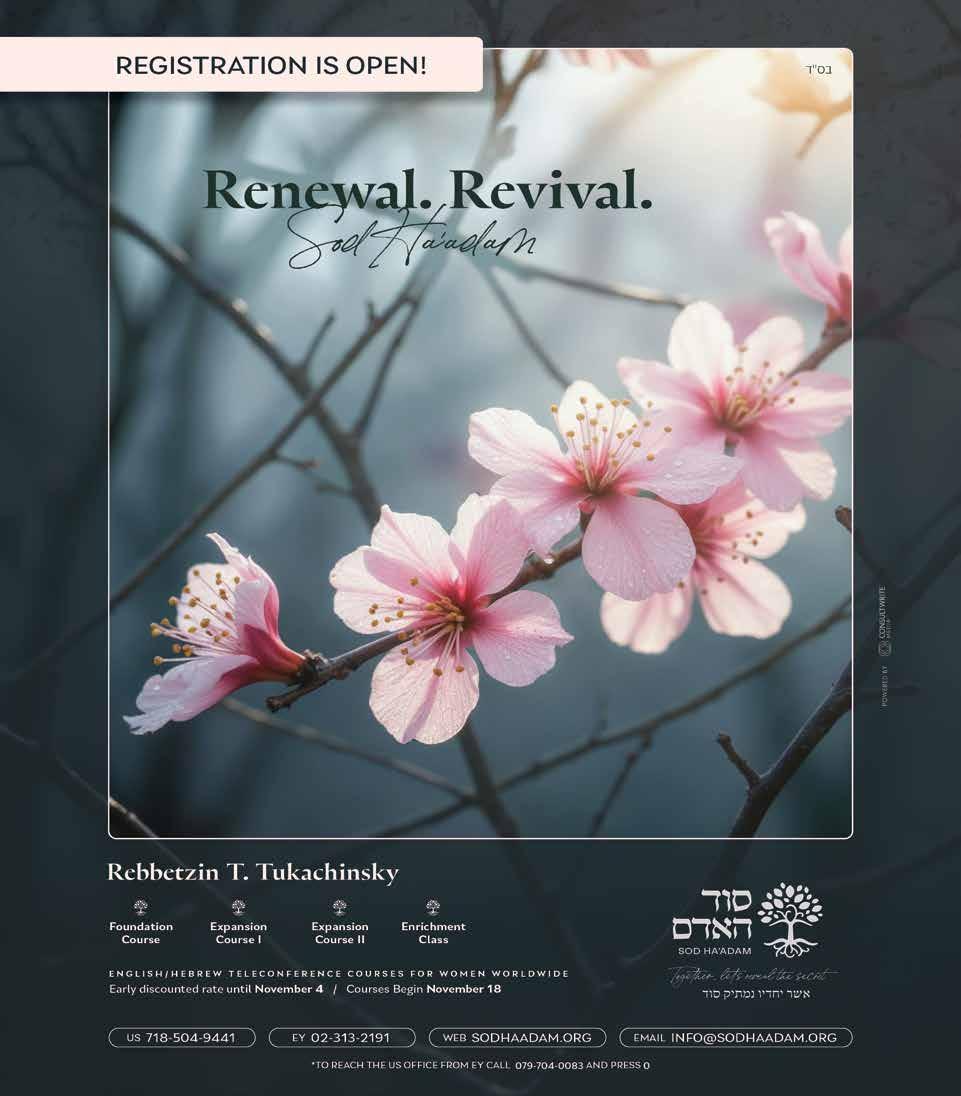
2019. Many other officials in North Korea have been purged, sent to labor camps or even killed as their usefulness wore off. For example, Kim Jong Un ordered the execution of his uncle Chang Song Thaek in 2013 for “acts of treachery,” state media reported then.

The Torre dei Conti tower in Rome, which dates back to the 13th century, was built by Pope Innocent III as a residence for his family. It had been closed to the public since 2007 but was undergoing renovations when it collapsed this week. Several workers were trapped in the rubble. Rescuers raced to save them. One worker died after being trapped in the collapse for eleven hours. He was pulled from the wreckage on Monday.
The 66-year-old man, Octay Stroici, was the last of several workers saved in the rescue operation that was briefly interrupted by a second collapse of the 95-foot-tall Torre de’ Conti tower, Luca Cari, a spokesperson for the Rome Fire Service, said.
His condition was critical when he was finally rescued.
“On behalf of myself and the government, I express my deepest sorrow and condolences for the tragic death of Octay Stroici, the worker who fell victim to the collapse of the Torre dei Conti in Rome,” read a statement from Prime Minister Georgia Meloni’s office that was released overnight. “Our thoughts are with his family and colleagues at this time of unspeakable grief. I would like to thank once again the rescue workers and all those who worked tirelessly and courageously to try to save his life.”
Before being saved, the trapped worker was conscious and communicating with search-and-rescue crews, Cari said. About 140 firefighters responded to the scene, some digging with their bare hands to free the worker.
Rome Mayor Roberto Gualtieri told reporters on Monday evening, just before the last rescue was made, that doctors had reached the worker and supplied him

with oxygen.
The tower is in the historic part of central Rome near the Roman Forum and the Colosseum.
At the time of the first collapse, 11 workers from two companies were working on the tower. The second partial collapse occurred about an hour after the first, while firefighters were attempting to rescue the workers.

Born after 2006? Better throw away your cigarettes.
The Maldives this month barred people born after 2006 from smoking or purchasing tobacco products in the country, making the South Asian archipelago the first country to implement such a law.
“Individuals born on or after 1 January 2007 are prohibited from purchasing, using, or being sold tobacco products within the Maldives,” the country’s health ministry said on Saturday. The new law, ushered in by President Mohamed Muizzu, leaves those who were born in 2006 or earlier free to smoke.
At least 21 percent of the archipelago’s population over the age of 15 smoked cigarettes daily, and more than 25 percent of the population used tobacco daily in 2022, according to estimates by World Health Organization’s global report on tobacco prevalence, published in October. The Maldives’ law around smoking was imposed to protect young people and align with the World Health Organization’s framework for tobacco control, the health ministry said.
The smoking ban went into effect on Saturday. It also extends to tourists — hundreds of thousands of whom visit the Maldives every month. Alcohol, too, is banned on the local non-resort islands of the archipelago. Despite not being able to smoke or drink, throngs of tourists still enjoy the country’s beautiful beaches.
Last year, the Maldives banned the import, sale, distribution, possession and use of electronic cigarettes and vaping for everyone in the nation, including tourists.
The smoking ban follows last year’s imposition of import duties on cigarettes in the Maldives, with the price of a pack of cigarettes jumping from roughly $7 to $16.
The Maldives is the first country to issue a ban against smoking.
Jacinda Ardern, the former prime minister of New Zealand, ushered in an anti-smoking law in 2023 that would have gradually phased out cigarette sales and licensing. Under the law, anyone born on or after January 1, 2009, would be banned from using tobacco products by 2027. The law was repealed later that year when a new government took over.
The United Kingdom is in the process of enacting a ban similar to the Maldives, seeking to prohibit the sale of tobacco, vapes and similar products to people born on or after January 1, 2009. The legislation is now at the committee stage at the House of Lords.

It’s been 30 years since a mob of Iranian students overran security guards at the U.S. Embassy in Tehran while diplomats endeavored to hide from the armed pack. Dozens of hostages were seized on November 4, 1979.
Sixty-six Americans were taken captive by the Iranian mob. Fifty-two of them were held for 444 days, until January 20, 1981, when the Algiers Accords between the Iranian and American governments was signed.
This week, on Tuesday, Iranians celebrated the takeover of the embassy.
In what is a yearly commemoration, thousands of people returned to the spot in downtown Tehran chanting “Death to U.S.” and “Death to Israel.” Some hanged effigies of U.S. President Donald Trump and Prime Minister Benjamin Netanyahu and set fire to American and Israeli flags.
State media said similar gatherings took place in other Iranian cities and towns.
Mock-ups of Iranian missiles were on display on the sideline of the rallies, some inscribed with the words “Death



to America.” Replicas of centrifuge machines used in uranium enrichment were also on display.
On Monday, Iran’s supreme leader Ayatollah Ali Khamenei vowed during a meeting with students that there would be no move toward normalizing ties with Washington soon — a message echoed on banners at Tuesday’s rallies.
Parliament Speaker Mohammad Bagher Qalibaf was the key speaker at the rally in Tehran. He accused U.S. and Israel of killing Iranian scientists during this summer’s 12-day war because the West “opposes an independent, integrated, and powerful Iran.”
He also criticized the former U.S. embassy, calling it a “den of spies.”
The two nations have had no diplomatic relations since militant students seized the embassy in 1979.
Hurricane Melissa made landfall in Jamaica last Tuesday as a Category 5 hurricane, carrying winds of up to 185 mph. Early Wednesday, it slammed eastern Cuba as a Category 3 hurricane.
The hurricane also impacted Haiti, Bermuda, and other countries in the Caribbean.
On Wednesday, Jamaica’s main international airport reopened, and emergency relief crews landed in the country, distributing basic necessities such as food and water. In southwest Jamaica, at least four people were found dead, according to authorities. As of late last week, 77% of the island was without power, and over 25,000 people were staying in shelters in western Jamaica.

According to Andrew Holness, the prime minister of Jamaica, the storm decimated around 90% of roofs in Black River, a southwest coastal town.
In Haiti, the hurricane caused at least 25 casualties, 20 or more of whom were killed in Petit-Goâve, according to the country’s Civil Protection Agency. Ten children were among those killed.
Meanwhile, 18 people were reported missing. Over 11,600 people were staying in shelters in Haiti, according to officials. According to the agency, the hurricane caused damage to over 160 homes and decimated 80 more.
In Cuba, the army helped rescue people. Over 735,000 people were evacuated by the Civil Defense in eastern Cuba, after which no casualties were reported. The storm knocked out power, internet, and telephone service in many areas of Cuba.
On Thursday, the hurricane was expected to pass Bermuda. On Thursday morning, it became a Category 2 storm, traveling north-northeast at 21 mph and carrying winds of up to 105 mph, the U.S. National Hurricane Center in Miami reported.
Two people were arrested following a stabbing attack on Saturday night on a train in central England. Ten people were hospitalized, nine of whom sustained lifethreatening injuries. Thankfully, no one was killed in the attack.
Police were notified at 7:42 p.m. local time of the attack taking place on a train
traveling from Doncaster to the King’s Cross in London. The train stopped abruptly at Huntingdon station, where police had been deployed. The armed officers then proceeded to arrest two suspects.

One witness described the arrests, noting that officers tasered a suspect who was waving a large knife before detaining him.
“A young girl was distraught as the attacker tried to stab her, but a hero of an older man got in the way taking a gash on his forehead and I think another on his neck,” another passenger, Olly Foster, told the Daily Mail.
Prime Minister Keir Starmer called the attack “deeply concerning,” while British Transport Police (BTP) described it as “a major incident” that counterterrorism officers are helping investigate. While responding to the attack, BTP declared the national codeword “Plato,” which is



used in response to “marauding terrorist” attacks, though the declaration was later rescinded.
“My thoughts are with all those affected, and my thanks go to the emergency services for their response. Anyone in the area should follow the advice of the police,” Starmer wrote on X.
According to Defense Minister John Healey, the attack seems to be an “isolated” one.
Chris Casey, the British Transport
Police Chief Superintendent, said the incident was “shocking” and shared that his thoughts were with those wounded and their loved ones.
The police have confirmed that the attack was not terror related.
On Monday, UK police charged Anthony Williams, 32, with attempted murder for the mass stabbing attack that wounded 11 people. He was charged with 10 counts of attempted murder, one of actual bodily harm and one of possession
— a Friday evening stabbing in which a 14-year-old boy received minor injuries and two reports of a man with a knife at a barber shop on Friday evening and Saturday morning. In all three cases, the suspect quickly left the scene, and police did not detain anyone.
The second suspect who was arrested was released from custody.
Shabana Mahmood, the U.K.’s Home Secretary, said that she was “deeply saddened to hear about the stabbings,” adding that her “thoughts go out to all those affected.” She advised the public, as Casey did, to resist speculating about the incident at this time.
Authorities deployed a number of air ambulances as part of its large-scale response, which included “numerous ambulances, tactical commanders, our Hazardous Area Response Team, and critical care teams,” according to the East of England Ambulance Service.
After the attack, London North Eastern Railway (LNER) said its East Coast Main Line was “experiencing major disruption across the LNER route” and advised people against traveling.

The government of Egypt held an official opening ceremony for the Grand Egyptian Museum (GEM) on Saturday, hosting around 80 foreign officials to celebrate the $1 billion project’s completion, according to a government spokesperson.
of a bladed article. Police say that Williams was also charged with attempted murder over an earlier incident at Pontoon Dock light rail station in London just before 1 a.m. on Saturday, in which a victim “suffered facial injuries after being attacked with a knife” by an assailant who fled the scene.
Another police force, Cambridgeshire Constabulary, said it is investigating whether Williams was involved in three incidents in the city of Peterborough
“It is a great day for Egypt and for humanity. This is Egypt’s gift to the world. It’s a dream come true, after all these years, the GEM is finally and officially open,” exulted Nevine El-Aref, the Minister of Tourism and Antiquities’ media adviser.
The GEM, the world’s largest museum dedicated to one civilization (ancient Egypt), cost more than $1 billion in Egyptian and international funding. In 1992, the government originally allocated 117 acres for the museum. In 2002, Egypt ran an international architectural competition for the museum’s design. In July 2003, a design was decided

While the government planned to open the museum in 2010, the project’s completion was delayed by 15 years because of economic and political crises in Egypt, as well as the pandemic and conflicts in the region.
The project was originally supposed to cost $500 million. However, over time, the cost doubled.
The museum, a triangular-themed structure spanning over 5-millionsquare feet, is aligned perfectly with the three main pyramids of Giza and covers thousands of years of Egyptian history to around 400 A.D. at the end of the Greek and Roman eras.
The 53-foot-high Hanging Obelisk, which is around thousands of years old, sits upon a suspended modern structure with a glass floor in front of the museum’s main entrance, allowing visitors to look up and see its ancient inscriptions from a totally new angle. The obelisk is the only one of its kind in the world.
There are 12 primary exhibition halls in the museum. According to officials, the GEM will have around 100,000 items on display. Inside, the museum offers incredible panoramic views of the pyramids.
A statue of King Ramses II stands in front of the GEM’s entrance courtyard.
The museum also features the entire collection of King Tutankhamun, or King Tut, the ancient Egyptian king who ruled from around 1333 to 1322 B.C., in addition to King Khufu’s Boats Museum.
Egypt hopes the GEM will boost the country’s economy by bringing in tourists. Authorities expect around 5 million visitors each year.

According to the Integrated Food Security Phase Classification (IPC), Sudan has been hit by a famine in the city of elFasher, which is in the western Darfur region, and the town of Kadugli, which is located in the southern South Kordofan province. The IPC reported that 20 other areas in the Darfur and Kordofan are at risk for famine, as well.
An ongoing civil war in Sudan is

behind the famine. Since April 2023, a paramilitary group called the Rapid Support Forces has been at war with the Sudanese military. The conflict has wreaked havoc on the northeastern African country, killing over 40,000 people, according to the United Nations. Other aid groups suggest the death toll might be much higher. Meanwhile, the war has displaced over 14 million people and caused diseases to spread.
“Famine and the risk of famine are urgent priorities, but they are only the most severe symptoms of a far broader and deepening crisis affecting millions across Sudan,” the IPC reported. “This is a man-made emergency, and all steps needed to prevent further catastrophe are clear.”
The two cities have been hit by “a total collapse of livelihoods, starvation, extremely high levels of malnutrition and death,” the IPC reported.
For 18 months, el-Fasher was under siege by the Rapid Support Forces, starving tens of thousands of people of food and other necessities. The paramilitary group took control of the key city last week and reportedly killed hundreds of civilians, capturing the Sudanese army’s last stronghold in Darfur. Kadugli and its tens of thousands of residents have also been under the RSF’s siege for months, and Save the Children reported in September that the town had no more food supplies.
As of September, around 375,000 people are living in areas hit by the famine, while around 6.3 million people in Sudan are living through extreme levels of hunger.
A famine is declared when at least two people per 10,000 in an area die of malnutrition-related causes, or at least one in five people or households face starvation.
Tawila, Melit, Tawisha, and other towns near el-Fasher may also soon be hit by famine, the IPC warned.
The 6.3 magnitude quake that struck northern Afghanistan just before 1 a.m. local time Monday killed at least 20 people, injured more than 520 others and damaged countless buildings, including one of the country’s most iconic landmarks, according to Afghan authorities. It was the latest natural disaster to batter the ailing nation.
The quake’s epicenter was near the city of Mazar-i-Sharif, home to about
500,000 people and known for its magnificent 15th-century Blue Mosque, whose iconic turquoise tiles fell from its minarets. Parts of its walls and historical writings were also destroyed in the quake.

Households were swallowed under the rubble. The shattered lives in the northern provinces of Balkh and Samangan echo the destruction from another earthquake that Afghan officials have said killed at least 2,200 people in eastern Afghanistan in August.
The quake was the latest in a cascade of catastrophes to hit Afghanistan this year, including the severe impact of aid cuts, the return of more than 2 million Afghans from neighboring countries and the prospect of a war with neighboring Pakistan.
As Afghanistan moves closer to winter, households displaced by the quake in August are still sleeping in tents. Families have returned from Pakistan and Iran in droves amid rising xenophobia, and many are struggling to find a home as housing prices in cities like Kabul, the capital, have skyrocketed.
By Monday night, it was unclear if the death toll would increase sharply, and if rescue teams from the Afghan emergency services and international nonprofits had reached all the affected areas.
Afghanistan is prone to earthquakes because it lies at the convergence of the Eurasian and Indian tectonic plates. The August quake flattened villages in hardto-reach mountainous areas and caused at least $183 million in damage, according to the World Bank — equivalent to about 1% of the country’s gross domestic product.
The quake Monday hit the provinces of Samangan and Balkh in the north, near the border with Uzbekistan. In Mazar-iSharif, the capital of Balkh, locals were clearing debris from the grounds of the Blue Mosque, an important pilgrimage site among Shia Muslims and a place of celebrations for Nowruz, the Persian New Year.
The mosque was still standing Monday evening, but visitors, worshippers and journalists were barred from entering the complex. (© The New York Times)


Last week, Buckingham Palace announced that Andrew, the younger brother of King Charles III, will be stripped of his royal title. The punishment is almost unheard-of for those in the modern British family. The removal of Anderw’s title is due to his connection to Jeffrey Epstein.
In a statement on Thursday, the Palace said it had begun a formal process to remove the “style, titles and honors of Prince Andrew.” The prince, it said, “will now be known as Andrew Mountbatten Windsor,” the family name of members of the House of Windsor.
Andrew, 65, is also set to be evicted from his sprawling residence, Royal Lodge, and move to a private house.
The announcement came in just a
three-paragraph statement. Andrew has vociferously denied any wrongdoing. Still, his connection to Epstein has made the royal family uncomfortable.
Epstein died in 2019 while in jail awaiting trial on federal charges.
Last week, Andrew announced he would give up the use of his other most prominent title, the Duke of York. His status as a prince, the palace said at the time, was based on his being the son of a monarch, Queen Elizabeth II.
Not since King Edward VIII abdicated the throne in 1936 over his proposed marriage to a divorced American woman, Wallis Simpson, has the royal family experienced such an abrupt and visible downgrade of one its most senior members.
Palace officials also said Andrew would move to a residence on the grounds of Sandringham, a royal residence in Norfolk, northeast of London, which is owned personally by Charles. The king, they said, would support Andrew through his private funds. Andrew’s former wife, Sarah Ferguson, who had lived with him at Royal Lodge, will receive no further support from the family, officials said.


On Monday morning, as a team of 15 people were heading toward Yalung Ri, a Himalayan peak in Nepal, they became caught up in an avalanche. Seven people were killed in the disaster at the base camp. Three of them were Americans; one was Canadian, one was Italian and two were Nepali nationals.
Four others were injured and four people are missing, although rescue efforts are ongoing.
In October, the Nepali Army rescued more than 1,500 people, including around 200 foreigners who had been trapped following avalanches in various hilly regions of the country, according to Review Nepal. The latest incident will add to concerns about the threats faced by adventure tourists in the country.
Yalung Ri has an elevation of more than 18,000 feet at its peak. The avalanche occurred roughly one and a half hours into the ascent on Monday morning, when the group was progressing through a steep ice slope.
The Nepal Army, Nepal Police and Armed Police Force were among the agencies involved in the search and rescue operations but adverse weather conditions were hampering efforts.
Yalung Ri, near the Nepal-Tibet border, is seen as an alternative for climbers to Everest region routes, Fiscal Nepal reported. But Nepal is no stranger to avalanches. Two hundreds foreigners were among 1,500 climbers who had to be rescued by the Nepali army in Upper Manang, Humde, Pisang, Tilicho, as well as the Khangsar areas of Manang district.
World Zionist Organization as per a new deal reportedly reached Friday. The previous agreement collapsed after it was suddenly announced that Yair Netanyahu, the prime minister’s controversial oldest son, would be nominated to lead the WZO’s Diaspora and Information Department — a position that includes an office, car, and pay that is comparable to a government minister’s salary. That announcement upset many and led the opposition Yesh Atid party to pull out of the deal. The agreement collapsed on Wednesday night.
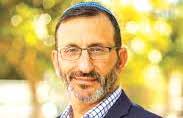
The prime minister’s son will not assume any leadership roles in the WZO, as per the new deal, which isn’t yet finalized. It is unclear who will lead the Diaspora and Information Department. If the deal is approved, Rabbi Doron Perez would serve as chair of the WZO until halfway through his five-year term, when Hagoel will reassume the position. Originally, a Yesh Atid party representative was supposed to succeed Rabbi Perez. Rabbi Perez is the chairman of the religious Zionist World Mizrachi Movement and the father of Cpt. Daniel Perez, whose remains were held in Gaza for two years after he was murdered on October 7.
The previous deal’s details regarding the Jewish National Fund-KKL’s leadership is expected to remain unchanged. Yesh Atid MK Meir Cohen is expected to retire from the Knesset after serving for 12 years and become the Jewish National Fund-KKL’s next chairman. In the Knesset, a Likud representative would replace him in the middle of his term.
Current Chief Yaakov Hagoel may reclaim his leadership position in the
On Thursday, the remains of hostages Amiram Cooper and Sahar Baruch were brought home from Gaza. Now, all 76 of those kidnapped from Kibbutz Nir Oz, including nine whose bodies were abducted, have been returned home.
The kibbutz, which saw a fourth of its members killed or kidnapped, announced that “755 days after the massacre, there
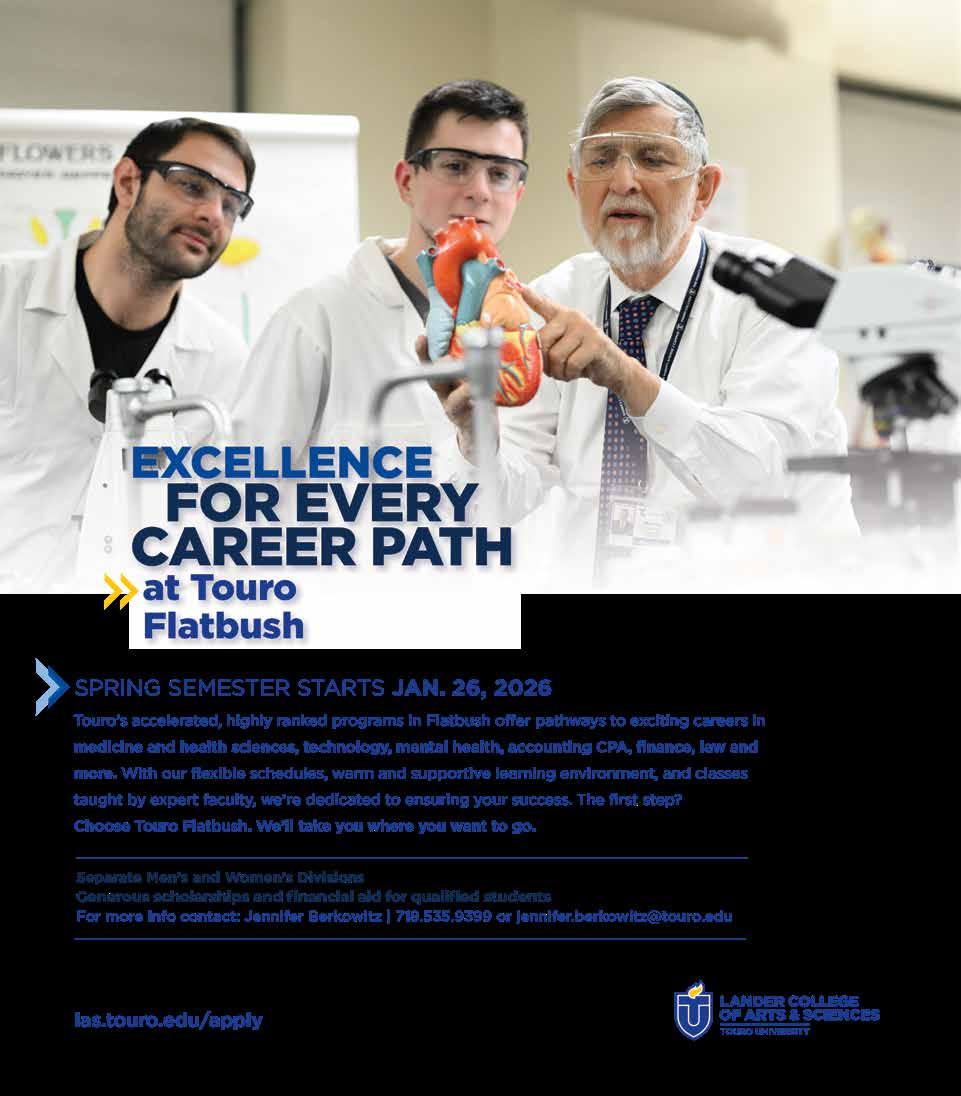
30 are no more hostages from Nir Oz in captivity in Gaza.”
“On October 7, in hours of debacle, 76 people were snatched from Nir Oz, and our home became a locus of disaster,” the kibbutz said. “Since then, the Nir Oz community has lived that horrible day and struggled for the return of all the hostages.”

It continued, “Now, with the return of the final hostage from the kibbutz, we can start processing, recuperating and grieving our 65 loved ones who will not return, 14 of whom were abducted alive and murdered in captivity. Alongside our painful closure, there are still 11 families waiting for their loved ones.”
The kibbutz added that it would continue working “to bring everyone home, until the last hostage.”
The youngest hostage, Kfir Bibas, who was one years old and was kidnapped and murdered along with his mother Shiri and four-year-old brother Ariel, was from Kibbutz Nir Oz. His father, Yarden Bibas, was freed in February during a ceasefire that was struck at the beginning of this year.
The kibbutz was invaded by over 500 terrorists. Of Nir Oz’s 100 homes, only six were not entered by terrorists during the massacre. All the others were set ablaze and damaged during the Hamas-led October 7 attack.
Amiram Cooper, 84, was kidnapped alive from his home in Nir Oz. He was killed while in Gaza in February 2024, the IDF confirmed in June 2024.
At his funeral on Sunday, President Herzog said, “I stand here today with my head bowed to ask of you, Amiram, forgiveness. I’m sorry, Amiram, that we didn’t manage to rescue you in time from the jaws of captivity. Sorry that it took us far too long to bring you back to the landscape of your homeland. Sorry that you were captured while still alive, and that you return to us only to be buried in the ground.”
He also apologized to the community of Nir Oz that the country failed to protect them on October 7. “I’m sorry that we weren’t here in a time of danger, sorry that in the face of human monsters, you stood with bare hands to protect yourselves and your home,” he said.
Sahar Baruch was 25 years old when he was taken into captivity on October 7. He was buried in Kibbutz Be’eri on Sunday alongside his brother, Edan Baruch, 20, an off-duty IDF soldier who was murdered by Hamas terrorists during the October 7, 2023, massacre.
Eulogizing her son, Sahar’s mother, Tami, said that the “terrible trauma” of October 7 “will always be etched in our hearts.”
She lamented that after two years of captivity in Gaza, being a hostage became part of her son’s identity.
“Before that, you had many other identities, such as a traveler, chess player, kayaker, scholar, nerd, steel mechanic, and much more,” she said.
“I had hoped for you that there would be new identities, like the electrical engineer you wanted to be, a boyfriend, a father, and so much more, but that will no longer happen,” she lamented. “We have many memories, but not enough memories together.”
Sahar studied engineering at BenGurion University. He hid with his brother, Edan, in their home’s safe room

on October 7, but the two fled the house after Hamas terrorists set it on fire. Sahar was kidnapped while searching for his brother’s inhaler, while Edan was fatally shot after exiting the safe room. Their grandmother, Geula, was killed separately in Be’eri during the massacre.

On Sunday evening, Hamas released the remains of three more hostages: Col. Asaf Hamami, Cpt. Omer Neutra, and Staff Sgt. Oz Daniel, all of whom were soldiers whose bodies were taken to Gaza after they were killed while fighting terrorists during the October 7 massacre.
Israel verified the three soldiers’ identities on Monday morning. On Sunday night, U.S. President Donald Trump confirmed that the remains of Omer Neutra, an American-Israeli soldier from Plainview, New York, had been recovered.
“The Government of Israel shares in the profound grief of the Hamami, Neutra, and Daniel families, and of all the families of the fallen hostages,” the Prime Minister’s Office stated, adding that the Jewish state is “determined, committed and working tirelessly” to bring home the bodies of the remaining eight hostages.
Hamami, a 40-year-old commander of the Gaza Division’s Southern Brigade, was from Kiryat Ono and was murdered while defending Kibbutz Nirim was invading Hamas terrorists. The morning of October 7, 2023, Hamami was observing Shabbos with his 5-year-old son at the Gaza Division base near the southern border. Before battling the terrorists, he had other soldiers bring his son to a safe place. Eight weeks after his body was taken captive, his death was confirmed by the Israeli military and the chief rabbi.
Hamami leaves behind his wife Saphir, their three children, and his parents, Clara and Ilan. His family and friends remembered him as funny and selfless.
Omer Neutra, a 21-year-old tank platoon commander in the 7th Armored Brigade’s 77th Battalion, was a lone soldier from New York. He was killed
during the massacre after Hamas hit his tank with RPG fire and explosives. The attack killed Neutra and his fellow soldiers Daniel and Sgt. Shaked Dahan. Hamas kidnapped their bodies to Gaza. Nimrod Cohen, another soldier who was in the tank, was abducted alive and was among the final 20 living hostages to be released on October 13. Video showed Palestinians dragging Cohen out of the burning tank and celebrating the attack.
Omer’s death was confirmed in December 2024. He leaves behind his mother and father, Orna and Ronen, and his younger siblings, Daniel, Keren, Or, and Leah.
Omer’s father, in a statement, quoted a verse from Yirmiyahu, “There is hope for your future, declares the L-rd, and your children shall return to their own land.
“Our Omer is on Israeli soil,” Omer’s father said. “Finally — so much pain and so much relief!”
According to the Hostages and Missing Families Forum, Omer was a “warm, funny, and optimistic person,” who loved “every person and the country with all his heart.”
Daniel, a 19-year-old soldier from the 7th Armored Brigade’s 77th Battalion, was killed alongside Neutra. He was from Kfar Saba. According to his family, Hamas shot Daniel dead after he attempted to grab a grenade from one of the terrorists. He was stationed at an IDF post between Kibbutz Nir Oz and Kibbutz Nirim. His death was confirmed in February 2024, and his family held a funeral for him on the 26th of that month and sat shiva. Since they did not have a body to bury, his family buried a blood-soaked uniform and stretcher. He leaves behind his parents, Merav and Amir, and Hadar, his twin sister.
Daniel was a talented guitarist who learned to play when he was in third grade. He loved music and “believed in the power of music to change the world,” said the Hostages and Missing Families Forum. He was remembered as a “funny, moral guy who loved life, who always wore a huge smile” and was “everyone’s best friend,” according to the forum.
Tuesday, November 4, marked the 30th anniversary of Prime Minister Yitzhak Rabin’s assassination. Around 150,000 people gathered for a memorial rally in Tel Aviv where speakers praised Rabin’s legacy, called for the release of the

remaining deceased hostages, and blasted right-wing leaders such as Prime Minister Benjamin Netanyahu and National Security Minister Itamar Ben Gvir.
Opposition Leader Yair Lapid, the leader of the center-left Yesh Atid party, spoke at the rally. He declared that “it’s our job to make sure the idea [of Rabin] is still alive.” He also said right-wing parties in the current government were “distorting what the very idea of Judaism is. They are again turning Judaism into violence, murderousness, internal hatred, a thing that tears us apart,” turning it “into politics of hate.”

“Yigal Amir [Rabin’s killer] is not Judaism. The violent racism of Itamar ben Gvir is not Judaism,” Lapid declared. At the rally, Democrats leader Yair Golan decried ongoing Israeli “incitement and extremist nationalism,” adding that “the echoes of those three shots have not faded.”
“They still resonate today in every act
of this government that works against its own people,” Golan said. “Every time patriots are called traitors, every time demonstrators fulfilling their civic duty are beaten, every time the media is silenced and the judiciary is trampled — those same shots still echo.”
Golan lauded Rabin as an honest man who prioritized the good of the nation over his own interests.
Gadi Eisenkot, a former IDF chief of staff who recently founded his own party as a centrist MK, spoke at the rally and called for a state commission of inquiry into the failures that led to the October 7 massacre and for a “universal conscription law.”
Gadi Mozes, a former hostage who was released after over a year in captivity, also spoke at the rally, declaring that Rabin “would not have given up on us, the hostages, for two years… He would not have slept until everyone was brought home.”
Rabin, a Labor Party leader, served as Israel’s prime minister from 1974 to 1977, and again from 1992 until his 1995 assassination. A Jewish extremist named Yigal Amir murdered Rabin, justifying the assassination with the halachic concept as din rodef. Because Rabin, in 1993, signed the Oslo Accords, an agreement that would have given territories in Judea

and Samaria to the Palestinians, Amir reasoned that the prime minister was liable for death. Now, Amir is serving a life sentence in prison.
Prime Minister Benjamin Netanyahu and former prime minister Naftali Bennett, Netanyahu’s chief rival, did not attend the rally, nor did centrist lawmaker Benny Gantz, who, according to reports, was not invited.
A video of Rabin welcoming “a chance for peace” was played at the beginning of the rally. At the end, tens of thousands of people sang “A Song for Peace,” a song that Rabin sang soon before he was murdered.

Authorities arrested former military advocate general Maj. Gen. Yifat TomerYerushalmi and former IDF chief prosecutor Col. Matan Solomosh on Sunday night for their involvement in a leak that publicized footage of Israeli soldiers treating a Palestinian prisoner harshly at the Sde Teiman detention camp.
Tomer-Yerushalmi and Solomosh’s detention was extended by Judge Shelley Kutin until Wednesday, after police expressed concerns that they would interfere with the investigation. TomerYerushalmi’s lawyer attempted to file an appeal against her detention, but it was rejected on Monday morning.
On Friday, Tomer-Yerushalmi stepped down from her role. In a resignation letter, she admitted that she leaked the footage. She may be charged with fraud, breach of trust, abuse of office, obstruction of justice, and unlawful disclosure of material.
Solomosh allegedly knew that TomerYerushalmi leaked the video and helped cover up her crime. However, Solomosh’s attorney, Nati Simchoni, claimed that his client wasn’t aware of the scope of TomerYerushalmi’s involvement in the leak. Simchoni said that Solomosh said he’d be willing to undergo a lie-detector test.
Tomer-Yerushalmi’s lawyer, Dori Klagsbald, said his client’s detention shouldn’t be extended on grounds of obstruction, as the police investigation is already underway and includes testimony for five suspects.
“In these circumstances it is hard to imagine how exactly one would obstruct the investigation,” given “a massive amount of investigative material,” Klagsbald said. “There is no reason to assume that someone who did not obstruct the investigation from the moment it began would have reason to obstruct it now.”
On Sunday, Tomer-Yerushalmi might have faked a suicide attempt. Police suspect she left a fake “suicide note” at her home in Hatzuk Beach. She was found alive at a beach in Herzliya at around 10 p.m. and went through a physical and mental check up from around 1:30 a.m. to 4 a.m. At 6:30 a.m., she was put in Neve Tirza prison following an interrogation. According to reports, police suspect that Tomer-Yerushalmi faked a brief disappearance in order to throw out a phone that might have had incriminating information.
National Security Minister Itamar Ben-Gvir ordered the Israel Prison Service chief to put cameras in TomerYerushalmi’s cell to prevent an obstruction into the investigation and a potential suicide attempt.

Doctors suggest that people at heightened risk for Alzheimer’s disease take daily walks to prevent certain symptoms. A new study recently revealed that people with early, presymptomatic Alzheimer’s disease who walked 3,000 to 5,000 steps per day delayed their cognitive decline by three years in comparison to those who walked less.
People who walked 5,000 to 7,000 steps per day delayed their decline by seven years, on average.
For most people, a mile requires 2,000 steps.
“If you’re sedentary, even modest activity could help slow down that process,” noted Wai-Ying Wendy Yau, the lead author of the study and a cognitive neurologist at Mass General Brigham.
The study included close to 300

older adults, some of whom had brain scans that indicated they were at higher risk of Alzheimer’s due to the buildup of amyloid beta. The researchers followed participants for an average of nine years and found that those who took relatively more steps had a slower build-up of tau, another type of protein that can tangle and disrupt the communication between brain cells.
Yau points out that the findings were associative and not cause-and-effect.
Still, the study’s findings suggest regular physical activity may help slow the progression of early, presymptomatic Alzheimer’s disease.
“Exercise is a hard habit to build but I like to tell my patients every little bit helps,” Yau said. “Every step you take in the right direction helps with brain health.”
The paper, which was published in Nature Medicine, is part of the Harvard Aging Brain Study.

The government shutdown has reached at least 35 days, tying the record for the longest-ever shutdown in Washington.
Sen. Susan Collins, the Senate’s top GOP spending leader, has been involved in a flurry of conversations in recent days to end the impasse by funding both parties’ priorities in bipartisan year-long funding bills.
“I do believe that we are finally making progress. It’s too soon to declare that this nightmare of a shutdown is over, but I’m very cautiously hopeful that it will be resolved by the end of this week,” the Republican from Maine said.
Senate Majority Leader John Thune said on Monday he is “optimistic” but not necessarily “confident” bipartisan senators will reach a deal to fund the government by week’s end.
“Based on sort of my gut of how things operate, I think we’re getting close to an off ramp,” Thune said, but he cautioned: “This is unlike any other government shutdown.”
Democrats will soon be faced with a key question: What will they accept from Republicans after their month-long push
to extend expiring enhanced Obamacare subsidies?
Democrat Sen. Elizabeth Warren has said that Republicans need to sit down and negotiate and signaled that her party would not cave just because the shutdown effects were getting more painful.
“He thinks he can use hungry children as a bargaining chip against Democrats, saying, in effect, that it’s only Democrats who care whether or not kids go hungry,” the Massachusetts Democrat said. “Well, it is Democrats who care, and it’s Americans who care. Republicans should come to the table and negotiate.”
Democrat Vermont Sen. Bernie Sanders wrote in an op-ed over the weekend, warning the party not to cave to President Donald Trump on the shutdown, “This may be the most consequential moment in American history since the Civil War,” he wrote.

Former Vice President Dick Cheney, America’s most powerful modern vice president, died this week at the age of 84.
Cheney served alongside President George W. Bush for two terms.
Bush described Cheney in a statement on Tuesday as a “decent, honorable man.”
“History will remember him as among the finest public servants of his generation – a patriot who brought integrity, high intelligence, and seriousness of purpose to every position,” Bush said.
Recently, Cheney drew ire from many people in his party over his criticism of President Donald Trump, whom he branded a “coward” and the greatest-ever threat to the republic.
He cast his final vote in a presidential election in 2024 for a liberal Democrat and fellow member of the vice president’s club, Kamala Harris, in a reflection of how the populist GOP had turned against his traditional conservatism.
Cheney was in the White House, with President Bush out of town, on that fateful day of September 11, 2001.
“At that moment, you knew this was a deliberate act. This was a terrorist act,” he recalled of that day in an interview with
CNN’s John King in 2002.
Cheney reflected in later years on how the attacks left him with an overwhelming sense of responsibility to ensure such an assault on the homeland never happened again. Many saw Cheney as the force behind the U.S.’s War on Terror.
On 9/11, Cheney, in a bunker below the White House, gave the extraordinary order to authorize the shooting down of any more hijacked airliners in the event they were headed to the White House or the U.S. Capitol building.
For many, his frequent departures to “undisclosed” locations outside Washington to preserve the presidential chain of succession reinforced his image as an omnipotent figure waging covert war from the shadows.
The U.S. waged its War on Terror to overthrow the Taliban in Afghanistan. At the time, al Qaeda was holed up in the country. Osama bin Laden managed to elude U.S. forces at the time. But then, the war spread to Iraq and its leader, Saddam Hussein. Cheney’s warnings about Iraq’s weapons of mass destruction programs played a huge role in the U.S. invasion of Iraq in 2003. But later reports showed that the intelligence was faulty and Iraq did not have those weapons. One of Cheney’s most infamous claims, that the chief 9/11 hijacker Mohamed Atta, met Iraqi intelligence officials in Prague, was never substantiated, including by the independent commission into the September 11 attacks.
In 2005, Cheney said that he and other top officials were acting on “the best available intelligence” at the time.
While admitting that the flaws in the intelligence were plain in hindsight, he insisted that any claim that the data was “distorted, hyped, or fabricated” was “utterly false.”
Of the Iraq war, he told CNN in 2015, “It was the right thing to do then. I believed it then and I believe it now.”
items — will acquire Kenvue — the owner of Tylenol, Listerine, Benadryl, and more — for over $40 billion, paying $21.01 a share. The two companies will merge into a massive health-and-wellness company.
Mike Hsu, the CEO of KimberlyClark, hopes the acquisition will help his company grow. The deal should be finalized in the second half of 2026, according to the companies. After the merger, Hsu will lead the company, which will be based in Irving, Texas, at Kimberly-Clark’s headquarters.
“We know consumers are increasingly prioritizing health and wellness,” Hsu told investors and analysts during a call. “Together, we will be the largest pureplay consumer health company.”
Kenvue shareholders will be given $3.50 a share in cash, and 0.14625 Kimberly-Clark shares for each Kenvue share they own at closing. KimberlyClark shareholders will own around 54% of the combined company, while Kenvue shareholders will own 46% after closing.
On Monday morning, Kenvue shares soared 16%. Kimberly-Clark shares, meanwhile, fell by more than 12%.
Kenvue has been under fire since the Trump administration declared that Tylenol, one of the company’s products, may cause autism. The company has rejected the government’s concerns.
Since October, Kenvue has also been grappling with litigation in the United Kingdom. The company was recently sued, with the plaintiffs asserting that Kenvue’s Johnson’s talc-containing baby powder causes cancer, another allegation that the company denies. Kenvue now exclusively sells baby power made with cornstarch. Johnson & Johnson, which owned Kenvue until 2023, has been held responsible for the product in the U.S. and Canada. In other countries, however, Kenvue is responsible for handling lawsuits.

among other household
After 26.2 miles and more than two hours of fierce competition, Benson Kipruto of Kenya was so confident that he was about to win the New York City Marathon on Sunday that he raised his arms in triumph just ahead of the finish line, and it nearly cost him.
Kipruto appeared unaware that Alexander Mutiso Munyao, his countryman, had closed the small gap that had opened up between them and was charging hard in the race’s final meters. Kipruto still narrowly prevailed — by three hundredths of a second. It was

the closest finish in race history.
It was a thrilling finish on a recordsetting day, as more than 50,000 athletes — runners and wheelchair racers, elites and hobby joggers — packed the streets of the five boroughs under sunny skies and amid perfect conditions for fast times.
Some things felt familiar, however, as Kenyans reasserted their distancerunning dominance by sweeping the medal podiums in both the men’s and women’s professional races. Kipruto made his New York debut one to remember, and Hellen Obiri became a two-time champion by pulling away from Sharon Lokedi, the 2022 winner, to punctuate a thrilling duel in Central Park.

With a half-mile remaining, Obiri and Lokedi were matching each other stride for stride when Obiri made one final surge, pumping her arms as she separated herself from Lokedi. Obiri finished in 2 hours, 19
minutes, 51 seconds to obliterate Margaret Okayo’s course record from 2003 by over two minutes.
Lokedi was 16 seconds behind Obiri, and Sheila Chepkirui, who had been hoping to defend her title from last year, placed third.
Obiri, who also won in 2023, recalled her feelings in Central Park: “I say, ‘This is my time, Sharon, let me make a move.’”
For Kipruto — who has now won world marathon majors in Tokyo, Chicago, Boston and New York — his win was the narrowest margin of victory in the New York race’s history. In 2005, Paul Tergat edged Hendrick Ramaala by one second.
“I think there’s no secret in winning and finishing on the podium,” said Kipruto, who finished in 2:08:09.
“Just believe in yourself and have patience and believe in training, what you are doing. I think that’s kept me running.” (© The New York Times)
Rice is a great side dish when you need to round out a meal. But if you’re making

Kinmemai Premium rice, you better hold onto your pocketbook. The makers claim that their rice is the best, and in 2016, the Guinness World Records certified that their rice is the world’s most expensive.
Only 1,000 boxes of the acclaimed rice are produced each year.
Keiji Saika is the now 91-year-old president of Toyo Rice Corporation. In 2016, he decided to promote the staple to the Japanese world.
Based in Wakayama, his company sells rice milling machines as well as Kinmemai, directly translated as “Golden Sprout Rice,” a variety prized for its nutritional value and taste.
“I felt that Japan needed to better appeal to the international community about how great Japanese rice is,” Saika said. “That was when the idea of Guinness World Records came to me. We’d have to do something that’s never been done before.”

Saika introduced Kinmemai Premium to the market that same year, selling it for a whopping 9,496 Japanese yen for a box of 840 grams — or about $109 per kilogram in 2016.
“At a time when typical rice cost only 300 yen to 400 yen per kilogram, I wondered if anyone would actually buy it. Surprisingly, inquiries started increasing,” he says.
Now, the company sells the prime rice every year. This year, boxes of Kinmemai Premium hit the market for 10,800 yen, or $73.4 apiece. With only 1,000 boxes produced, they sold out quickly after their August 22 launch.
Despite the high price tag, Toyo Rice doesn’t make money on the Kinmemai rice.
“Honestly, when you calculate the costs, we’re probably running at a loss. Even though we sell it at a high price, it’s not profitable,” Saika admits.
Instead, the initiative was meant to raise the profile of Japanese rice and encourage farmers to cultivate higherquality strains. The rice is chosen from a pool of about 5,000 entries. The enzymes levels are also tested. Only the grains with the highest vitality are chosen. Then comes aging the rice.
“Letting the rice sit for a few months enhances the flavor even more. The taste becomes richer, and the health benefits
seem to improve as well. So this rice is truly special,” Saika notes.
The rice is often given as a luxury gift, used to mark special occasions or impress corporate clients.
“Everyone seems to take great pride in it,” says Saika. “This was an unexpected effect, but rice producers work hard toward that goal every year. As when they do that, it gets featured prominently in the local newspapers with a note that it’s been ‘selected as an ingredient for the World’s Best Rice.’”
Saika, who has reached a ripe age, adds, “I don’t know how many more years I’ll live, but during that time, I want to develop things that will be useful to society. I don’t have much time, so I’m busy every day.”
Sounds about rice – I mean, right.

At the end of each day, Eli Piatt would take his loose change and drop it into his Star Wars-themed piggybank. Piatt would do this for years – more than ten years – before he decided he needed to cash in. But how much change can you fit into that box? Turns out, it’s a lot.
“I couldn’t fit anymore change into it,” the Portland resident said.
He put all his coins into a Coinstar counting machine.
“I was pretty surprised by how much was in there,” he said of the final total.
It was a whopping $686.61.
That’s a huge chunk of change. To be exact, Piatt accumulated 801 pennies, 928 nickels, 1,202 dimes, 2,002 quarters, 1 half dollar and 11 dollars over the course of his decade-long coin-saving efforts. The total was $686.61, which, minus a $89.16 processing fee, left Piatt with $597.45 in his pocket.
What’s he gonna do with so much dough?
“I collect vinyl records so I have bought a few of those,” he said. He kept the change too, of course. A penny saved is a penny earned.



Dictionary.com’s word of the year is not even a word.
The viral term “6-7” that has kids and teens repeating non-stop and adults rolling their eyes has made it to the top of the word list.
The word — if you can call it that — exploded in popularity over the summer. It’s more of an inside joke with an unclear meaning, driven by social media.
Dictionary.com says its annual selection is a linguistic time capsule reflecting social trends and events. But the site admitted it too is a bit confused by “6-7.”
“Don’t worry, because we’re all still trying to figure out exactly what it means,” the site said in its announcement this week.
So where did the hype all come from? The term seems to have emerged from a rap song, which then began to appear on TikTok videos with basketball players, including the NBA’s LaMelo Ball who stands 6-foot-7. Then a boy, now known as “The 6-7 Kid,” shouted the ubiquitous phrase while another kid next to him juggled his hands in a video that went viral this year.
That’s all it took for it to go viral.
What does the “word” mean?
Well, no one really knows. According to Dictionary.com, the phrase could mean “so-so,” or “maybe this, maybe that” when combined with the juggling hands gesture. Merriam-Webster calls it a “a nonsensical expression used especially by teens and tweens.”
Dictionary.com added, “It’s meaningless, ubiquitous, and nonsensical. In other words, it has all the hallmarks of brainrot. Still, it remains meaningful to the people who use it because of the connection it fosters.”
It added, “The Word of the Year isn’t just about popular usage; it reveals the stories we tell about ourselves and how we’ve changed over the year.”
Doesn’t sound like we’ve grown in any substantial way.

We know that Dubai is for the rich and famous, but even a cup of java in the wealthy emirate is way above what the average person can afford.
A café in Dubai is selling a cup of coffee made with Panamanian beans for $1,000 a cup. It is said to be the world’s most expensive cup of joe.
“We felt Dubai was the perfect place for our investment,” explained Serkan Sagsoz, co-founder of the Julith café.
Located in an industrial neighborhood that has become a hotspot for coffee lovers, Julith plans to serve “around 400 cups” of the precious beverage starting on Saturday. For a price tag of 3,600 dirhams (around $980), the brew offers an experience of floral and fruity flavors reminiscent of tea.
“There are white floral notes like jasmine, citrus flavors like orange and bergamot and a hint of apricot and peach,” said Sagsoz, who previously ran a café in his native Turkey. “It’s like honey, delicate and sweet,” he shared.
Dubai notched a Guinness record for the world’s most expensive cup of coffee last month, when Roasters offered one for 2,500 dirhams.
The new record staggered some people, though residents also said it was par for the course for the desert city with a luxury lifestyle.
The secret to the delicious coffee is in the beans. The Julith café bought its beans at an auction in Panama after a tough battle that lasted many hours and drew hundreds of bids. It claimed to have paid the highest price ever for coffee beans.
Twenty kilograms of the beans went for around 2.2 million dirhams, or $600,000, Julith boasted in a press release.
Asian buyers, Emirati coffee enthusiasts and coffee bean collectors have since reached out to the café in the hopes of securing some of the “Nido 7 Geisha” beans, which are grown on a plantation near Panama’s Baru volcano. The café is not sharing its treasure, although a small amount is reserved for Dubai’s ruling family.
Would you like milk or sugar with your treasured cup of joe?
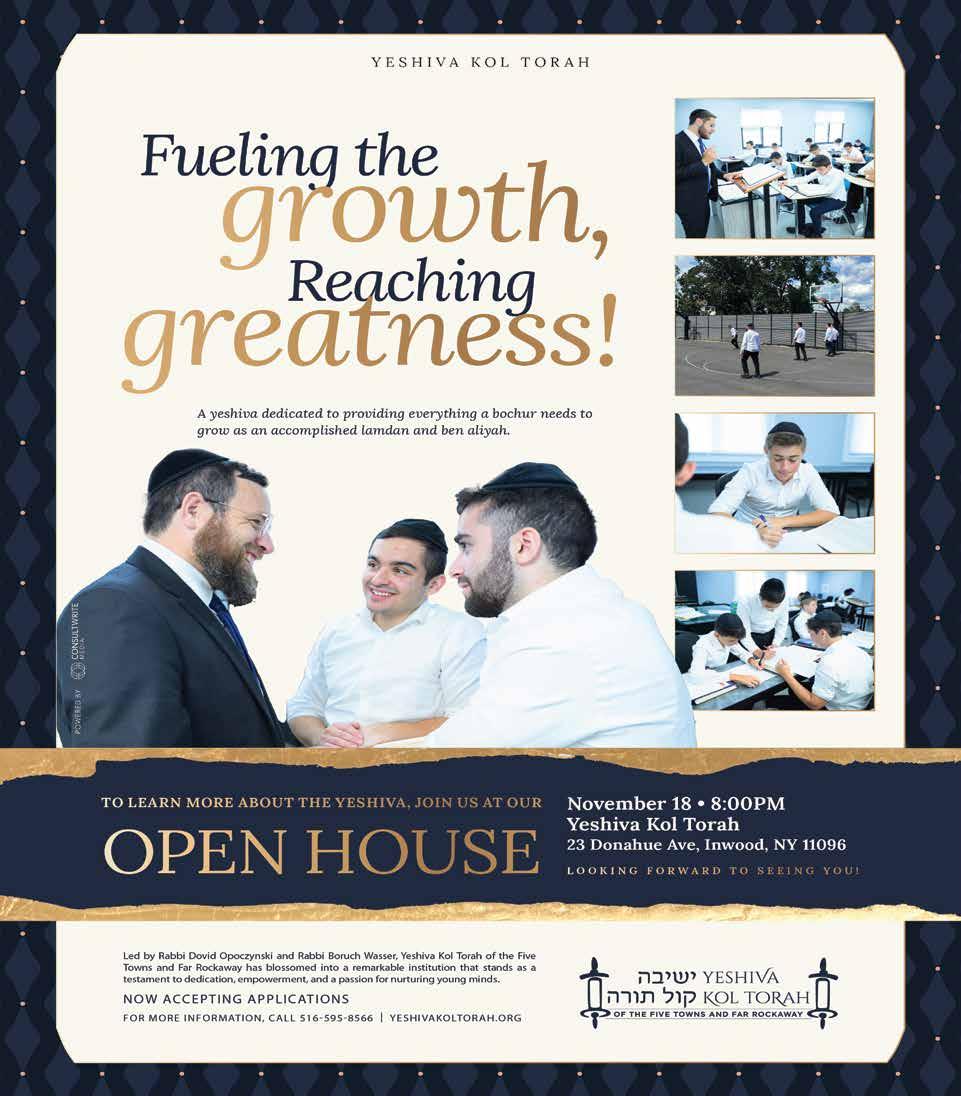

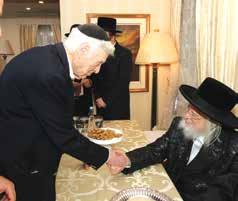



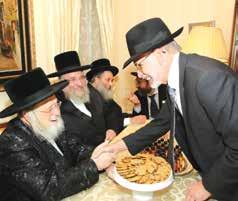



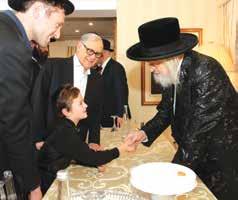

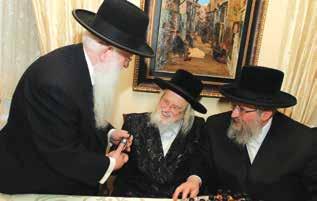



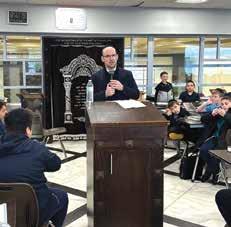
Yeshiva Darchei Torah’s Middle School welcomed a special speaker on a recent afternoon: Rabbi Baruch Rothman, the Yeshiva’s director of institutional advancement, who spoke about the importance of voting and civic participation. The students are too young to vote, but this engaging presentation enhanced their understanding of American democracy and our sacred obligation to participate in it.

Congresswoman Laura Gillen met with dozens of Long Island Holocaust Survivors at a Selfhelp Community Services “Coffee House” event last week at the Five Towns Premier Rehabilitation and Nursing Center in Woodmere. Survivors enjoyed a live performance of Yiddish music and a matzah-ball-soup-and-chicken lunch.
“Coffee House” events are a series of social gatherings hosted by Selfhelp’s Holocaust Survivor Program, which serves more than 4,000 Holocaust survivors in New York City and hundreds on Long Island. The Coffee Houses provide a warm and welcoming space

for Holocaust survivors to combat social isolation, share a meal and music, and celebrate life together.
The confluence this October of the High Holidays and a diplomatic breakthrough in Israel gave the event a special resonance. The month began with Yom Kippur, the holiest day on the Hebrew calendar, followed by a miraculous hostage deal that touched off relief, celebration, and deep reflection among Jewish communities worldwide. Against this emotional backdrop, dozens of survivors gathered for community, joy, and connection – a testament to survivors’ resilience.
Learning is always fun at Lev Chana! Students used Uno cards to play number and color games in


The fifth grade girls at HALB visited the Anne Frank Exhibit at the Center for Jewish History last week. They learned all about her life and legacy and the importance of remembering her story.


The Special Children’s Center was delighted to welcome Rabbi Shay Schachter and Rabbi Eliyahu Wolf and his wife from the Young Israel of Woodmere, who came to see the incredible work and heart that make the Center shine.
HAFTR first graders explored the world of cartography with Dita Carhart from the New-York Historical Society! Through hands-on activities, they learned how maps tell stories about places, people, and discovery. With curiosity and creativity, our young learners became mini mapmakers—connecting geography, history, and imagination in true HAFTR fashion!


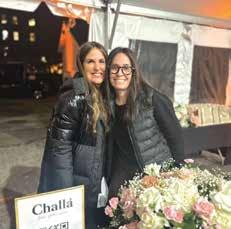

The Chabad Unity Challah Bake, A Time for Gratitude, was held last week, with hundreds of women attending. The crowd was uplifted by


The fall season for the 5 Towns Flag Football League wrapped up this past weekend, and what a week it was. On Playoff Friday, the teams battled until the final seconds, with many games decided by a hair’s breadth. Motzei Shabbos, under the lights at North Woodmere Park, hosted the semifinal and championship games, and they did not disappoint.
In the 2nd grade championship, the top-seeded Broncos were upset by the #2 Jets in a thrilling finish. Rabbi Heimlich claimed the memorable “SuperBowl” moment in 2nd grade, sealing a night to remember.
The 3rd and 4th grade championship featured the #4 Giants, coached by Rabbi Avi Webber, against the #3 Patriots coached by Yeruchum Brazil. The game was a back-and-forth showcase, as both teams struggled to contain the speedy

wide receivers. With the clock winding down, the Patriots, led by Yeruchum Brazil, finally found the end zone for the go-ahead score. Yeruchum’s win carried special meaning for him, marking a hard-won victory he had clearly chased all season.
In the 5th and 6th grade champion-




ship, the top-ranked Patriots met the #5 Eagles, with coaches Brill and Kramer both pouring their hearts into the season. The game stretched to four overtimes, and in the end the Vikings forced a three-and-out for the Patriots, then drove down the field to score the winning touchdown. The sheer exuberance from
the Viking players and Joey Kramer’s leadership was a sight to behold. Congratulations to all the winners, runners-up, and every participant in this year’s league. See you in the spring when 5 Towns Flag Football continues.


YOSS talmidim volunteering at the Mount Richmond Cemetery-Hebrew Free Burial Society

In honor of Parshas Lech Lecha, the Bais Yaakov Ateres Miriam Preschool had a great time pretending to go to Eretz Yisroel! We packed our suitcases, and we even had a camel ready for the journey. The girls went on a big imaginary trip to the land that Hashem promised to Avraham Avinu! Our tickets were stamped and we got our very own boarding passes. We are so proud to be Avraham Avinu’s superstar kinderlach!!!

Not even the pouring rain could keep our families away from a night of Torah, connection, and community! More than 400 parents and children came together last Thursday for the first HAFTR Family Learning Program of the year, led by our esteemed N-8 Mashgiach Ruchani, Rabbi Asher Klein.
The energy in the room was electric as families sat side by side learning Torah, enjoying delicious food, and winning exciting prizes. The ruach in the room was proof that at HAFTR, our love for Torah and togetherness shines no matter the weather.
We look forward to many more eve -

Great Neck Scholars Kollel members founder Steve Zuckerman, left, and Dr. Paul Brody, second from left, honored their rebbe, Rav Tzadok Froimowitz, shlita, second from right, on Sunday at The Pinnacle, on his 25th anniversary, at the 75th anniversary of Forest Hills’ Cong. Ahavath Sholom, where Rav Paysach Krohn, shlita,
(seated) and Rav Michael Rosensweig, shlita, (behind him) spoke glowingly of Rav Tzadok’s leadership of the landmark shul. Rav Froimowitz’s son-in-law, Rav Reuven Goldstein, shlita, (far right) now rav of Young Israel of Elkins Park, taught at the very same Kollel, housed in the Great Neck Synagogue, from 2008-2012.


nings filled with learning, laughter, and inspiration as our HAFTR family continues to grow in Torah and unity.

Shulamith ECC gathered in celebration as new mezuzos were placed on the newest preschool extension affectionately known as “mini

Shulamith.” Thank you to the Dreyfuss, Schwartz and Warner families and our own Morah Rachel for their generous donations.



On Thursday,

On a very rainy Thursday in October, close to 100 Yachad Alumni, young professionals, braved the weather and joined together to laugh out loud and eat great food. Dovi Neuberger brought laughter to a room full of people who remember their time working and volunteering to assist individuals with disabilities through Yachad. Yachad is like a family; they forever stick together!


Art is an important part of the day at HALB, giving students the opportunity to be creative and express themselves. From Lev Chana through eighth grade, students enjoy using their artistic talents!

The children of Gan Chamesh have been introduced to the school’s acclaimed Travelmania program. They received their passports and had them stamped at the passport office. Now they are ready to travel around the world and learn about the cultures, clothing,

languages and pastimes of particular countries. They will learn that Jewish people live all over the world, do mitzvot, learn Torah and go to shul just like we do.
What a wonderful way to explore Hashem’s beautiful world!
n honor of Parshas Lech Lecha, the yeladim in HANC’s Early Childhood Division in the Reinstein Family Campus in West Hempstead engaged in a week full of transportation exploration. The children learned about the different modes of transportation that exist and heard many stories about how we can move from one place to another. The teachers shared stories of how people traveled many years ago and the children discussed how that differed from how people travel today. Conversations then ensued about if you had to leave and take all of your belongings, what are the most important things that you would take. The answers were unbelievable!
The children were also very busy creating their own vehicles using large cardboard boxes, which included buses, trains, airplanes and even a submarine. Each class created their own vehicle by painting the box and then adding wheels, wings, and other details. The children had a delightful time crafting their vehicles and were amazed at the final products. “Traveling” in their newly crafted vehicles served as a fun way to utilize their creativity and imagine what they could observe out the windows, or under the water, as they travelled.
Transportation was also incorporated into the free playtime during the day.
Utilizing Magnitiles, Legos and wooden blocks, the children crafted their own vehicles, including cars, trains, ambulances, firetrucks, buses and airplanes. The children had a delightful time moving their vehicles all around the room.
The children also learned about the special Tefillah that we recite when traveling. Each child decorated their

own “Tefillat HaDerech” sign that they could bring home to their parents to hang in their cars. This would serve as a reminder that we can engage Hashem in everything we do and wherever we go with our families.
Another sensory activity to help the children experience walking through the wilderness was to paint their feet and then follow their footprints as they walked along a long piece of paper. This project not only illustrated how Avraham walked to Eretz Canaan, but it serves as a keepsake for the children so that in the future, they will see how tiny their feet were when they were in their three year old nursery class and can measure how much they have grown since then.
During their Parsha lessons, the morot emphasized that we are all Hashem’s children, and our numbers are great, just like the stars in the sky. The children then created a beautiful art project, including their own photograph and many sparkling stars above them in the night sky. The stars were created with stickers, star shapes that they cut out themselves, and glitter. Morah Trudy Rubinstein, EC Director, spoke with all of the children about how special each and every child is.



This week, Yeshiva Ketana of Long Island hosted our parent body at an eye-opening and informative technology awareness event. Our speakers, Rabbi Tzvi Krigsman, Rabbi Moshe Bamberger, and Mr. Ronnie Adjmi, spoke to a packed room of parents who were eager to hear, to be inspired and to make the necessary technology “upgrades” for their homes. It was a truly incredible evening!

In honor of autumn, Morah Shaina Braun’s nursery students at Yeshiva Darchei Torah learned about squirrels
Developing leadership among students at HANC’s Middle School is not a theoretical goal – it’s something that begins each morning the moment they arrive at school. As students enter the Reinstein Family Campus in West Hempstead, they head straight to the beautiful and expansive Rabbi Moshe Gottesman zt”l Beit Midrash to prepare for Shacharit.
Even though many of the students have not yet reached bar or bat mitzvah age, those who have already reached this milestone have embraced the responsibilities expected of Jewish adults. Among them, Dov Turk, Mikey Pollack, Jonathan Kalter and Noam Dreyfuss have volunteered to serve as gabbaim for the Middle School minyan, an honor and a leadership role that reflects both initiative and commitment.
“When we all daven together, it gives me a special connection to the minyan,” Dov shared. “Since I like being a leader, it’s meaningful to help make sure everything runs smoothly.”
Mikey added, “I like that I have a bigger part in the minyan. It’s amazing to see the smiles on everyone’s faces when I give them aliyot!”
Noam described his role as helping “run the davening, make sure everyone is participating, and ensure that any student who wants to take an active part in the tefillah has that opportunity.”
These young leaders also take responsibility for assigning leining, organizing special tefillot when a student celebrates his Hanachat Tefillin, and helping their peers learn how to put on tefillin properly, guiding younger students as they take their first steps
toward religious maturity. They also manage practical details like rolling the Torah and preparing it for Rosh Chodesh and other special readings.
This year’s minyan feels especially inspiring, as it is the first to take place in a fully dedicated Beit Midrash, complete with an Aron Kodesh, Bima, and Shtenders giving the students the sense that they are davening in a true shul environment. “It’s amazing having so much space, and we have everything we need for a geshmak davening every day,” Dov noted.
The Beit Midrash’s dedication in memory of Rabbi Moshe Gottesman, zt”l, a founding educational leader of HANC, adds even deeper meaning. “All the tefillot that take place here every day will bring him schar,” the boys reflected.
At HANC, opportunities like these are

not just about managing logistics, they are about living the school’s mission. By empowering students to lead with responsibility, empathy, and spiritual awareness, HANC nurtures the next generation of leaders of Am Yisrael, young men and women who understand that true leadership begins with service, humility, and connection to community and Torah.
Chai Lifeline, the Jewish community’s leading international children’s health and crisis support organization, will host its annual national gala on Tuesday, December 2, 2025, at Pier Sixty in New York City. The event will bring together hundreds of supporters, community leaders, and families to celebrate hope, resilience, and the transformative impact of Chai Lifeline’s services worldwide.
This year’s Gala will mark the establishment of The Martin Tropper Z”L Legacy Project, a visionary initiative honoring the memory of Martin Tropper. The
project will fuel the expansion and innovation of Chai Lifeline’s vital programs, ensuring the organization continues to meet the evolving needs of children and families confronting illness, crisis, and loss.
Chai Lifeline will also present the Maimonides Medical Achievement Award to Dr. Phillip B. Storm, Chief of the Division of Neurosurgery and Vice Chair of Clinical Affairs in the Department of Surgery at Children’s Hospital of Philadelphia. A world-renowned pediatric neurosurgeon, Dr. Storm’s groundbreaking work and compassionate care
have changed countless lives.
The evening will feature moving presentations, inspiring stories, a unique culinary experience, and unforgettable entertainment by Shulem Lemmer, Zusha, and Ekev.
The Gala is led by Campaign Chairs Bari and Dani Erber, and Lisa and Jonathan Schechter, alongside Gala Chairs Naomi and Chesky Newman, Lizzy and Michael Pinewski, and Ilana and Akiva Rudner. The Gala Committee includes Gloria and Matthew Ingber, Dina and Kami Kalaty, and Aliza and Josh Katz, whose leadership and dedication help
make this evening of healing and hope possible.
“Our mission is to open hearts by opening eyes,” shared Rabbi Simcha Scholar, CEO of Chai Lifeline. “When you see the world through the courage of our children, the resilience of our families, and the devotion of our volunteers and staff, you cannot help but be moved to action. This gala is more than a celebration. It is a call to ensure no child or family ever faces illness alone.”
For more information, tickets, or to make a donation, please visit Chaidinner.org.


The
at our
Gemara Mesiba. Hartzig
singing, divrei bracha, spirited dancing, proud parents and grandparents – it was a beautiful and nachas-filled morning!




Afull crowd of YOSS parents filled the Gluck Family Beis Medrash at Yeshiva of South Shore on Monday night to hear Rabbi Joey Haber speak about parenting in today’s world. Introduced by YOSS Rosh Yeshiva Rabbi Mordechai Kamenetzky, Rabbi Haber mixed warmth, humor, and straight talk as he mapped how chinuch has shifted over the decades and what children need now.
He began with unfolding the evolution of the four eras of Jewish parenting in America. In the 1950s and ‘60s, families focused on survival. In the ‘70s and ‘80s, many homes leaned on discipline. In the ‘90s and 2000s the message became “just love them.” But in the past 25 years, parents have to make sure that
their children know that we “get them.” Understanding alone is not enough. Anxiety, social pressure, and constant comparison are real. Parents should show empathy, yet keep clear standards. He told stories that had the audience laughing and nodding. A daughter begs for a sleepover and hears a calm no. A ninth grade girl misses the dance production and learns that disappointment is not the end. An eleven-year-old boy wants an advance on Chanukah money for Ninjago, and his father holds strong – teaching him that he can’t spend money he doesn’t have. All of us face similar situations every single day, and we have to balance the line of remaining strong, while showing understanding to our children.


He closed with the story of Dovid Hamelech and Golias. David trusted that he could save the Jewish nation and kill the giant only because he had already faced and defeated a lion and a bear, killing them both with a slingshot. “Chinuch,” Rabbi Haber said, “is not shielding our children from lions and bears. Rather, it’s giving our children a sling-


shot.” With love and guidance, we can instill in them confidence, so they believe they can kill the giants that come their way later in life.
A special thank you to Mrs. Rachel Fox and the outstanding PTA for working tirelessly to ensure the success of this most memorable and inspiring evening.

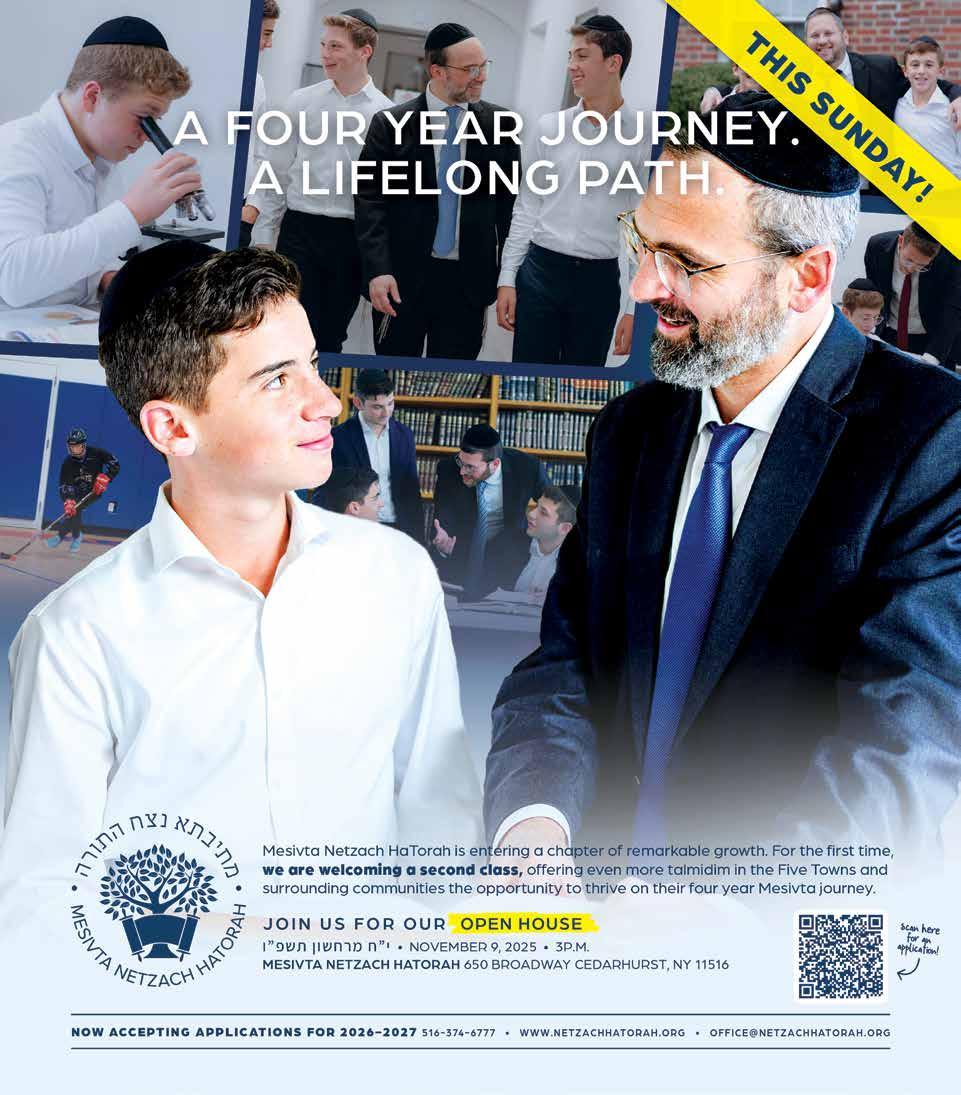
Mosaica Press, in collaboration with Touro University and its New York Medical College, has just released the third volume of “Medical Halachah Annual.” Building on the success of its first and second volumes, this edition delves deeper into the intricate interplay between traditional Jewish law and contemporary medical issues and focuses on questions of Jewish Law for physicians, patients and students.
Edited by Dr. Edward Lebovics, Professor of Medicine and Director of Gastroenterology at New York Medical College, the journal provides an enlightening exploration into the realms of halachah, medical ethics and modern medical challenges. This new volume highlights a range of perspectives on critical topics, including managing short term survival and reproductive issues, coping with cognitive and physical challenges, and health concerns in the Jewish community. Hot-button issues addressed include the impact of Ozempic/ Wegovy on brachos and bircas hamazon;
posthumous sperm retrieval; hashgacha for IVF; and halachic approaches to code status and DNR orders.
Managing editor for this 3rd volume is Rabbi Aviyam Levinson and the editorial board is comprised of Rabbi Baruch Fogel, Dr. Nachum Lebovics, Rabbi Dr. Zvi Loewy and Dr. Jonah (Yonah) Rubin.
“We are excited to present the third volume of the Touro University – New York Medical College Medical Halachah Annual,” said Dr. Lebovics. “This volume, featuring papers from leading rabbonim and physicians, seeks to tackle issues that challenge the foremost authorities in medical halachah. I am especially indebted to our contributing authors who invested great effort to present analyses of complex issues in a methodical, precise and sensitive manner.”
“We are confident that Jewish healthcare providers, patients, medical students, as well as the broad Torah readership will find this volume enlightening,” said Dr. Edward Lebovics, emphasizing the journal’s role in linking
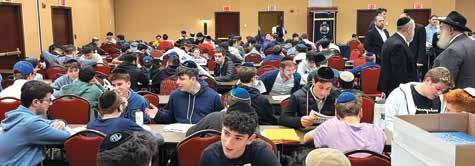
From the moment the first buses pulled out, excitement filled the air. The entire yeshiva came together for a weekend that captured what MTA is all about: connection, growth, and genuine achdus.
The theme of unity ran through every part of the Shabbaton. Friday morning’s Achdus Seder set the tone as talmidim from different grades learned b’chavrusa, forming new bonds through Torah. That spirit of togetherness continued throughout Shabbos in the inspiring divrei Torah of the menahel after Kabbalas Shabbos, the Rosh Yeshiva before Mussaf, and the principal by Shalosh Seudos, each highlighting what it means to be a community both as a klal
classic principles with modern medical and social concerns.
The contributors to this volume form a diverse and esteemed group of scholars and practitioners, offering a comprehensive and nuanced exploration of each topic. They include Dr. Jonah (Yonah) Rubin, Rabbi Shlomo Brody, PhD, Rabbi Dr. Jason Weiner, BCC, Rabbi Yona Reiss, Zvi Ryzman, Rabbi Chaim Jachter, Rabbi Akiva Willig, Dr. Sharon Galper Grossman, Dr. Edward C. Halperin, and many more.
“As the nation’s largest Jewishsponsored institution of higher learning that is a leader in health care education, we are proud to share such an important work with the Torah community and its medical professionals,” said Dr. Alan Kadish, Touro President.
The importance of this annual publication in facilitating crucial dialogue within the Jewish community is encapsulated by New York Medical College Chancellor and CEO, Dr. Edward C. Halperin, “Each generation must

engage in conversations to interpret its current ethical challenges, posed by new biomedical discoveries, in light of the timeless values and precepts of Jewish law. New York Medical College and Touro University are pleased to sponsor Medical Halachah Annual each year to contribute to these conversations.”
The Medical Halachah Annual is available for purchase at mosaicapress. com or at local Jewish bookstores.

and as a yeshiva bifrat.
We had the tremendous zechus of spending Shabbos with Harav Hershel Schachter shlit”a, whose warmth and insight elevated the entire experience. In an engaging Q&A, talmidim had the chance to ask questions and connect with a Gadol baTorah in a way that felt both personal and inspiring.
The ruach throughout Shabbos was electric. From spirited tefillos and heartfelt zemiros to the uplifting tisches, the energy was unstoppable. As Rabbi Sudwerts shared, “The ruach was igniting. The talmidim were on fire with a deep desire to connect and grow.” Everywhere you looked, rebbeim were learning and speaking with their talmidim, guiding
them with genuine care and sincerity.
The freshman class enjoyed a special experience of their own. They traveled up early on Thursday for bowling and team-building before joining the rest of the yeshiva. Together with their senior “Lions,” they took part in a creative challenge, designing and building boats from scratch that became one of the weekend’s highlights.
The Shabbaton was filled with memorable moments, from the Aquatopia trip and BBQ to the hike at Hornbeck’s Creek, flag football, swimming, and time to enjoy the beautiful campus. Shabbos was filled with meaning through powerful tefillah, grade discussions, freshman chaburos with alumni, and a legendary
tisch that lasted late into the night.
After an uplifting Shabbos, the yeshiva joined together for a heartfelt musical Havdalah followed by a Melava Malka that closed out the weekend on a high note. A special highlight was the presence of twelve alumni who joined for Shabbos, learning with the boys and reminding everyone that the bonds built at MTA last long after graduation.
The MTA Shabbaton was more than a weekend away. It was a living expression of what makes our yeshiva so special, a place where Torah, achdus, and ruach come together to create something truly unforgettable.


On Sunday, world-famous daf yomi maggid shiur Reb Eli Stefansky made his first visit back to his childhood yeshiva, Yeshiva Darchei Torah in Far Rockaway, in 44 years. Reb

Eli addressed the talmidim of the middle school, where he was introduced by Rav Yaakov Bender, Rosh HaYeshiva. Reb Eli inspired the boys with his life story and memories of Darchei Torah and showed
It was another electric week of JSL action, brought to you by FM Home Loans, featuring overtime thrillers, clutch goals, and statement performances from players across every division. The kids played their hearts out, and the men’s league brought the intensity as playoff seeding races began to take shape!
Smash House narrowly escaped with a 4–3 victory over Stand Out Care, led by Jack Schlessel, who poured in 3 goals and sacrificed his body with fearless, selfless play to earn Game MVP honors. Yeled LI Panthers rolled past Marciano PD 8–2, powered by Ami Horowitz’s pair of highlightreel goals and relentless effort. SD Shades took down Demo & Cleanouts in a well-played matchup, behind Shimmy Biegeleisen’s dominant 4-goal performance.
Maidenbaum bested Marciano 9–3 in an offensive showcase led by Tzvi Frankel, who was seemingly unstoppable—scoring at will and setting up his teammates throughout the game.
Posh Home & Bath won a highscoring 8–4 battle over 5 Towns Central, with Eliyahu Dancykier’s hustle and selfless play proving to be the difference. In an instant classic, SR Whee edged Tikva Fire 2–1, thanks to Pinny Newman’s heroic 2-goal effort.
2nd/3rd
Sushi Tokyo Ninjas held off a strong push from J Works Construction to earn a 6–4 victory, highlighted by Reuven Cooper’s lockdown defense and timely goal.
Built By Nate defeated Growtha 7–6 in a wild contest being dubbed the Game of the Week. Paysach Jacobowitz came up clutch with multiple goals, while Izzy Fried anchored the defense and made key saves down the stretch. Styles Design Interiors controlled play in a 4–1 win over Town Appliance, behind stellar goaltending from Yaakov Polansky. Newman Dental dominated NY Custom Closets 11–4, led by the dynamic duo of Harry Gertner and Shmulie Lazar, who combined for explosive offense.
4th/5th Grade Hockey
Styles Design Interiors defeated Tal Academy 4–2, with goalie Avi Krigsman standing on his head, making save after save to secure the win. Eden Gardens topped Smash House 11–6, behind a rock-solid performance in net from Yoni Singer. SR Whee pulled off a thrilling overtime win over J Works Construction! Ezra Donowitz tied the game with just 3 seconds left, before Shimmy Hersh scored the OT winner to seal the victory. In another unforgettable matchup, Extreme Vent Cleaning and Wieder Orthodontics battled to a dramatic shootout tie after backand-forth action all game. Ezra Levine’s endless hustle kept his team in it, while Tzvi Jarcaig and Zechariah Koegel delivered in the shootout, capping off a night of pure drama!
6th–8th Grade Hockey
Two heavyweights squared off as Emporio took down Town Appliance 5–1, with goalie Yosef Treuhaft putting on a masterclass between the pipes. Wieder Orthodontics defeated Sperling

them a picture of his first grade class and rebbi, Rav Moshe Mandel, who is still teaching first grade at the Yeshiva. An emotional reunion then took place in Rav Mandel’s classroom as rebbi and talmid
Productions 8–3, powered by the scoring duo of Yosef Bryks and Dovi Cohen. And in true record-breaking fashion, Gavriel Abbitan added to his highlight reel with 8 more goals, carrying SD Shades to a 12–8 win over Cachet.
1st Grade Basketball
Marciano PD impressed in a big win over Seasons, with Caleb Samuel delivering a highlight putback off a rebound. Growtha defeated Posh Home & Bath 6–2, thanks to Sol Berman’s lockdown defense in crunch time.
2nd Grade Basketball
Rip It rolled past Rita’s 14–6, led by Eli Lopiansky’s all-around effort—8 points and suffocating defense. Wieder Orthodontics, behind Ruby Wieder’s scoring touch, took down 5 Towns Landscaping in impressive fashion.
3rd Grade Basketball
Central Pizza Co. beat Elegant Lawns 12–4, with Nisi Berman’s defensive intensity setting the tone. Tikva Fire stayed hot as Dani Grabie erupted for 28 points(!) in a dominant win over Seasons.
4th/5th Grade Basketball
Newman Dental topped Wieder Orthodontics, powered by a memorable effort from Akiva Scharf and a deep three-pointer from Gavriel Jaffa that brought the crowd to its feet. Addictive Ads squeaked past Rip It 15–13, with Yitzy Kohn leading the way—scoring 10 points and locking down on defense when it mattered most.
6th/7th Grade Basketball
Elegant Lawns, playing shorthanded
reconnected and reminisced.
Rabbi Stefansky’s twice-daily daf yomi shiurim, broadcast from Ramat Bet Shemesh, reach 45,000 participants per day.

with only four players, pulled off the shocker of the season with a 29–28 win over Tal Academy—a performance fans won’t soon forget. Maidenbaum continued their winning ways, as Natan Seltzer’s 5 assists and team-first mentality helped guide them past Eden Gardens 37–20.
Men’s Basketball
Town Appliance took down Hewlett Auto Body 56–46, led by Effie Freundlicht’s 19-point performance. Kol Ve’or defeated Advantage PT 71–59, with Ari Ivry and Sami Mendel combining for 45 points to secure the win. Maidenbaum earned a hardfought victory over SR Whee, with Dovi Baratz, Adam Herman, and Jordan Appell all scoring in double digits. Emporio notched a solid win over Smash House, behind Yitzy Wieder’s 27 points and Zev Teitelbaum’s 25.


This past Monday, Harav Yitzchok Kolodetsky, shlita, visited Siach Yitzchok. The visit ended with singing and dancing

Tuesday, Election Day 2025, HAFTR Lower School students exercised their right to vote by deciding on different programs and initiatives in their grade and division such as what sort of treat they would want for their Rosh Chodesh Kislev snack. This sort of experience was fun and engaging for them, and they had fun figuring out what the school year will be like because of their input!


In celebration of Parshas Noach, Gesher hosted its annual petting zoo! The children had an amazing time meeting, feeding, and petting a variety of animals—just like in Noach’s teivah. From bunnies to goats, each animal brought smiles and excitement as the students learned about Hashem’s wonderful creations. It was a fun and memorable


Under the leadership of Reb Yitz Milworn, Director of Student Activities, Rambam Mesivta launched Club Hour. From Sports to
Mercaz Academy’s lunchroom was transformed into a kids’ dance fest on Sunday morning at the Early Childhood Center’s first open event of the year. Designed with the double goal of fostering school community and showcasing Mercaz’s warm, inclusive culture to new families currently deciding where to send their preschoolers next year, the event welcomed over 100 parents and children, many of them families new to Mercaz.
After a brief welcome from Principal Rabbi Kalman Fogel, kids’ fitness experts Kerboom Kidz led an exuberant and high-energy movement program. Incorporating Israeli music and dance, the program had nearly everyone on their feet, following along with the team leaders as they led the room through preschool-friendly moves and short routines culminating in, of course, a hora.
After their exercise, families enjoyed a pancake station, complete with toppings and fruit, and seated themselves around balloon-festooned tables to refresh and shmooze. Mercaz families introduced
themselves to potential newcomers and shared their experiences with the ECC program, which begins with a 2-yearold class and progresses through Pre-K. Following the brunch, ECC Director Joanne Mlotok and Rabbi Fogel took several new families on an informal tour of the school.
“The Mercaz Academy community feeling is very special, and I wanted new families to be able to really feel that, more than they could just from a tour,” explained Abra Kaplan, Mercaz Academy’s Director of Admissions and Communications. “Our ECC program is amazing in itself, but that sense of family is something you don’t find everywhere.”
The event not only highlighted the joy and energy of Mercaz’s youngest learners but also reinforced the school’s mission of creating a welcoming, nurturing learning environment where every child—and every family—is part of a diverse whole that learns, plays, and grows together.





This school year marks a pivotal moment for Bais Yaakov Ateres Miriam High School. We have begun our fourth year in a spacious new home on Irving Place in Woodmere, giving us ample room for four full grades. The high school now enjoys airy hallways and the space to welcome its largest class yet of 24 ninth graders. Our beautiful davening room infuses the start of the day with ruchnius while the sizable basketball court provides outdoor space and endless outlets for recreation. The new facility has truly transformed the BYAM high school experience.
This will be the year of many firsts as we prepare our inaugural class for graduation. We have begun a productive and exciting year ahead for our twelfth grade. On Monday November 3, we held our first seminary night, led by our seminary advisor, Mrs. Batsheva Schiff. Applying to seminary can be intimidating, to say the least! To ease that, parents had the opportunity to meet with representatives of 12 seminaries. The girls, as well as their parents, walked away with a wealth of information and the feeling that they will be supported through this wonderful yet formidable process. Mrs. Sokoloff, Menaheles of BYAM HS, and Mrs. Schiff, Limudei Kodesh teacher and grade 12 Mechaneches, both visited the seminaries to introduce our school and ascertain the best possible seminary for each student.
Academically and spiritually, BYAM HS continues to offer an outstanding and well-rounded program. Students can choose from a variety of engaging courses. These include Introduction to Engineering for advanced ninth-grade math students as well as Engineering in
Science in 12th grade, a Middos course in grade 10, as well as Art and Mishlei, Financial Literacy and Nutrition in grade 11. Nashim B’Tanach, Tefillah, Chovos ha Levovos, Statistics, Speech, Psych and many more. Each class is designed to challenge, inspire, and nurture the girls’ minds and hearts. BYAM HS is proud to offer an array of college credit courses amounting to a full year of college, giving students a head start on their academic future.
Senior year is enhanced by the inclusion of extra enrichment experiences. Mrs. Aliza Schwadel, director of programming for the 12th grade, has prepared an itinerary designed to promote growth – academically, personally, and as a Bas Yisrael. This well-rounded program will include trips, speakers and workshops all geared to the soon-to-be graduates.
The girls in the ninth and twelfth grades were excited to kick off the first ever BYAM HS Big Sister/Little Sister program with an engaging activity, coordinated by Mrs. Leah Schwartz, Dean of Students. The big sister and little sister pairs got to know one another while they made beautiful name bracelets for each other and enjoyed coffee and muffins.
Prospective families of grade 8 students are invited to learn more at the BYAM High School Open House on Tuesday, November 12 at 7:30 PM, held at the school’s new building: 111 Irving Place, Woodmere, NY 11598.
Bais Yaakov Ateres Miriam High School looks forward to welcoming the next generation of students as it continues to grow, inspire, and contribute to building the future of Bais Yaakov education in the community.


At Rambam, 25 students and faculty came together for the Rambam Writers’ Guild! Over 30 pages of original, creative works were written based off of the prompt: “You wake up on top of a building, and you don’t know how you got there.” Stories ranged from epic fantasies, to meditations on mortality, parenting, and Jewish diasporas. Senior Guilderbeast Rafi Taubenfeld and junior
Guilderbeast Bezalel Graber led the discussions and author reveals. Copies of last year’s Writers’ Guild publication, The Edgar Allan Prose, were also distributed and the young writers enjoyed the discussion and delicious Carlos and Gabby’s dinner.
Next month’s prompt is “The Locked Door.” Stay tuned for more stories!
This week, Mrs. Burg’s 3rd grade ELA class at Yeshiva of South Shore took writing to a whole new (and tasty) level! The students explored the art of sequencing through a fun popcorn-themed lesson that brought learning to life and filled the classroom with delicious aromas.
The activity began with a discussion about the process of popping popcorn. From tiny kernels, to sizzling heat, to the satisfying “pop,” and finally, the fluffy snack everyone loves. As the popcorn popped, the boys used their senses and imaginations to describe what they smelled and what it reminded them of.
Once the popcorn was ready, the class dove into a sensory writing exercise, describing the scent, taste, and texture of the popcorn, and even recalling memories that those sensations stirred up. By combining sequencing skills with sensory details, Mrs. Burg’s students discovered how real experiences can spark

Shulamith’s Early Childhood, located in the heart of Woodmere, opened its doors to the community for its much-anticipated Open House event. The response from parents was so overwhelming that it became “standing room only,” as families flocked to get a glimpse of the top-notch educational facility and innovative programs that the school offers.

great writing, proving that sometimes the best lessons are the ones you can see, smell, taste, and feel!
The event featured a presentation by Early Childhood Director, Mrs. Rachel Brier. She shared her vision for the school’s education program, emphasizing the importance of a well-rounded curriculum that combines academic growth with personal development. She spoke about the school’s commitment to fostering a nurturing and stimulating environment where young minds can flourish.
One enthusiastic parent, Mrs. Ruby Goldstein, shared her perspective on the school, lauding the institution for its commitment to fostering academic and social development. Mrs. Goldstein, whose three daughters are currently enrolled at Shulamith, spoke passionately about the enriching experience her children have at school.
Following the wonderful speeches and video, an informative panel discussion took place. Parents and attendees had the opportunity to ask questions and gain insights into the school’s philosophy, teaching methods, and extracurricular offerings.

One of the highlights of the event was the opportunity to tour the school’s classrooms and learning centers. Parents were given a firsthand look at the modern and progressive classrooms that offer children a multitude of ways to learn, play, and collaborate. The various centers for learning, creative play, and collaborative activities demonstrated the school’s commitment to fostering holistic development in its students.
If you missed this Open House event, don’t worry! Shulamith encourages interested parents to reach out for further information about the admissions process. Shulamith Early Childhood truly has captured the hearts of many parents and students in our community! Spaces are limited; early enrollment is recommended to secure a spot for your daughter. For more information, please reach out to admissions@shulamith.org.

The halls of the Yeshiva University High School for Girls (Central) were alive with energy and excitement on Sunday, November 2, as the school welcomed area families to its annual Open House. The event offered a firsthand look at the academic excellence and vibrant student life that define the Wildcat experience — as well as the school’s unique relationship with its parent institution, Yeshiva University.
A record-breaking number of guests attended this year’s event, which featured remarks from YUHSG administrators and YU officials, as well as a student life panel and gallery walk. Family sessions showcasing YUHSG’s academic departments, extracurricular programs, and signature initiatives also took center stage. But visitors most enjoyed encountering the distinctive blend of academic rigor, spiritual depth, and creative expression that defines daily life
at YUHSG as embodied by its students. Ambassadors from the classes of 2026, 2027, and 2028 filled the hallways, meeting prospective students and their families and accompanying groups on classroom tours. These wildcats are, after all, the best evidence of the unique warmth that defines YUHSG. Junior Jamie Blass, who gave the student address at the event’s welcome ceremony, spoke to the experience of being a YUHSG Wildcat: “The best part about getting involved at Central is that no matter what you are interested in, Central helps you make it happen,” she shared. “Since I started at Central, I have enjoyed every single moment – from the faculty to the friendship interactions, extracurricular activities, Israel advocacy, shabbatonim, and of course, my classes. Because of my incredible teachers, who also serve as role models, I am excited to go to class every day because I know that every time I enter
a classroom, I’ll leave with increased understanding, comprehension, and skill. Going to school is so much fun – but also filled with meaning, every day.”
The morning concluded with a curriculum fair, and an enthusiastic sendoff from the Wildcat community — a fitting end to an event that celebrated everything YUHSG stands for: a place where every student is known, every voice is valued, and every opportunity leads to growth.
Open House was just one of the many events dotting the post-holiday calendar at YUHSG. On October 23, Wildcats auditioned for the school’s first-ever Spring Production, a showcase of schoolwide student talent scheduled to take the stage in February. Students auditioned for a variety of categories including music, comedy, drama, dance, and even stage design and production. The week of October 27th was Pink Week
Join us for our Community Friendsgiving Event
From the moment AlignSmile Multispecialty Dental opened its doors, it stood apart — defined by creativity, compassion, and a commitment to excellence. Our team of highly experienced doctors delivers personalized care rarely seen in today’s fast-paced healthcare world. Every patient is treated like family, with every visit reflecting our belief that experience, empathy, and innovation belong together.
Our Vision
Led by Dr. Shaul Schwalb, a respected
community dentist with over 20 years of service to the greater New York area, AlignSmile is built on a simple philosophy: to provide high-tech dentistry in a warm, trusted, and friendly environment. Dentistry is built on trust — in skill, diagnosis, and care. From the moment patients walk in, they feel a genuine welcome, professional confidence, and a sense that they are truly understood.
AlignSmile blends old-fashioned personal care with cutting-edge


in honor of Breast Cancer Awareness Month at YUHSG, featuring special presentations, fundraisers, and writing to breast cancer patients . And there’s more to come. November 7-9 brings one of the most anticipated events on the YUHSG calendar – the school’s annual Shabbaton. This year’s Shabbaton, themed “Heart to Heart – Avodah She’ba’lev,” to speak to the year’s theme, “B’chol levavcha u’vchol nafshecha,” will take place at the Camelback Resort in Tannersville, Pennsylvania.
technology. Our digital 3D scanning and smile-design systems create a customized smile in less than 48 hours — from scan to design to treatment. Patients can say goodbye to messy impressions, long waits, and outdated methods. Treatment is faster, easier, and far more comfortable. Advanced Aligner Orthodontics
Our clear aligner technology offers gentle, predictable tooth movement with nearly invisible trays. Each tray is numbered for convenience, and replacements can be provided within 24 hours. No painful wires or endless adjustments — just comfort, precision, and affordable care from experienced doctors who live and work in your community.
• Dr. Shaul Schwalb – Director, General Dentistry & Aligner Orthodontics. A leader and innovator devoted to education and individualized care.
• Dr. Eric Nussbaum – Endodontist (Root Canal Specialist). Known for warmth, honesty, and helping even anxious patients feel at ease.
• Dr. Seth Maltz – Oral Surgeon. A board-certified specialist with years of surgical expertise, admired for precision and compassion.
• Dr. Malka Katz – General Dentistry.
Gentle, thorough, and committed to patient comfort.
Community Friendsgiving Celebration
Join us Sunday, November 9, from 12–4 PM for an afternoon of fun and smiles! Enjoy:
• Free beer, pretzels, popcorn, cotton candy, and great company
• Raffles and giveaways for all ages — including a raffle for a new Bamboo 3D printer!
• Complimentary consultations and intraoral scans with our doctors
• 20% off Invisalign and Aligner treatments started during the event
Bring your friends, kids, and smiles for an afternoon where fun, family, and world-class dentistry come together.
AlignSmile Multispecialty Dental — where experience meets innovation, and every smile tells a story.
Dr. Shaul Schwalb & AlignSmile Multispecialty Dental: 650 Central Avenue, Suite A, Cedarhurst, NY. Phone: 516-2182652 | Email: alignsmile650@gmail. com

By Rabbi Shlomo Landau
Thousands were gathered at the levayah of R’ Yoram Michael Abergel, a well-known tzaddik and mekubal who was niftar at a relatively young age. Suddenly, a man jumped the barriers surrounding the burial site, threw himself on the freshly formed mound, and began to sob uncontrollably. Almost immediately, another fellow pounced on the fellow lying on the grave, grabbed him, and physically removed him from the beis hakevaros.
Those in attendance were shocked and approached the fellow who had grabbed the Yid lying on the grave.
“What did you just do?! Why in the world did you throw that Yid out of the cemetery?”
The fellow responded, “Him? Do you know that for close to ten years this Yid has been publicly disparaging and humiliating R’ Yoram? He has absolutely no right to ever get near his kever!”
Later that day someone who had
witnessed the bizarre scene encountered the Yid who had thrown himself on the kever, and, sensing that there was more to the story than met the eye, he approached and asked him to explain his actions.
With tears in his eyes, the Yid shared a remarkable story.
“About ten years ago, I was an avreich in R’ Yoram’s kollel when I had a serious falling out with him. I left the kollel and felt slighted by the Rav. Since I’m a very passionate and vocal person, I began to publicly share my resentment toward the Rav. I’m ashamed to say this, but I was never able to let go, and I’ve been publicly bad-mouthing the Rav for almost ten years.
“When R’ Yoram was niftar, my wife approached me and told me that she intended to go to his levayah. I was furious! ‘How dare you go to the levayah of this man? You know very well how I feel about him!’
“Even so, my wife insisted. I became so enraged at her that I shouted that if she went to the levayah, then the very
next day I would meet her in beis din to give her a get
“At that point, my wife broke down and began to cry uncontrollably. ‘After you had a falling out with R’ Yoram and left his kollel, we lost our monthly stipend from the kollel and we had almost no money to live on. Things went from bad to worse and one day, unbeknownst to you, I went to visit R’ Yoram and I poured out my heart to him.
“‘R’ Yoram instructed me to secretly open a bank account and told me that going forward, he would deposit the monthly stipend even though you were no longer part of the kollel. Each and every month, for the last ten years without fail, R’ Yoram deposited the stipend in that account and enabled us to survive!
“‘Now you understand why I am so desperate to go to his levayah?!’”
The Yid began to sob. “I couldn’t believe my ears. Here, I had spent almost a decade disparaging the Rav, while he was selflessly taking care of me and my family.
“Instinctively, I raced out of my

home and ran to the Rav’s levayah. When I realized that he had already been buried, I jumped the barrier and threw myself on the freshly dug mound and began to beg R’ Yoram for mechilah !”
Reprinted from Flashes of Inspiration by Rabbi Shlomo Landau, with permission from the copyright holder, ArtScroll Mesorah Publications.
Many senior citizens may need the services of a nursing home or at-home care at some point in their life. You might assume that government assistance or health insurance will step in and cover the cost if you cannot afford these services. Unfortunately, neither health insurance nor Medicare covers long-term care. Because obtaining long-term care insurance can be very expensive, Medicaid could become your only option.
Medicaid coverage is not a given, however. If you have assets or recently transferred assets, Medicaid may determine you do not qualify for coverage until a certain amount of time has passed. If this happens, you and your family can face significant medical bills. If you cannot pay, nursing homes may take you to court to get reimbursed.
What steps can you take to avoid this? First, before applying for Medicaid, get a better understanding of the timelines in your state – known as lookback periods – that can affect your eligibility. Then you can engage in proper Medicaid or asset
protection planning in advance of these timeframes. A good age to begin planning is around age 65, although everyone’s situation is different.
Individual states run Medicaid programs, and every state has different rules regarding Medicaid eligibility. These programs were designed as a payor of last resort — in other words, to qualify, you must meet strict requirements. There are two primary types of Medicaid benefits: home care and skilled nursing home care.
You must submit an application to your local Medicaid office to qualify for these benefits. As part of this process, the state will look at any money or property you may have transferred within a certain lookback period.
These lookback periods can have serious consequences. If you have not engaged in appropriate asset protection planning, you may not be able to qualify for home care or nursing home care for many months. The result is that many elderly individuals must then spend down their savings and liquidate their
assets to pay privately for their home care before Medicaid starts covering anything. If a person no longer has resources and is subject to a disqualification penalty period, family members may have to step in and bear these costs on their own.
So, what can you do? The answer is to start planning as soon as is practical.
Speaking with an elder law attorney can help you and your loved ones explore options available to avoid you or them being personally responsible for the costs of your care.
Medicaid Asset Protection Trust — One common approach is placing assets in a Medicaid Asset Protection Trust. You may be able to use this to shelter various assets such as stock accounts, savings, a home with unprotected equity, and much more. Pooled Income Trust — Another option you may explore is contributing income that exceeds Medicaid allowances to a Pooled Income Trust. This can allow you to qualify for Medicaid while diverting excess income to a trust that pays qualified expenses on your behalf.
This will enable you to benefit from the income and not spend it on things Medicaid could have otherwise covered. Spousal Refusal — Your spouse may also have options that can help you qualify for Medicaid. One such option includes exercising a right of spousal refusal — a process by which the income and assets of your spouse can be removed from consideration in your Medicaid eligibility analysis. Finally, an attorney can help you understand if certain transfers are permissible under Medicaid rules without triggering a penalty period.
Without proper planning, individuals with assets and income exceeding specific state-set thresholds would have to spend this income and their assets on their care or exempt items before they can receive Medicaid benefits. For assistance in planning, consult with one of our elder law attorneys.
To learn how to protect you and your family visit www.haaszaltz.com or call 516-979-1060. You can also email them at info@haaszaltz.com.
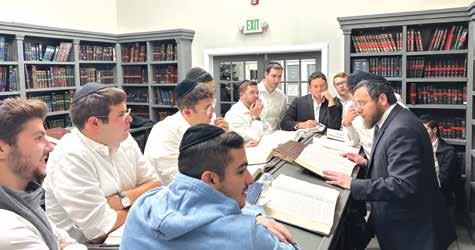


This past weekend’s Yeshiva Kol Torah Shabbaton upstate was truly uplifting. The atmosphere was filled with achdus, simcha, and ruach as our talmidim connected deeply with their rabbeim and one another. From inspiring tefillos to singing and shared moments of joy, it was a weekend of genuine warmth and unity — one that will leave a lasting impact.


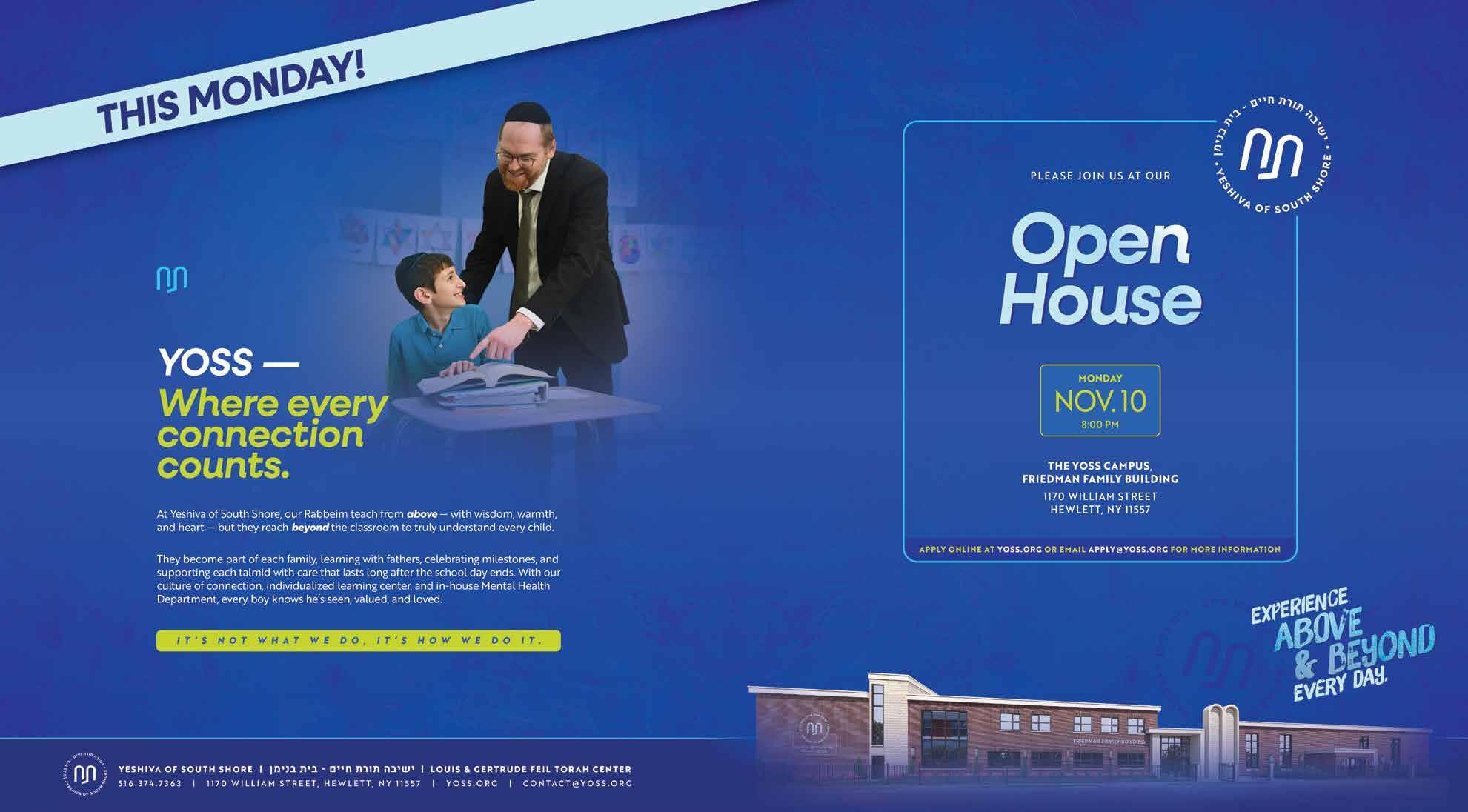


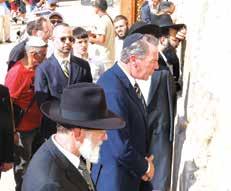
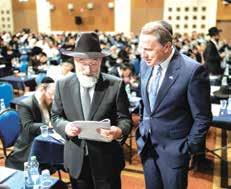

“FBy Chaim Gold
irst and foremost, we must call antisemitism by its name! We can’t let antisemites hide behind slogans and political terms. They must be called out. We also must be forceful in how we deal with hatred. It is not enough to just send off a tweet saying you condemn an attack on Jews. Attacks must be met with force. Whenever governments show weakness in combating hate, violence and hatred thrive.”
Those words were said with great passion by Ambassador Mark Walker, President Trump’s nominee for ambassador-at-large for International Religious Freedom, at a special panel discussion and meeting held on the sidelines of Dirshu’s massive cumulative test on Shas and Shulchan Aruch at the Binyanei Haumah Convention Center in Yerushalayim earlier this month. Mr. Walker is a former Republican Congressman from North Carolina.
Ambassador Walker visited Eretz Yisrael last week where he held a lengthy, productive meeting with HaGaon HaRav Moshe Hillel Hirsch, shlita, Rosh Yeshivas Slabodka. In addition, he visited the historic Dirshu testing site where he not only observed the test takers being tested on most of Shas and Shulchan Aruch but also participated in an important panel discussion on antisemitism and what to do about it, with Dirshu members from numerous countries. Dirshu members from Australia, England, Antwerp, Holland and the United States gave the ambassador firsthand reports about the rise of antisemitism in their respective
countries and what has changed in recent years. The Ambassador was accompanied by Dirshu’s Nasi, Rav Dovid Hofstedter, to Rav Hirsch’s house and to the Dirshu test. (See box for the opinion piece that appeared on Fox News following Mr. Walker’s visit to Eretz Yisrael.)
When Secularists and Progressives Sideline Religion
The Ambassador, who is a deeply religious man and understands the integral role that the Jewish nation plays in spreading morality and faith in the world, is deeply dedicated to combatting antisemitism and ensuring that not only should the Jewish nation survive physically and materially but also spiritually.
His visit to the Dirshu testing site and the time he spent conversing with Dirshu test takers and encouraging the further dedication of the young scholars to studying the Torah and its law was a testament to the esteem he has for the Jewish people and the light of scholarship that they bring to the world.
A highlight of his visit to Israel was the time he spent together with the venerated senior Rosh Yeshiva, Rav Moshe Hillel Hirsch in Rav Hirsch’s modest apartment in Bnei Brak.
After greeting each other warmly, Rav Moshe Hillel inquired about Mr. Walker’s background. Mr. Walker told the Rosh Yeshiva that his family were very religious Christians, and he had been raised in a strictly religious environment. Growing up, he was not allowed to watch television, go to the movies, listen to secular music, etc.
Rav Hofstedter then pointed out to
the Rosh Yeshiva that Mr. Walker has an interesting theory regarding the current proliferation of antisemitism.
What ensued was a fascinating discussion with Mr. Walker on antisemitism today and what can be done to combat it. The Ambassador maintained that when a society gets taken over by secularists and progressives, they try to sideline religion, thereby creating a void. Instead of being religious, they fill the void by making their “religion” hatred of religion and most prominently hatred of Jews, the Ambassador proposed.
When Rav Moshe Hillel asked Mr. Walker if the increase in antisemitism is because of the war in Gaza and constant headlines about Israel killing “innocent Palestinians,” Mr. Walker answered that the war just revealed what was already percolating beneath the surface. He maintained that this is why universities are such hotbeds of overt antisemitism. Secularism creates a void and the students then channel all their religious fervor into hatred of Jews, violence against Jews and campaigns to get rid of the Jews “From the river to the sea…”
Attending the Dirshu test at Binyanei Haumah afforded the Ambassador the opportunity to see the vibrancy of the Torah community in action and its dedication to consistent daily Torah learning. The Ambassador was deeply moved at the sight of so many scholars who dedicate hours each day to learning Torah and maintain that learning through constant review and test taking.
Rav Hofstedter saw the visit of
Ambassador Walker as more than just an opportunity to show the Ambassador the global reach of Dirshu. Perhaps just as importantly, he used the test as an opportunity for the Ambassador to hear directly from Dirshu participants who hail from countries across the globe about the antisemitism that they face on the ground in their respective countries as visibly religious Jews.
Indeed, it was a unique opportunity. In his opening remarks introducing Ambassador Walker, Rav Hofstedter told those assembled that the Ambassador has been appointed directly by President Trump and Secretary of State Marco Rubio to focus on international religious freedom with antisemitism being a primary focus. He will have a staff of over thirty people working in the State Department to monitor religious freedom and use the power and clout of the United States to encourage governments to actually address antisemitism in a practical way.
It was for that reason that Mr. Walker himself took advantage of the opportunity to hear directly from Dirshu members who live in various countries around the world.
The Recent Proliferation of Jew-Hatred R’ Yumi Rosenbaum, who heads Dirshu’s operations in Australia, told the Ambassador that he was born in Australia and has spent his life there.
“In the past forty years, I barely ever experienced any antisemitism until two years ago. In the last two years, there has been a tremendous change! The proPalestinian protests have been a catalyst
for open Jew hatred. A few months ago, our shul, Adas Yisrael, was burned down by young people with ties to Iranian agents. Although most Australians were horrified, there is a vocal minority that is violently antisemitic. It has reached a point where many are afraid to leave the Jewish neighborhood wearing our kippas and looking visibly Jewish! I feel a lot safer here in Jerusalem than in Melbourne,” Mr. Rosenbaum concluded. With great sensitivity, Mr. Walker responded, explaining that part of the problem is that the countries are afraid to deal with the problem head-on. They suffice with mealy mouth declarations against hate but don’t back up their rhetoric by dealing with those who break the law and punishing them….
Another Dirshu member who spoke about antisemitism was R’ Shmuel Halpern of Manchester. He said that on Yom Kippur of this year a shul in
Manchester was attacked and two Jews were killed.
“That shul is five houses away from the school that my children attend. It is less than a fifteen-minute walk from my house. The English government is not doing anything concrete. They hide behind platitudes such as ‘freedom to protest,’ thereby allowing the chaos to continue. Everyone knows that the Islamists may be officially protesting about Gaza but they mean all Jews. My children are afraid to go out in the streets. They are afraid of being attacked.
“Recently, the Israeli soccer team played here, and the government did not allow Israeli fans to attend the game ostensibly ‘for their protection.’ It is a very weak government,” R’ Shmuel continued, “that is not ready to stand up to its Islamic population and as a result anti-Jewish crimes are being committed all the time.”
Hofstedter
A Dirshu representative from Antwerp, R’ Chaim Tursch, explained that the gezeiros made by the Belgian government against shechita and milah were clearly antisemitic in nature. He also gave examples of how Jews are afraid to leave their neighborhoods in visibly Jewish clothing and are simply made to feel unwelcome, not just by their neighbors but by the government itself.
The Ambassador explained that there is a lot of work to do in England and all over Europe. He pointed out that he had just seen how a Jew was arrested and interrogated for hours by the British police for the crime of wearing a Magen David. Yes, he was the criminal just because he wore a Jewish symbol. They weren’t the criminals for their antisemitism!
Mr. Walker pointed out that President Trump’s approach is different than
most politicians. He is a President who demands results and isn’t afraid to use American power and threats to achieve those results. Mr. Walker gave specific examples of this. He then expressed his confidence that he will have the President’s ear as well as that of Marco Rubio, and that the American Government would undertake renewed efforts at fighting antisemitism and not tolerating it both in America and abroad.
In his concluding remarks, Mr. Walker thanked Rav Hofstedter for enabling him to get acquainted with Dirshu, commenting, “It is amazing what one man can do and how you have succeeded in encouraging the masses to devote time to daily Torah study which is the moral foundation of society!”
He pledged to do everything in his power to fight the scourge of antisemitism that is raging across the globe. Not just with words but with action!
Many of us who live in frum enclaves may not realize that we are living through a time of unprecedented overt Jew hatred. Antisemitism and even violent antisemitism have become mainstream. Although there has always been antisemitism, over the past eighty years, it was largely contained. It wasn’t socially acceptable to be an antisemite. Today, especially in the aftermath of October 7, antisemitism, both from the far left and the far right, has become acceptable, even normal. In Europe, it is dangerous to walk around in visibly Jewish attire. Jewish buildings are targets. Even in traditionally tolerant America, there is rampant antisemitism on campuses, and in many semimainstream media platforms. New York City is even poised to elect an antisemitic Islamist mayor.
A child of Holocaust survivors, Rav Dovid Hofstedter, Nasi of Dirshu, has been observing these developments with mounting alarm. He recently accompanied Mark Walker, President Donald Trump’s nominee for AmbassadorAt-Large for International Religious Freedom and a former
Republican congressman from North Carolina, on a trip to Eretz Yisrael where he met with Rav Moshe Hillel Hirsch and representatives of Jewish communities across the globe. Below are excerpts from an opinion piece that appeared on Fox News following Mr. Walker’s visit to Eretz Yisrael.
Eight decades after the Holocaust, “Never Again” has become a plea rather than a promise. How can it be that within the lifetime of survivors, the same toxic hatred is once again socially acceptable — shouted in the streets, trending online and rationalized by those who should know better?
We are living through one of the most dangerous moral moments in modern history. The world has seen the re-emergence of an ancient hatred that many thought had been buried forever. In America and across the West, antisemitism is not just rising — it is metastasizing. And if history has taught us anything, it’s that when antisemitism spreads unchecked, it doesn’t stop with the Jewish people. It threatens the very foundations of civilization itself.
We recently traveled together to Israel — one of us the son of Holocaust survivors who rebuilt his life by restoring Torah scholarship to the heights it reached
before the war; the other, the President’s nominee to serve as America’s next Ambassador-At-Large for International Religious Freedom. What we witnessed there, and what it revealed about this moment in time, should alarm the conscience of every person who values freedom and faith.
Across the Western world, Jews are once again afraid. In Paris, London, New York and Los Angeles, the scenes are hauntingly familiar. Jewish students conceal their identity on college campuses. Synagogues are guarded like military bases. Businesses are boycotted for having Jewish owners. Families whisper before sending their children to school.
We must confront a hard truth: when hatred of Jews is tolerated, it is not merely a Jewish problem. It is a civilizational crisis. Antisemitism is the world’s oldest hatred precisely because it is the most adaptable. It hides under new slogans, cloaks itself in political rhetoric and finds new justifications — but its essence is always the same: the denial of human dignity.
In Israel, at Yad Vashem, we saw what happens when humanity’s moral compass is lost. For Rabbi Hofstedter, whose parents survived that horror, it was a deeply personal moment — a reminder that evil can flourish when good people

stay silent.
That lesson came alive again that evening at a gathering of thousands of Torah scholars who devote their lives to mastering sacred texts. Watching them, we were reminded that light endures — but only when it is protected. The world cannot take for granted that moral light will burn forever. It must be tended, defended and rekindled by each generation. The same is true of freedom. This is why leadership matters. America’s voice — clear, principled and unapologetic — is needed now more than ever. We are proud to see a president and an administration that have made confronting antisemitism and defending religious liberty a central priority. The fight against hatred cannot be a talking point; it must be a policy imperative. Silence and neutrality are not options. History does not look kindly on those who stood by and watched.
Allowing antisemitism to grow unchecked is not just a threat to Jews; it is a threat to the moral survival of the free world. The hatred that begins with the Jews never ends there.
We know where this road leads. We’ve seen it before. The only question is whether we have the courage to stop it before history repeats itself. Faith demands it. Freedom depends on it. And civilization itself may hinge on it.
By Rabbi Yisroel Ephrati
Rav, Bais Medrash of Harborview
This Friday marks the first yahrtzeit of our rav, Harav Yehoshua Kalish, zt”l.
The Torah world lost an outstanding talmid chacham last year – a walking Shas, a Marbitz Torah at Yeshiva of Far Rockaway for over four decades, a renowned Daf Yomi Maggid Shiur, a giant in Torah and Halacha.
Yet, to our shul, the loss was even more profound. We lost our crown, our pride and joy, the leader of our Kehilla and mentor to our community.
Rabbi Yehoshua Kalish, zt”l, began his career in rabbonus as rav of Bais Medrash of Harborview, Lawrence, in the 1990s, and for the next three decades, he uninterruptedly served his congregants with love, dedication and compassion.
The Rav was always available and accessible to answer all shailos. He approached each shailah with a deep sensitivity towards the one who was asking and the unique circumstances of each situation.
The pasuk says regarding Moshe Rabbeinu’s descent from Har Sinai after Kabbolas HaTorah, “Vayeired Moshe min ha’har el ha’am.” The Meforshim explain that after Moshe spent 40 days and 40 nights learning Torah Mi’pi Hagevurah, one might think that Moshe Rabbeinu would find it difficult to descend from his towering spiritual heights to tend to the mundane needs of his people. However, that is precisely the gadlus of Moshe Rabbeinu, that although his mind, heart and soul were saturated with the deep and profound secrets of Torah, he was still able to lower himself to the level of the simple Yidden and care for them as a shepherd tends to his flock.
Our Rav was known as a master of the entire Shas, a baki in Shulchan Aruch, and a veteran lamdan, but he had the capability of explaining even the most complex and nuanced shailah in a crystal-clear manner to any man, woman or child.
Even though he was a tremendous masmid who didn’t waste a second, he was able to descend from his Torah heights to advise, counsel and assist anyone in need.
He was so “normal” and down to earth, it seemed as if he didn’t even know how special he was. Perhaps that’s what true gadlus is – not even realizing how great you are. He was genuinely humble. When

The scene of Rav Kalish holding the Sefer Torah and dancing like a young bachur, while his kehilla danced in a circle around him, gazing at him lovingly, will remain etched in our hearts forever.
The Rav was an adam ha’shaleim. He was wholesome; completely at peace with Hashem, with himself, and with others – exactly as the Maharal describes shleimus. It is therefore noteworthy that he was zocheh at the end of his life to achieve and be mashlim a special milestone. Just several weeks before his petirah, he printed his sefer, Pnei Levana. It’s a unique sefer, containing a chiddush on every single blatt in the entire Shas. He was full of gratitude
Even though he was a tremendous masmid who didn’t waste a second, he was able to descend from his Torah heights to advise, counsel and assist anyone in need.
you spoke to him, it was as if you were conversing with your best friend. His warmth and love were felt by all who encountered him. Yet we all knew and recognized that there was a Gadol in our midst.
Rabbi Kalish possessed a rare ahavas HaTorah. His face radiated with joy when he gave a shiur or spoke in learning. The very last yom tov that he spent with his kehilla was Simchas Torah. This was the day in which the mispallelim of the shul expressed their kavod and love to their rebbi.
to Hashem that he was able to complete and publish his work.
Rabbi Yehoshua Kalish was a descendant of the Pnei Yehoshua, his namesake. For most of his life, he had never been zocheh to visit his grandfather’s kever in Frankfurt, nor had he ever been to kivrei tzaddikim in Europe before. This was until two months before his passing (before he had any knowledge of his illness), when a group of thirty members from our shul invited him to lead us on a trip to the kivrei
tzaddikim in Poland and Germany. It was a special experience, a week of bonding and praying together, a rav and his kehilla unified as one.
Rav Kalish loved his kehilla and they loved him, and this mutual feeling was accentuated during that inspiring trip.
At the Pnei Yehoshua’s kever, the Rav was very emotional as he spoke of his connection to his grandfather and his Torah.
The Rav’s participation in the simchos of his bnei ha’kehilla was legendary. The way he danced with a chosson or a bar mitzvah boy, and the way he spoke at a simcha – all with such unadulterated ahavah. It felt as if it was the Rav’s own child’s simcha. That is because to the Rav every member of the kehilla was part of his mishpacha.
The Rav, zt”l, leaves behind his chashuva rebbetzin, his queen who always stood at his side giving him unwavering support so that he could learn and teach Torah. The beautiful Torah’dige family they raised is a testament to the unique chinuch they gave their children, who became well-known talmidei chachomim in their own right.
Their son, Rav Daniel Kalish, shlita, of Waterbury, is a world renowned mechanech and rebbi to thousands of talmidim. He and his siblings embody the Torah and middos, the values and virtues of their great father the Rav, zt”l, and, l’havdil bein chaim, the Rebbetzin.
It is hard to imagine that our beloved Rav’s seat is now empty and that we will no longer see his loving smile, but we know that he will certainly continue to serve us as a meilitz yosher in the Yeshiva Shel Ma’ala.
Yehi zichro baruch.
Azkarah and Siyum HaShas In Honor of the First Yahrzeit of our Rav, HaRav Yehoshua Kalish zt”l

Join us THIS MOTZEI SHABBOS, November 8th at 7:30 PM at Bais Medrash of Harborview, 214 Harborview South, Lawrence NY as we gather for the Rav’s first Yahrzeit.
WE WILL BE PRIVILEGED TO HEAR DIVREI ZIKARON FROM Rav Yisroel Ephrati
R’ Mayer Simcha Kalish
Rav Chaim Shlomo Metz
Rav Mordechai Willig
The evening will also include:
A Siyum HaShas l’kavod the Yahrzeit
A Siyum on Shisha Sidrei Mishna by R’ Moshe Kalish

This coming Shabbos, Parshas Vayeira, we will have the z’chus of welcoming the entire Kalish family to our Kehilla for Shabbos.
We will be privileged to hear shiurim and drashos throughout Shabbos from Rav Daniel Kalish shlita.
Wow, Wednesday morning was hard. Yes, it seems scary. But it’s important to put things into perspective.
The thing about elections is that everyone always says that this is “the most important election of our lifetime…” “This is the election that really is going to change everything…” “This time we really need to vote because if we don’t, our way of life will come under attack.”
The reason those lines always work is because it really does feel that way in each election. Inevitably, at some point during the election season, we question that sense – didn’t we say the same thing four years ago, eight years ago? But this anxiety is so smart that we always end up putting that thought aside by assuring ourselves that maybe we were overly concerned in the past, but this time, the concern is warranted.
But Mamdani….!
I get it; it is very scary. But we were also freaked out when de Blasio won.
But Mamdani hates…. Aha! This time my anxieties are validated!
I’m not poo-pooing the concern, but if we can zoom out and see the pattern, we may be able to put things into the proper perspective.
Let’s look back at the last twenty years in politics.
Believe it or not, everyone was freaked out about the possibility that John Kerry would defeat George W. Bush in the 2004 elections. (Hard to believe that now.) Looking back, if Kerry would have won, we would never have gotten stuck with Obama in 2008. You can play this game with every election. Think about Trump losing in 2020 – it was the best thing because had he won a second term, we would probably have a president by the name of AOC today. This is a very complicated jigsaw puzzle.
I can actually make an argument that Mamdani winning is a good thing. No, I’m not happy that he won. I wish we can ship him back to where he came from, but it’s

By Nate Davis

helpful to play devil’s advocate to the anxiety. Here’s the theory:
It’s no secret that there is a brewing civil war on the right whether to embrace Jew hatred or not. We see what’s going on with parasites like Tucker Carlson and
that can be used to challenge the anxiety. Obviously, it goes without saying that we don’t know what Hashem’s master plan is. Who knows? Maybe Mamdani will cause another Giuliani to be elected mayor in four years.
Besides, anyone who tries to predict politics anymore has had their face too deep in the popcorn bucket and has not really been paying attention to the movie.
Candace Owens. This is serious stuff; it’s not just fringe lunacy. Now, ask yourself how a bunch of radical Muslims winning elections in New York, Minnesota and Virginia plays into that. I’d argue that it weakens the Jew-hating wing of the right and will put the focus on the real threat, which is radical Islam. It will make it less palatable for people on the right to echo the beliefs of the very radicals that they are threatened the most by.
Again, this is just one little theory
One thing is certain, though. The rest of New York State who aren’t wacky New York City liberals are going to have their chance to vote against Mamdani in next year’s governor’s race. Gov. Kathy Hochul will be Republican Elise Stefanik’s opponent in name only; the real opponent will be Mamdani. Which means that Elise Stefanik will likely be the next governor of New York and the state legislature may flip as well. Who knows? Maybe they will lower our property taxes, while New York City is
“destroyed in order to be fixed.”
Maybe… Maybe… I acknowledge that I just engaged in the futile prognostication that I decried.
Besides, anyone who tries to predict politics anymore has had their face too deep in the popcorn bucket and has not really been paying attention to the movie. (Remember the current president of the United States being fingerprinted at a jailhouse in 2023…being convicted of a zillion bogus felonies less than a year before recapturing the White House?)
Well, if this whole thing is just a bunch of strings that are being pulled from above, why do we get involved in elections in the first place?
This is kind of similar to the age-old question of how can we have free will if G-d already knows what’s going to happen.
I once heard a beautiful perspective from Rabbi Pinson. He explains that when faced with a nisayon a person has to believe that they have free will and need to make the right choices. But once the nisayon has passed, regardless of how the person fared, they need to believe that ultimately whatever happened is because Hashem wanted it to happen.
It’s the same thing with elections. Before elections, we need to mobilize and vote, with every ounce of our energy. We must turn over every rock and find every vote. But once the election is over, we need to understand that whatever happened was exactly designed by Hashem, down to the very last vote.
By adapting this perspective and not focusing on “Mamdani this, Mamdani that,” we will be teaching our children a very valuable lesson about bitachon. So grab a TJH, open up the Centerfold, read an interesting article, and have a lively conversation with your family at the Shabbos table. You will be doing yourselves and your children a big favor.
Don’t waste your time on some punk who is just today’s puppet in this long and windy ever-unfolding Divine script.





Match the quote with the person who said it
1. If voting made any difference they wouldn’t let us do it.
2. The duty of a patriot is to protect his country from its government.
3. If you put the federal government in charge of the Sahara Desert, in five years, there’d be a shortage of sand.
4. Washington is a city of Southern efficiency and Northern charm.

5. I bet after seeing us, George Washington would sue us for calling him “father.”
6. You want a friend in Washington? Get a dog.
7. Being president is like running a cemetery: you’ve got a lot of people under you and nobody’s listening.
8. I have wondered at times what the Ten Commandments would have looked like if Moses had run them through the U.S. Congress.
9. You can lead a man to Congress, but you can’t make him think.
10. The marvel of all history is the patience with which men and women submit to burdens unnecessarily laid upon them by their governments.
A woman in a hot air balloon realized she was lost. She lowered altitude and spotted a man in a boat below. She shouted to him, “Excuse me, can you help me? I promised a friend I would meet him an hour ago, but I don’t know where I am.”
The man consulted his portable GPS and replied, “You’re in a hot air balloon approximately 30 feet above a ground elevation of 2,346 feet above sea level. You are 31 degrees, 14.97 minutes north latitude and 100 degrees, 49.09 minutes west longitude.”
She rolled her eyes and said, “You must be a Republican.”
“I am,” replied the man. “How did you know?”
“Well,” answered the balloonist, “everything you told me
A. Milton Berle
B. John F. Kennedy
C. Mark Twain
D. Will Rogers
E. Ronald Reagan
F. Thomas Paine
G. Bill Clinton
H. Milton Friedman
I. Harry S. Truman
J. George Washington
Answer Key: 1-C; 2-F; 3-H; 4-B; 5-D; 6-I; 7-G; 8-E; 9-A; 10-J
is technically correct, but I have no idea what to make of your information, and I’m still lost. Frankly, you’ve not been much help to me.”
The man smiled and responded, “You must be a Democrat.”

“I am,” replied the woman. “But how did you know?”
“Well,” said the man, “you don’t know where you are or where you’re going. You’ve risen to where you are due to a large quantity of hot air. You’ve made a promise that you have no idea how to keep, and now you expect me to solve your problem. You’re in exactly the same position you were in before we met, but somehow, now, it’s my fault.”
1. Which branch of government still gets paid during a shutdown?
a. Executive
b. Judicial
c. Legislative (Congress)
d. Anyone with a relative in HR
2. Since 1976, there have been 21 government shutdowns. During whose presidency was there the most shutdowns?
a. Bill Clinton
b. Jimmy Carter
c. Ronald Reagan
d. George W. Bush
3. The federal budget in 1965 was $121.5 billion. What is the 2025 federal budget?
a. $408.6 billion
b. $1.2 trillion
c. $3.8 trillion
d. $7.1 trillion
4. According to recent data, the average private sector salary is $100,465. What is the average federal employee’s salary?
a. $36,732
b. $45,388
c. $83,679
d. $106,462
5. A federal employee, let’s call him Michael, is furloughed because of this shutdown. Since he is off from work, he books a flight and goes to the Bahamas. He spends 10 days drinking martinis and having a blast. It happens to be that on his generous federal vacation package he just got back from a two-week trip in Aruba. But, since he can’t go into work, he might as well enjoy the sun a little more in a nice tropical climate. Plus, this trip won’t cost him any vacation days because he is “furloughed.” Is he being paid for the
time spent in the Bahamas?
a. Yes, but it will count towards his vacation days
b. Yes, but he will have to pay for his own martinis
c. No, of course, he is not being paid! Even though it’s not his fault that the government shut down, why in the world should taxpayers have to pay him for sipping martinis in Bermuda?!
6. Mount Rushmore National Memorial features sculptures of which four of the following presidents?
a. George Washington
b. Thomas Jefferson
c. John Adams
d. James Madison
e. Abraham Lincoln
f. Theodore Roosevelt
g. Franklin D. Roosevelt
h. John F. Kennedy
i. Jimmy Carter (ha…ha...ha)

six shutdowns during Jimmy Carter’s four years; eight during Ronald Reagan’s eight years; one for George H.W. Bush; and two for Bill Clinton. There was one for Barack Obama and three during Donald Trump’s tenure.
3) D- Total 2025 revenue is expected to be $5.23 trillion. Thus, the budget deficit will be $1.78 trillion. (And you thought that YOU overspend?)
4) D-According to the U.S. Bureau of Economic Analysis, the average federal salary is $106,462.
5) B- Sorry, Michael, that we can’t pay for your martinis. Despite their inability to agree on much, Republicans, Democrats and President Obama all agreed to legislation that all furloughed federal employees will be paid for their time out of work.

7. One of the tragedies of the government shutdown is that federal museums are closed. Want to guess how many times I went to the National Air and Space Museum as a child?
a. Every trip to Washington, D.C. as a child consisted of gawking at the White House and running around in circles at the Air & Space Museum. So, I would say at least 10+ times.
b. A is the only option to this question. Sorry...sometimes even the Centerfold Commissioner needs to vent. (Phew, I feel free right now!)
Answers:
1) C - Duh!
2) C- The first-ever government shutdown took place in 1976, during the Ford administration. There were
6) A, B, E, F-Mount Rushmore features 60-foot sculptures of the heads of four United States presidents: George Washington (1732–1799), Thomas Jefferson (1743–1826), Theodore Roosevelt (1858–1919) and Abraham Lincoln (1809–1865).
7) By the way, the bathroom toilet flushers are pedals (to mimic airplanes, I guess). I think all I did all day in the museum was run to the bathroom so I could push the pedal.
Wisdom Key:
5-7 correct: If you are a private sector employee, you are probably expecting me to say, “Congratulations, nice work.”
To you, I say that. If you are a federal employee, you are probably expecting a massive bonus for knowing all these answers. Sorry, the government is shut down, I can’t submit the bonus form.
3-4 correct: You are not bad, but you definitely don’t have a future on Mount Rushmore.
0-2 correct: Sometimes, the loser is the winner—some things you are better off not knowing.



By Rabbi Berel Wein z”l
Sacrificing one’s own son was undoubtedly the supreme test of Avraham’s life and faith. When Avraham and Yitzchak come down from the mountain of Moriah, their lives and the destiny of the Jewish people were changed forever. The Akeidah remains the central story of Jewish history and destiny. Its grim reminder of Jewish vulnerability has never departed from the people of Israel. Though we have survived the myriad periods of Akeidah in our history, it has always been with great
cost and almost always some sort of permanent trauma.
Why G-d demanded that test from Avraham and why it is continuously still demanded of the Jewish people is a question that has no real answer. It is, however, a situation that remains a stark fact of life and an ever-present reality, its inscrutability notwithstanding. We will see in later parshiyos of the Torah how strongly Yitzchak remains affected by his near-death experience. It governs his personality and makes him to us the


most inscrutable of all the Avos of the Jewish people.
Surviving the Akeidah takes an enormous toll on one’s soul and psyche. And as the rabbis teach us, the occurrences in the lives of the Avos are harbingers of the future of their descendants, as the Akeidah has certainly become an oft repeated theme in Jewish history. We should not be pessimistic about our present situation and our future. But we should certainly be realistic and wary as to what difficulties certainly face us now and later.
There are two witnesses to part of
the Torah as being warlike and constantly dissatisfied, has been amply justified in human history. It is not the character of someone who has experienced an Akeidah. Yishmael is willing to be the hero of the Akeidah but not to suffer its experience and trauma.
Eliezer will play an important role in the life of Yitzchak. He is the person entrusted by Avraham to find the proper mate for Yitzchak, and he performs his task flawlessly. But then he somehow disappears from the scene of biblical history and the story of the Jewish people. There is a lack of continuity in
Surviving the Akeidah takes an enormous toll on one’s soul and psyche.
the Akeidah drama – Yishmael and Eliezer. Their impressions of the event are not related to us by the Torah itself. Yishmael will remain the antagonist of Yitzchak and his descendants until our very own time. The descendants of Yishmael will even attempt to substitute their ancestor Yishmael for Yitzchak as the central character of the drama of the Akeidah. However, the history of the descendants of Yishmael does not conform to the pattern of historical Akeidot. Yishmael remains the aggressor in history, and his character, as delineated in
Eliezer and his descendants that does not allow him or them to remain any longer an integral part of the Jewish story. Thus, the two other participants in the Akeidah story depart from the mountain of Moriah unchanged by the event. Apparently, immortality and eternity in Jewish history is gained only by experiencing the Akeidah itself. Not necessarily a pleasant thought, but it is a proven reality.
May the L-rd test us with Akeidot no longer.
Shabbat shalom.


By Rav Moshe Weinberger
Adapted for publication by Binyomin Wolf
After Avraham passes the most unspeakable test, the near-slaughter of his beloved son Yitzchak, Hashem told him (Bereishis 22:16-17), “By Myself I swore, says Hashem, that because you have done this thing, and you have not withheld your son, your only one, I will surely bless you and I will surely multiply your offspring like the stars of the Heavens and like the sand on the seashore, and your offspring will inherit the gates of their enemies.” With these words, according to the Ramban, Hashem clearly and unequivocally promised Avraham that regardless of any sins the Jewish people may commit throughout the generations, exile will pass and they will eventually see the ultimate redemption.
If we look carefully at the words of these pesukim in light of the Ramban, however, we see two general paths toward redemption: one in which we are compared to “the stars of the Heavens,” and another in which we are compared to “the sand on the seashore.” What is the qualitative difference between these two paths?
Rav Ezriel Tauber, building upon a beautiful Kli Yakar (on ibid.) explains the significance of “the stars of the Heavens.” Each star represents an individual power, unique in its ability to add light to the universe, as the pasuk says regarding the stars (Yeshayahu 40:26), “Who takes out their host by number, all of them He calls by name…” By giving each star a name, Hashem shows that each one contributes something unique and different from all other stars. But with all of their individuality, the stars are called “the hosts of Heaven” (ibid. 34:4). The stars join together to form “hosts – armies.” They work together to fulfill a communal purpose. The stars also “work” with one another to form constellations to consti-

tute part of the organized forces at work in the universe.
Stars therefore represent the ideal combination of individuality and communal responsibility in which each star’s individual identity shines in a completely unique way, while, at the same time, it plays its part in a host or constellation to do its part in the big picture. This represents the ideal Jewish life as we march toward redemption – every Jew maximizing his or her own unique talents and strengths while also using the force multiplier of national unity to work together toward our collective goal of revealing G-dliness on earth.
The Gemara (Sanhedrin 98a), quoting the pasuk in Yeshayahu (60:22), says that Moshiach can come at the set time for redemption (“in its time”) or earlier (“I will hasten it”). In the latter path toward redemption, we are compared to the stars in Heaven. When Moshiach comes this way, Hashem says (Daniel 7:13), “He was like a man coming on the clouds of Heaven.”
That is what Hashem was referring to when he told Avraham after the Akeidah,
“I will surely multiply your offspring like the stars of the Heavens.”
But there is another, more difficult, path to redemption – the way of “I will surely multiply your offspring like…the sand on the seashore.” Sand ostensibly lacks the characteristics of individuality and joining together for communal work. Grains of sand lack any discernable individual qualities. They all look identical. In addition, they do not gather together in anything comparable to constellations, teams, armies, or communities. Even in halacha (Shulchan Aruch Orach Chaim, 321), one cannot violate the prohibition of kneading by mixing sand and water because sand physically cannot be formed into dough. A beach is just a collection of billions of individual grains of sand. They appear not to form any whole greater than the sum of their parts. But if this is the case, how is the promise that Hashem will make Avraham’s descendants like the sand on the seashore a blessing?
The Kli Yakar says that the sand has a vital purpose, as the pasuk (Yirmiyahu
5:22) says, “I have placed the sand as the boundary to the sea.” He says, “The nations rise up against the Jewish people to destroy them, but they cannot overcome them. Similarly, the waves rise up as if they want to wash away the world. But when they reach the sand, they are immediately broken just like the nations of the world, as the pasuk (Tehillim 42:8) says, ‘All Your breakers and your waves passed over me.’” The sand is the border the sea cannot cross.
So, too, the Jewish people are the world’s last line of defense against the forces seeking to destroy it. On a physical level, the Western world seems poised to succumb to radical Islam, though it seeks to infiltrate and destroy everything. The Jewish people – personified by Israel – seems to be the only nation willing to unapologetically stand up against extremist Muslims.
So although each grain of sand seems not to be unique or to have a unified purpose, the Jewish people, who are compared to the sand on the seashore, do serve a vital purpose. They are the world’s last hope against the forces of chaos and destruction!
And even on the spiritual plane as well, we remain the lone defenders of the health and normalcy of the world.
The Gemara (Sanhedrin 98a) says that in the way of redemption called “in its time,” the Navi (Zechariah 9:9) says that Moshiach will come like a poor man riding on a donkey, chamor, not on a cloud. The Maharal, zt”l, explains, based on the fact that the Hebrew word for physicality, chamriyus, shares the same root as the word for donkey, that Moshiach riding on a donkey means that he “rides” – exerts control over – physicality.
Rashi (on Shemos 4:20) says that Avraham rode the same donkey on which
Moshiach will arrive. Avraham also exerted mastery over physicality when he separated himself from physicality by saying to Yishmael (Bereishis 22:5), “Stay here with the donkey.” Avraham was showing us that he would not be bowed by or subject to the waves of physicality that attempt to drown us.
It is not only the Muslim world that attempts to conquer the world. The infinite physicality, smallness, and decadence available on the Internet threaten to wash away our humanity. And it is available on a phone that sits in a person’s pocket all the time, every day. It calls out to every single individual, whether great or small.
Each one of us, each grain of sand, stands together as a fortification against the onslaught of the physicality of the world that attempts to drown us. As each individual surfs the ocean-like web, he stares down the crest of each wave of “viral” videos, movies, and mindless entertainment over and over again. And just like the sand on the seashore acts as a line of defense preventing the ocean from overtaking the land, so too each of us must remain ever vigilant in keeping physicality in its place. We must use it while not being used by it. When we do
that, we protect the whole world from being overtaken by mindless materialism. Sitting alone in one’s house late at night, each person is like Avraham, confronting the whole world, personified by his phone or computer, alone.
It appears that it is not G-d’s will for us to live like “the stars of the Heavens” at this time. We simply do not have national, communal leaders with influence over the entire Jewish nation today. We therefore cannot fully fulfill a star-like role, illuminating the world with our individual light and working together as a team to accomplish national goals. It seems that Hashem’s providence has decreed that, for now, we act as a bulkhead, protecting the world’s shore from the progressive invasion of a flood of impure images and sounds. If Hashem tasked each of us with creating an oasis of health, moderation, and normalcy amidst the flood of insanity churning around us, it must be He also gave us an inner reservoir of strength and resilience to enable us to succeed – not to be overcome.
Because of all of the distractions whirling around us, it is so difficult to connect to true, sincere, and holy feelings of closeness with G-d. But that is what we seek. How are we to maintain
our focus in what often feels like a battle against the world when we cannot even strengthen ourselves by successfully feeling connected to Hashem?
Rebbe Nosson wrote a series of letters to his son to strengthen him during a period in his life when he was facing numerous spiritual and physical challenges. In one of these letters, he gives us tremendous encouragement in our struggle. He says, quoting a pasuk from this week’s parsha, as follows (Michtavei Moharnat p. 117):
“And he was sitting at the entrance of the tent in the heat of the day…” (Bereishis 18:1). “Sitting, yosheiv,” implies waiting and staying for a long time, like it says (Devarim 1:46), “And they dwelled, v’teishvu, in Kadesh for many days.” In other words, a person only merits a revelation of G-dliness, the aspect of, “And Hashem appeared to him” (Bereishis 18:1), by sitting and waiting and stationing himself by the doorway of the tent of holiness for a long time. And even though during this time he endures what he endures, and the heat of the day, meaning that all of the desires which burn him greatly, he never abandons his place, G-d forbid. Instead, he sits and waits by the door for a very long time, [like Avraham
who] “was sitting at the entrance of the tent in the heat of the day.”
Rebbe Nosson is teaching us that he understands that it is hard to maintain the fight against impurity and guard our thoughts and eyes day after day. But he also shows us that if we hold the line, if we maintain a boundary beyond which the lasciviousness of the world cannot pass, we will merit “And Hashem appeared to him.” By disregarding the fact that the world seems to have abdicated any sense of boundaries or self-respect, we maintain our post, keeping watch by the doorway of the tent of holiness.
In the merit of each act of vigilance and holiness by our people to maintain our guard against the waves of materialism that crash against us again and again, may Hashem reveal His anointed one. By holding off the waves of physicality, we exhibit our mastery over it and thereby reveal Moshiach’s donkey on which he will come riding into Yerushalayim, may he arrive soon in our days.
Rav Moshe Weinberger, shlita, is the founding Morah d’Asrah of Congreagation Aish Kodesh in Woodmere, NY, and serves as leader of the new mechina Emek HaMelech.



By Rabbi Avrohom Sebrow
The following story takes place in an unincorporated community named Cracker Jack, located in Carroll Township, Washington County, Pennsylvania.
It’s the afternoon of Erev Pesach. The chametz has been burned, the sale of chametz completed, and the aroma of brisket fills the air.
Meanwhile, Boruch has just heard the good news — his dear friend Shimon is in town for Pesach, visiting his in-laws. Delighted, Boruch sets out to greet him.
When Shimon opens the door, he’s holding a snack that looks suspiciously like...Cracker Jack. Worse still — he’s munching away!
Boruch freezes. His eyes widen. His mouth drops open.
And then, in a burst of pure friendship, he yells: “Sheigetz! Chametz!”
Shimon (confused): Huh?
Boruch: You’re eating popcorn — which is kitniyos! Don’t play innocent! Rebbe Yochanan ben Nuri, a Tanna, already ruled that rice — the most famous kind of kitniyos — is treated like grain! It can even become chametz, and you could make matzah from it! (Pesachim 35a).
Shimon: Easy there, Boruch! Rav Huna ate cooked rice on Pesach. Clearly, we don’t follow Rebbe Yochanan ben Nuri.
Boruch: True, but maybe some Rishonim still forbid kitniyos!
Shimon: Not Rabbeinu Yerucham! He said those who avoid rice and other kitniyos on Pesach are following a minhag shtus, a foolish custom!
Boruch: Yet Rabbeinu Peretz disagrees. He admits the halacha allows kitniyos but says there’s an ancient minhag not to eat
it and that we shouldn’t dismiss it lightly.
Shimon: Still, the Shulchan Aruch rules clearly that one may eat kitniyos on Pesach.
Boruch: And the Rema rules clearly that one may not. You’re an Ashkenazi, and I assume your custom is to follow the Rema.
Shimon: Well, my in-laws are Sephardim, and they eat kitniyos. I heard that Rav Yitzchok Berkowitz, shlit”a, said I can eat by them, so what’s the problem?
Boruch: Ah, I’m familiar with that psak, but it’s about utensils, not eating actual kitniyos. Here’s the exact wording of his response:
“Can an Ashkenazi eat at a Sephardi house on Pesach if the Sephardi serves no kitniyos but uses keilim/kitchen where kitniyos were cooked? What if it’s a family seder? Should one try to decline the invitation?
Rav Y. Berkowitz replied: M’ikkar hadin, it is muttar. Regarding this, we were not noheig to be mekabel the chumra of kitniyos in utensils. It’s a contemporary stringency. If you have a reason to go, you may be lenient. No need to get out of the invitation.”
Shimon: You know, I have this feeling that this conversation is supposed to connect to the daf. We’re learning Zevachim, and the Gemara (48b) says: “We never find that something secondary is more stringent than the principal.” Tell me, Boruch, do you eat matzah?
Boruch: Of course!
Shimon: But it’s chametz! It’s made from the five grains!
Boruch: Don’t be ridiculous. Once water comes into contact with flour, it can become chametz, but we ensure it doesn’t.
Shimon: What if water never touched

the grain kernel?
Boruch: Then it can’t be chametz. Shimon: Exactly. So if grain that never touched water isn’t chametz, why should air-popped popcorn be forbidden? It’s just dry kernels that were heated! You’re telling me you’re stricter about a secondary minhag like kitniyos than about real wheat grain?
Boruch: If you’re so logical, maybe you think you can make matzah from rice flour, too? Mix it with water, bake it in under eighteen minutes, would that be kosher l’Pesach?
Shimon: Who says it isn’t? The great Gaon, Rav Shlomo Kluger, says you can eat rice matzah on Pesach just not for the mitzvah!
Boruch: I’ve never seen anyone do it.
Shimon: That doesn’t mean it’s forbidden. Moreover, if there is a custom not to, it’s probably just to prevent confusion. People might mistake rice wafers for authentic matzah, which fulfills the mitzvah. People might also mistake rice flour for wheat flour.
But popcorn? No one’s confusing that with anything! It’s obviously not grain.
Boruch: I seem to recall that the Maamar Mordechai agreed with your reasoning in principle but warned that permitting some forms of kitniyos could be a slippery slope. Did any modern posek actually allow popcorn?
Shimon: Not popcorn specifically. But Rav Yehoshua Pfeffer ruled that roasted pumpkin seeds are fine as long as they
weren’t cooked in water.
Boruch: That’s ridiculous. Pumpkin seeds aren’t even kitniyos!
Shimon: Well, Rav Moshe Feinstein, zt”l, held they aren’t but Rav Shlomo Zalman Auerbach zt”l held that they are. Rav Pfeffer followed Rav Shlomo Zalman’s opinion yet still ruled that roasted pumpkin seeds are permitted. He said explicitly that we do not need to follow the chumra of the Maamar Mordechai. Perhaps he would permit popcorn, too.
Boruch: And the peanuts in your snack?
Shimon: Also roasted, not cooked — same as popcorn. Besides, Rav Moshe Feinstein wrote that peanuts aren’t kitniyos at all and can be eaten in places where the custom doesn’t forbid them. There’s no prevailing custom here in Cracker Jack, PA.
Boruch: Alright. Maybe you’re not a sheigetz after all.
Shimon (grinning): And by the way, the Kovetz Halachos says we stop eating chametz four seasonal hours into the day, but kitniyos can be eaten until sunset! So I wasn’t a sheigetz for that reason either! So, Boruch...would you like some Cracker Jack?
Boruch: What?! You think I’m a sheigetz?!
Rabbi Avrohom Sebrow is a rebbe at Yeshiva Ateres Shimon in Far Rockaway. In addition, Rabbi Sebrow leads a daf yomi chaburah at Eitz Chayim of Dogwood Park in West Hempstead, NY. He can be contacted at ASebrow@gmail.com.
By Rabbi Yair Hoffman
Picture a non-observant young man with his entire life ahead of him.
Nachal lives in Teverya with his father, mother and two brothers. He engages in water activities and has a girlfriend.
Nachal discovers, however, that his girlfriend is not Jewish. It bothers him slightly but not that much.
Teverya is one of the four holiest of cities in Judaism alongside Jerusalem, Tzfas, and Hebron. It has a Kollel located in the Nof Kinneret section.
The 43 avreichim of Kollel M’tzur Dvash not only study Torah day and night, but they also engage in kiruv rechokim twice each week. The Kollel was launched by the well-known talmid chochom Rav Asher Breslauer, shlita, at the behest of both Rav Chaim Kanievsky, zt”l, and Rav Gershon Edelstein, zt”l.
Nachal’s two younger brothers had become baalei teshuva through the kiruv rechokim program. He too was feeling the desire to make the plunge.
But, alas, Nachal had that other issue going on. He attended three full learning sessions and could no longer hold out. He told the Kollel avreich who was studying with him: “Rabbi, I cannot do both. I can commit to breaking up with her, or I can commit to observing Shabbos. Which option should I pick? I will do whichever one you recommend.”
The avreich posed the question to his Rosh Kollel. Rav Asher Breslauer posed the question to Rav Chaim Kanievsky, zt”l.
Before we get to Rav Chaim’s answer, let’s explore the two sides of the issue. On the one hand, it is recognized that one of the greatest challenges to Klal Yisroel in modern times is that of Jewish intermarriage.
According to the 2020 Pew Report on Jewry in the United States, the intermarriage rate among all U.S. Jews who were married between the years 2010 and 2020 is 61%. Among the non-Orthodox and

non-affiliated Jews, it is even higher, an astounding 72%.
And then there is the apathy. Only 34% of American Jews, according to the report, said it is very important that their grandchildren are Jewish. This, too, is very concerning. Marriage to a non-Jew entirely stops Jewish continuity.
On the other hand, Shabbos has always been viewed as the symbol or flag of the Jewish nation. Just as patriots look at their flag as more than a mere dyed cloth with fancy designs, so, too, is Shabbos viewed in the eyes of the Jewish people. It is a sign of our deep belief in Hashem’s absolute Oneness – He created the world and all that is in it, He is the One and Only, the source of everything, the One who rewards good and punishes evil. Ein od milvado.
Many years ago, Menachem Begin spoke in the Knesset in an attempt to pass legislation that would forbid El Al from flying on Shabbos. These were his words to the members of the Knesset in parliament at that time (not the most observant or traditional of Jews):
“Forty years ago, I returned from exile to Eretz Yisrael. Engraved in my memory still are the lives of millions of Jews, simple, ordinary folk, eking out a livelihood in that forlorn Diaspora where the storms
of antisemitism raged. They were not permitted to work on the Christian day of rest, and they refused to work on their day of rest.
“For they lived by the commandment, ‘Remember the Sabbath day to keep it holy.’ So each week, they forswore two whole days of hard-won bread. This meant destitution for many. But they would not desecrate the Sabbath day.
“Shabbos is one of the loftiest values in all of humanity; it originated with us. It is all ours. No other civilization in history knew of a day of rest. Ancient Egypt had a great culture whose treasures are on view to this day, yet the Egypt of antiquity did not know of a day of rest. The Greeks of old excelled in philosophy and the arts, yet they did not know of a day of rest. Rome established mighty empires and instituted a system of law still relevant to this day, yet they did not know of a day of rest. Neither did the civilizations of Assyria, Babylon, Persia, India, China – none of them knew of a day of rest.”
“One nation alone sanctified the Shabbat, a small nation, the nation that heard the voice at Sinai, ‘so that your man-servant and your maid-servant may rest as well as you.’ Ours was the nation that enthroned Shabbos as sovereign Queen.”
“So, are we in our own reborn Jewish state to allow our blue-and-white El Al planes to fly to and fro as if broadcasting to the world that there is no Shabbos in Israel? Should we, who by faith and tradition heard the commandment at Sinai, now deliver a message to all and sundry through our blue-and-white El Al planes – ‘No, don’t remember the Sabbath day. Forget the Sabbath day! Desecrate the Sabbath day.’
“I shudder at the thought.”
These words were very eloquent, but do they trump the very idea of risking Jewish continuity?
In the mid 1500’s, Rav Shlomo Alkebetz, zt”l, lived in one of the other four of the holiest of Jewish cities – Tzfas, or Safed in its anglicized form. He wrote the following words, describing Shabbos, “Ki hi mekor habracha.Shabbos is the source of all blessing.”
The Chofetz Chaim understood these words in the most literal of senses and would often advise people who were struggling with various issues to look at where in their lives they can enhance their Shabbos observance.
Rav Chaim answered the Rosh Kollel’s question by telling him that Nachal should be told to keep Shabbos. What was his rationale? It was not expressed.
What was the end result? Nachal did commit to Shabbos observance. He began studying even more. Now, all three brothers study vigorously twice each week with the avreich.
Eventually, Nachal himself realized the importance of Shabbos and his Torah heritage and broke up with his non-Jewish girlfriend. Perhaps this was the cheshbon of Rav Chaim, zt”l.
Last night, at our dear friend’s second grandchild wedding in a week, I learned something new. In the charedi community, depending on affordability factors, kallahs rent a sheitel for the night of the simcha so not to ruin her brand new, custom, very expensive one.
I don’t know if this was true for this particular kallah , but she glowed and her “hair” was stylish and elegant. There are all kinds of loopholes and customs surrounding this practice and, in my clueless world, something I know very little about.
The venue for the wedding was in Beitar, about 20 minutes outside of Jerusalem (with traffic, it can be up to an hour or more), traversing multiple roundabouts (what are roundabouts?), asking anyone who will respond where the venue can possibly be (thankfully there were some helpful boys waiting for a bus), around a random bend, and down a very steep incline to find the separate men’s and women’s entrances.
You know you have arrived when you see boys in suits running and playing in the very complicated hills and valleys of the parking lot. There are ample spots available for parking because Israelis know better than to come at the designated time (on time) for a wedding.
The wedding ceremony was held outdoors in a steep valley with a photographer’s drone flying within your view. It’s awesome and distracting to sit high above in the Jerusalem hills, overlooking its magnificence, with a drone capturing it all.
When the second wave of guests arrive as you are leaving, you get stuck; cars filled with second-wave guests are arriving as you are departing. Maneuvering the traffic in this parking lot takes savlanut (as does almost everything in Israel) and an advanced degree in driving and parking.
At a recent family bar mitzvah, the star, the bar mitzvah boy himself, accidentally got his face bloodied during horseplay. There were American and

By Barbara Deutsch

Israeli Hatzalah members examining his torn and bleeding lips and face. His American uncle recommended stitches for the gaping hole located on his inner lip; his Israeli Hatzalah cousin looked at the wound, shrugged his shoulders, and pronounced it fine.
His mom worried that her magnificent bar mitzvah boy wouldn’t look good in the pictures.
Our friend came home from shul last Shabbos to find that the cholent had gone missing: the pot, the contents, everything. He called out to his wife, questioning if she had somehow forgotten to make cholent – she makes a particularly delicious one which the whole family looks forward to eating.
“Of course, I made cholent! I even put in extra meat for all of our family.”
“Well, it’s gone,” her husband responded.
“That’s impossible, I remember peeling and cutting the potatoes and even putting in extra meat,” his frustrated wife answered.
“It’s not here!” he said.
“Do you mean to say that someone actually came into our house and took
the cholent?”
In Israel, it is not unusual to keep doors open on Shabbat but stealing a cholent, and nothing more, does go against the norm.
The cholent story made the rounds in the neighborhood; luckily, its “theft” was caught on a surveillance camera across the street. A guy in jeans, a white towel covering his head, is seen coming out of a nearby mikvah. We can see him opening the door to the “cholent’s” house, walking in, and coming out with the pot as he slithered away.
This Shabbos, the door was locked and a sign on the door said, “No cholent here.”
To pass the time and bond with my daughter Rachel, we take a studio ceramics class together every Tuesday. It’s a fun and creative way to build decorative objects that are useful and “could” turn out beautiful. The problem with working with clay is that there is no guarantee that the objects will survive the process.
We try to enjoy lunch together after the class. Walking home this week after a delicious meal at Cafe Rimon – hard
work builds appetite – we passed a store on Ben Yehudah Street where Bob and I had bought loads of gifts. The owner, I don’t even know his name, was standing outside; he nodded and called out from across the way, “Regards to your husband.” I shrugged and responded, “He died.”
It was really not nice of me. This particular proprietor is such a great guy; we had bought multiple presents from him at a discount because he liked us. During the war, we bought dozens of hostage name tags for HANC, my former school, students. His business has suffered from the complications of Corona, war and now the construction of the Light Rail. Bob and I wanted to support his business because he never complained and always greeted us with a broad smile.
His warmth was sincere, and my flippancy was cruel. I will go back and apologize; he did not deserve it. People ask me if I have a network to rely on in Israel. Yes, yes, yes; I have a website. It’s been a challenge to get comfortable with new routines and find my place as a single. My caring family/friends reach out to me every day, sometimes multiple times, to see how I’m doing. Depending on the emotional temperature of the day, I respond or ignore messages and calls.
Please keep writing and calling.
As you can see, life in Israel, like clay, is filled with built in ups and downs. The downs can be brutal, but the ups are good. A successful ceramics project, despite the fragility of the medium, has the potential to turn out to be a thing of beauty.
Barbara Deutsch is the former associate principal at HANC, middle school principal at Kushner, and Dean of Students at Yeshiva of Flatbush. A not-retired educator, she is trying to figure out life in Israel through reflections on navigating the dream of aliyah as a wife, mother, grandmother, great-grandmother and friend.


By Aron Schoenfeld

Yesterday marked my 60th day of miluim after 15 days of basic training. That’s 75 days helping Israel defend itself against those trying to destroy us. It also means 60 days away from family, 60 days on the Gaza border with constant threats, and 60 days running supplies in and out of Gaza.
And I had it easy.
Many soldiers on my base have served 500, 600, even 700 days since the war started. They go long stretches before seeing their families, never knowing when they’ll return home.
After 75 days, I’ve learned things I couldn’t have understood before putting on the uniform. Here are seven lessons from reserve duty that changed how I see everything.
Service is a Privilege, Not a Burden
Every Israeli male at 18 is required
to draft. Women can volunteer. But requirement doesn’t mean it’s routine. Kids in Israel train for years trying to get into specialty units. Getting into these units and wearing the uniform is a privilege. If you don’t honor it and serve correctly, you’ll be asked to leave.
I’ve watched people who thought they were doing the army a favor get shown the door. You don’t fully understand this until the first time you sing Hatikva in uniform, until the first mission you’re assigned. These moments carry weight that goes beyond obligation.
The Real Heroes Are at Home Being in the army was easy for me. I wasn’t in a combat role, but even so: three meals a day, same comfortable clothing every day, downtime with friends. The routine is simple. No errands. No kids to manage. No work calls to answer.
The wives at home, or in some cases the dads acting as both parents, face the harder battle. Every carpool, shopping trip, and meal needs to be planned and executed by one person with no help. They didn’t sign up for this. They don’t want this. But without these people holding down the fort at home, soldiers can’t function with a clear mind.
Our Soldiers Won’t Stop Until the Job Is Done
Many keep going with miluim because the job isn’t complete. They won’t rest until all hostages are freed. They keep joining other units when released, helping bring remaining bodies home, ensuring Israel’s long-term security. Many work during downtime on base, pulling long hours to make sure both the army and home are taken care of. They focus on the mission. They put themselves in harm’s way day after day, ready
to make the ultimate sacrifice if needed. The public speakers and influencers aren’t the heroes. The people on the ground are.
Going back and forth between civilian and military life creates chaos. You’re never fully present anywhere. Projects at home sit unfinished. Even when you’re home, you’re always ready to leave. A few weeks ago on Sukkos, we were driving to a family trip when I got called back to base within three hours. We turned around. Cancelled everything. I grabbed my gear and ran back, not knowing when I’d return. This creates havoc with schedules, planning, and expectations. The mentality is hard to break, creating real problems for soldiers when they try to slip back into normal life.
Whether you’re 18, a 27-year-old who just made aliyah, or 45 and never served before, the army needs you. You never hear people saying they want to be a chef in the army or deliver supplies. But the army needs these people just as much as combat soldiers.
Fixing tanks and armored vehicles. Delivering gear and supplies to bases. Base rabbi. Communications. Logistics. Fitness instructors. These roles matter just as much and are needed for the army to function. Out of every eight soldiers, one serves in combat and seven provide support. The army finds a role and place for everyone.
This war has fundamentally changed how the army works with donors. The army’s policy used to be simple: no donations, no people on bases. During wartime, the army opened its doors.
Food deliveries and BBQs happen almost daily. Donors tour war-torn areas and visit bases. Units accept equipment from private donors. Every unit set up a wish list. Every soldier reached out to
family abroad.
Hundreds of thousands of bags of gear arrived: boots, helmets, ceramic plates, vests, scopes, winter gear. The IDF views this as part of procurement now. This will be here to stay. Donors are part of the IDF, whether they know it or not.
The army is full of bureaucracy. Everything requires multiple levels of ap -
But the entire time, others came asking if they could go in to get them. Fighting for approval. Fighting for the opportunity to help. That mentality, one for all, overrides all the bureaucracy. It’s what allows us to succeed.
After 75 days, I understand something most people will never grasp from the outside: every soldier serving today is holding the line not just with their
Going back and forth between civilian and military life creates chaos.
proval. Things move slowly. But despite all that, the people are what make the army go.
When a truck with five guys from my unit broke down in Gaza, it took six hours to get approval to extract them.

They’re ordinary people who understand that walking away means leaving their brothers and sisters exposed. They’re fathers who know their kids need them home but also know those same kids need a country to grow up in.
This war changed how the army operates because survival demanded it. When you support a miluim family or donate equipment, you’re not giving charity. You’re shouldering part of the burden so that a soldier can keep going. You become part of the chain that lets them focus on the mission.
The job isn’t done. The hostages aren’t all home. So the soldiers keep going. When a father serves in the IDF, his entire family serves alongside him. And when we support them, we all serve together.
body, but with their family’s sacrifice. Every wife managing alone. Every kid missing their parent. Every business left behind.
The reserve soldiers serving 500, 600, 700 days aren’t superhuman.
Aron Schoenfeld, who grew up in Woodmere, enlisted in the IDF this year at age 44 and serves in a logistics unit supporting operations near Gaza. To support reserve soldiers and their families, visit SmilesforChayalim.com





By Hershel Lieber
The Stuchiner Rebbe, Rav Yehuda (Yidele), was a descendent of the Ropshitzer Rebbe, Rav Naft ali Tzvi. His great-grandfather was Rav Eliezer of Dzikov, the son of the Ropshitzer. His grandfather was Rav Moshe of Rozvadov and his father was Rav Yitzchok (Itzikel) of Stuchin. The Rebbe spent the war years in Siberia where he suffered immensely. When he arrived in the United States, he revived the chas sidus that his father headed in prewar Poland. He was known as a great baal tefilla and was known for his deep insights on kabbalah. He was niftar in 5742 (1981).


When I was about six years old, our family moved from Williamsburg to Boro Park.
We rented the first floor at 1324 49th Street, just off 13th Avenue. It was a
daven, the Bais Hamedrash of the Stuchiner Rebbe.
The shul was on 50th Street, just off 13th Avenue, very close to our home. The makeup of the mispallelim were
The Yomim Noraim tefillos were especially rousing and what particularly stands out was Simchas Torah, when he danced at the end of each kappitel of Hallel and during the subsequent kaddish.
nice-sized apartment with three bedrooms in a frame house with a wraparound porch. My father, a”h, found himself a very comfortable place to
Yidden with a similar background, namely originating from Galicia, Poland. Most of them had a connection to the dynasties of Rebbes who were
descended from the Ropshitzer Rebbe, although there were quite a few who were Belzer chassidim.
The Stuchiner Rebbe himself was a descendant of the Ropshitzer Rebbe (his father, Rav Itzikel, was the son of Rav Moshe of Rozvadov, son of Rav Eliezer of Dzikov, son of the Ropshitzer). The minhagim, niggunim, nusach tefillos, as well as the Galicianer Yiddish of the whole oilem were basically alike. Their sense of humor and even the type of food that they enjoyed were a reflection of their common tradition. In short, this shul and its Rebbe was a perfect place for my family to plant their roots.

davening, the singing and even listening to the conversations between my father and his friends attracted me to Stuchin.
The way I remember the Rebbe was that he was a bit reserved, meaning that he was not visibly warm. He was accessible, yet in many ways he cherished his privacy. He davened in a secluded study adjoining the beis medrash with the door open, except during the shtille Shemoneh Esrei when he closed the door. He had a beautiful voice, so that when he davened as the shliach tzibbur or sang, he inspired the entire tzibbur. Most niggunim were from his grandfather, Rav Moshele of Rozvadov, and their ancestors. The Yomim Noraim tefillos were especially rousing and what particularly stands out was Simchas Torah, when he danced at the end of each kappitel of Hallel and during the subsequent kaddish
Throughout the winter months, I would escort my father to the Friday night tishen, which were complemented by beautiful Shabbos zemiros. Shalosh seudos was conducted in the dark, and the songs were mostly melancholic. I would seat myself on a bench which extended beyond the table but was right near the Rebbe. This way, I was in a good position always to get sherayim. The Rebbe would say Torah at the seudah, much of it based on Kabbalah and beyond my understanding. He would begin his vort based on the thoughts of his father or other forbearers and then add his own novel ideas.
Like most children, going to shul offered me an opportunity to meet, talk and play with children of my age. That definitely played a great role in my desire to go to shul. Yet, the Rebbe, the
My father became the gabbai of the shul for a period of two or three years. During that time, both my brother Yossi and I felt that we were special. Not a small honor it was, being the sons on the gabbai! We were proud when we saw our father standing at the bimah and heard him give out and announce the aliyos. In addition, my father was the official kugel cutter at the weekly Shabbos kiddush. The Rebbetzin would send down a foot-wide and a foot-tall

During those years, my father started to daven at the Bluzhever Rebbe, and he developed a lifetime relationship with the Rebbe. About nine months after my
Yossi and I were luckier than everyone else, in that our father would covertly give us an extra piece of kugel while he was slicing it for the Rebbe.
salt and pepper lukshen kugel. This was given to my father at the kiddush table. He would cut it in half and then cut each half into many slices. This was passed on to the Rebbe who dished out the slices onto paper plates and gave them out to the oilem. But Yossi and I were luckier than everyone else, in that our father would covertly give us an extra piece of kugel while he was slicing it for the Rebbe. I can still smell the aroma of the crusty, oily, and well-seasoned kugel and can still imagine the taste in my mouth.
Although my father was close with the Stuchiner Rebbe, he felt a special connection to the Rebbe’s brother-inlaw, the Bluzhever Rebbe. After coming to the United States in 1947, we resided in Williamsburg for about five years.
bar mitzvah, which was about a year after the Bluzhever Rebbe moved to Boro Park, we made a permanent move to his beis medrash.
About five years after my father was niftar, in the early seventies, our family went up for the summer to a bungalow
colony in Harris, N.Y. I found out that the Stuchiner Rebbe was staying at a nearby colony. One Shabbos morning, I mustered some courage and made my way to his shul. It was over ten years since I davened in his shul. I reintroduced myself, and he said to me, “A son of Mechel Lieber is probably a good baal tefillah” and asked me to daven Shacharis. He thanked me afterwards and gave me some sherayim at the kiddush. After that Shabbos morning, I went a number of times to the Rebbe with a kvittel, participated occasionally at his tish, and went annually to the Simchas Torah hakafos. Interestingly, the Rebbe was niftar fifteen years later on the very day of my father’s yahrtzeit, the ninth of Cheshvan. Forty-eight years after my father was niftar, that solemn day also became the yahrtzeit of my mother, a”h.
Hershel Lieber has been involved in kiruv activities for over 30 years. As a founding member of the Vaad L’Hatzolas Nidchei Yisroel he has traveled with his wife, Pesi, to the Soviet Union during the harsh years of the Communist regimes to advance Yiddishkeit. He has spearheaded a yeshiva in the city of Kishinev that had 12 successful years with many students making Torah their way of life. In Poland, he lectured in the summers at the Ronald S. Lauder Foundation camp for nearly 30 years. He still travels to Warsaw every year – since 1979 – to be the chazzan for Rosh Hashana and Yom Kippur for the Jews there. Together with Pesi, he organized and led trips to Europe on behalf of Gateways and Aish Hatorah for college students finding their paths to Jewish identity. His passion for travel has taken them to many interesting places and afforded them unique experiences. Their open home gave them opportunities to meet and develop relationships with a variety of people. Hershel’s column will appear in The Jewish Home on a bi-weekly basis.


By Eliyahu RosEnBERg
Before october 7, i was very shy, and i couldn’t stand in front of an audience. But when i came back, i decided to speak, sometimes, in front of thousands of people. i go to many places; i talk especially to da’atim and charedim because i want them to feel connected to what’s happening in israel. i know many of them don’t watch TV and don’t know everything that’s happened. so, it’s very important for me to connect all the Jewish people.
Every day, i said three things. The first was the perek of Tehillim. The second was, ‘Thank you, g-d, for sending me to this place, because i feel all the power you’ve given me, and i know how to use it to help the other hostages.’ a nd the last was, ‘Thank you, g-d, for all the angels that you’ve sent to protect me in this [g ehennom]. a nd when i came back to israel and i saw how many people prayed for me, and how many people decided to become better people because they believed that doing so would bring me back, i understood that all the angels that i felt — they weren’t imaginary.
in g aza, it was hard. i spent one month in a house and one month in the tunnels. But i saw miracles. a nd i think one of the biggest miracles was that i understood that i ’m supposed to be in this place. i was with another hostage, a young girl, 16 years old. i met her on the first day. she was terrified, and she was crying. a nd when i saw her, i just said to myself, ‘ i don’t need to see more than this to understand that i need to be in this place.’ a nd when i decided to accept this responsibility, i felt so powerful.
Six months before October 7, Sapir Cohen was seized by an intense feeling of dread. She couldn’t explain it, but she felt as though something inside her — some voice in her head, perhaps — was constantly screaming on top of its lungs, warning her of her impending doom.
“I felt like something very bad would happen to me. And I didn’t know why I felt that way, because all my life was perfect,” Sapir shares. “During that time, I thought that maybe I had a very bad illness in my body, and I just needed to discover it.”
She visited doctor after doctor, did test after test, but found no way to calm the storm raging within her.
“For the first time in my life, I decided to pray,” Sapir recalls. “I was looking for a prayer for complete recovery. And one day, a prayer appeared in my Instagram feed. It was chapter 27 of Tehillim. And they wrote there that if you read it for 30 days, you will be healthy and miracles will happen to you.”
So, she decided to give it a shot. But after three weeks of reciting the perek every day, Sapir started thinking about the psalm’s meaning and began questioning its relevance to her condition. Chapter 27 (L’Dovid Hashem Ori ) is about war, not illness. In it, Dovid HaMelech implores G-d to save him from his enemies — “Al t’tinayni b’nefesh tzarai ki kamu vi eidei sheker chamas, do not deliver me to the desires of my adversaries, for false witnesses and speakers of evil (Chamas) have ris -
en against me.”
“Why am I saying this?” Sapir wondered. “This isn’t what I want to pray for. What war am I praying to be saved from?”
But despite her apprehensions, Sapir continued reciting the perek every day. And on October 7 — her 30th and final day of reading the chapter — she finally understood what she’d been praying for.
The morning of October 7, Sapir woke up at 6:00 a.m. to the sound of nearby bombs exploding. She and her boyfriend, Sasha, had been staying at Kibbutz Nir Oz to celebrate Simchat Torah with his parents. They didn’t have time to run to the bomb shelter.
An hour later, they found out about the ongoing invasion. With no place else to run, the two hid beneath a bed.
“And then I heard, ‘Allahu Akbar.’ I heard hundreds of terrorists come inside the kibbutz. I heard things explode. I heard the screams of the terrorists and the screams of the people who were killed by those savages,” Sapir recounts.
“I heard them go house to house, shooting everywhere, everyone. And we just waited for our turn. And they came closer and closer to us. And I was terrified – I was terrified. My body was like water. I was shaking. And there, I said the prayer again and again and again. And when I said it, deep inside I felt peace.
“And when the terrorists broke down the door, I vowed, ‘G-d, I will keep
Shabbat. I will keep Shabbat. I will keep Shabbat.’ And now, I keep Shabbat.”
She remembers the sounds: the door cracking open; terrorists marching into her room, breaking everything in sight; Sasha’s scream. She remembers being pulled out from her hiding place, seeing Sasha on his knees, blood covering his face, suffering as the terrorists beat him. She remembers being separated from Sasha, thrown onto a bike with two terrorists. And, perhaps most clearly of all, she remembers the moment she entered the Gaza Strip.
“When I entered Gaza, I saw thousands of people. Thousands. All the civilians were outside. The streets were full of civilians; the ‘innocent civilians.’ And they all came to touch me and beat me,” Sapir recounts.
She put her hands over her head in a desperate attempt to shield herself from their attacks. “G-d, please save me. I don’t want to die,” she prayed until her terrorist captors pulled her away from the crowd. From there, they brought her to an apartment, where she met another hostage: a 16-year-old girl.
ity, I felt so powerful.”
For her fellow hostage’s benefit, Sapir decided to spin every bad moment into something fun and lighthearted. When the young girl once spoke of her intense hunger, Sapir knew exactly what to do.
“Sapir, I’m very hungry. And the terrorists — they don’t want to give me food. What can we do?” the girl asked her.
“You know what? It’s not a problem. Now we have a mission,” Sapir explained to the girl. “There’s a room with a lot of bread. You’ll be my guard, I’ll go there, take the pita, hide it, and we’ll eat it quickly. And if the terrorists come, we’ll just hide the food and pretend we weren’t doing anything.”
The girl liked the idea, and they tried it out.
“So, we go. I take all the pita, we run to the room, we eat quickly, and then the terrorists come,” Sapir recounts. “And they say, ‘What are you doing here?’ And we hid all the food. And I pretend to stretch. It was a very bad situation. But every time we did it, she was laughing, and it was good to laugh in this situation.”
— a hostage — so badly that he died a few days later; seeing other hostages starved, badly wounded, and suffering from untreated illnesses; and meeting the now-deceased Hamas leader Yahya Sinwar, ym”sh
“As a hostage, you think every day about your family. You don’t know who’s alive and who’s killed,” she shares. She watched her captors have meals, while she had little to eat. And then there was, of course, the psychological torture: the terrorists toyed with her, getting her hopes up by falsely telling her she would be going home shortly. But through her 55 days in Gehennom, Sapir stayed optimistic and kept thanking Hashem.
In February of 2025, after enduring 498 days of torture and starvation in Gaza, Sapir’s boyfriend, Sasha Trufanov, was freed. The two reunited. And last July, Sasha proposed to Sapir. Baruch Hashem, the couple is now engaged.
“In Gaza, it was hard. I spent one month in a house and one month in the tunnels. But I saw miracles. And I think one of the biggest miracles was that I understood that I’m supposed to be in this place,” Sapir shares. “I was with another hostage, a young girl, 16 years old. I met her on the first day. She was terrified, and she was crying. And when I saw her, I just said to myself, ‘I don’t need to see more than this to understand that I need to be in this place.’ And when I decided to take this responsibil-

A few days later, the terrorists came with some bad news: the time had come for Sapir and the 16-year-old girl to relocate to the tunnels.
“Sapir, I don’t want this,” the girl whimpered, petrified. “I don’t want to go to the tunnels.”
Sapir gave the girl a smile.
“Come on, we’re in Gaza! The tunnels are the number one attraction here. Obviously, we have to see them,” Sapir joked.
“Sapir, you are crazy,” the girl said with a laugh. “But I want to be like you.”
Many traumatic memories from her captivity stick out to Sapir: seeing the terrorists beat an 85-year-old man
“Every day, I said three things. The first was the perek of Tehillim. The second was, ‘Thank you, G-d, for sending me to this place, because I feel all the power You’ve given me, and I know how to use it to help the other hostages.’ And the last was, ‘Thank you, G-d, for all the angels that You’ve sent to protect me in this [Gehennom],’” Sapir shares. “And when I came back to Israel and I saw how many people prayed for me, and how many people decided to become better people because they believed that doing so would bring me back, I understood that all the angels that I felt — they weren’t imaginary.”
At the end of 2023, 55 days after the October 7 massacre, Sapir Cohen was released as part of a short-lived ceasefire deal. On her way back to Israel, it was, in her words, “like a dream.”
“All this time since October 7 has been unbelievable. I feel like it’s not reality. And when they brought me back to Israel, I saw many people in the streets. Many people came to our car, hugged our car, and said, ‘We were waiting for you.’ It was amazing,” Sapir recalls.
Since October 7, Sapir has changed in many ways. For one, she’s grown closer to Hashem. Her goals in life have shifted, too. And additionally, her personality has changed in some ways.
“Before October 7, I was very shy, and I couldn’t stand in front of an audience. But when I came back, I decided to speak, sometimes, in front of thousands of people. I go to many places; I talk especially to da’atim and charedim because I want them to feel connected to what’s happening in Israel. I know many of them don’t watch TV and don’t know everything that’s happened. So, it’s very important for me to connect all the Jewish people,” Sapir declares.
“I want to share with you a special moment from my captivity: One day, one of the terrorists called me to watch TV. And when I watched TV, I saw a lot of people in the hostage square. I saw a lot of people with the sign, ‘Bring them home now.’ Da’atim, chilonim , all of them. Thousands of people together,” she recalls. “And I was very excited to see them all together, because before October 7, I remember there was a lot of division in our nation. And what surprised me even more is that one of the terrorists said, ‘When the Jewish people are together like this, they are very strong.’
“And I believe that may have been the war’s real purpose all along: to bring the Jewish people together.”




Jamaica has experienced many hurricanes over the years. What happened last week when you heard that Hurricane Melissa was on its way?
I was here in 2024 with Hurricane Beryl, and we prepared for that one when it was a Category 4. I feel like we had a bit more notice for that one. Here, everybody was told it’s a tropical storm. When Shabbos arrived, it was already a Category 1. Then, by Sunday, it was a Category 3. By Monday, it turned into a Category 5. By Sunday, the airports were already closed, so we were dealing with a huge storm. By Hurricane Beryl, I had 100 cases of water prepared. Here, thank God, even though it was supposed to be a tropical storm, I made sure my generator was working because I was expecting some sort of electrical outage. My father convinced me to get another 3,000 gallons of water, and we did, thank God. So we had 5,000 gallons of water at Chabad. But to protect the building, we literally had no time. It’s miraculous that we made it through. We tried to protect it as much as we could but didn’t have much warning.
What was the damage that you endured?
We were bunkered upstairs in a room with two tiny
windows that we closed up very well, and the wind actually did not take off those windows. But to that door is my baby’s nursery, which is a totally glass room with curtains. We covered that up very well. As the hurricane started coming, we heard all the wood being wiped off – I saw it on my cameras as long as I had electricity. All the wood we used for protection was just blown off. And then I heard the glass shatter in that room, so that whole room was compromised. All the baby’s clothes, tiles, all destroyed.
The Chabad House is a five-story house. We’re on a mountain, so not every floor is the same size. Our bedrooms are on the top floor. We weren’t worried about the roof coming off. But we have solar panels on the roof that a donor kindly blessed us with because electricity is crazy expensive here. The solar panels were completely blown off. Everything on the roof – the panels, hot water heater…all blown off. We also had a nice, beautiful area around the top of the roof with lighting made out of concrete and wood so people could sit up there and enjoy. That was all wiped off.
I was hearing the hurricane shattering windows. I heard the windows being shattered in the living room. I
ran and grabbed my bed – my bedframe is made out of really strong wood. I put my mattress and my wife’s mattress at the windows with the wooden bedframe behind it and one couch and then another couch behind it. And then, for four hours, I was physically pushing, holding it back, playing a tug-of-war with Hurricane Melissa to protect the house. I must say, it was frightening. I could have just ran to the safe room, but the flood and the rain with the winds were so much. If I would not have been standing there, we would have had ten feet of flooding. Even with me holding things back, we had two feet of flooding in the house. So, that was miracle. At a certain point, when the glass came off from the room we were in, my wife and kids hid in the bathroom, which is a room without any windows. Five children in a tiny bathroom. I have a five-month-old baby. My oldest is going to be 11.
How did she keep them calm?
We prepared the kids well. We downloaded videos from Toveedo before the storm. We got some coloring, snacks. For them, we made it like – I don’t know if you want to call it that – but we made it a “hurricane party”
for them. We tried to keep them distracted. But a lot of times they got scared when they started hearing all the noise. At times, the building was shaking. You felt like even the hurricane-proof windows were just shaking back and forth. Wherever water could seep into the building, on all floors, water came in. Our shul lost a huge window. Those windows are very solid. We bring them in from Miami, and they cost $5,000-$10,000.
The Chabad House is on a big property, about an acre and a half. Almost every tree is down. The solar panels and trees and glass fell on my car. And so, the entire place is one big churban.
Montego Bay is on an island, and you spend a lot of time outside. We have a gazebo; there’s a lot of outside infrastructure. But it’s all gone. We live in a gated community, but we have a 14-foot gate around the Chabad House. It was blown down. Yesterday, I hired four guys to put it up so we can secure the area. But they couldn’t pick it up. That’s how strong this wind was. You have these huge, big pots for flowers that you need five guys to move. They were all just cracked to the floor by the winds.
How many hours were you and your children in the house dealing with the ordeal?
Four and a half hours.
After everything calmed down, you immediately mobilized to help the community. Tell me a little bit about that.
Even after the big winds calmed down, there were still frightening winds and rain. Right away, we realized we had no way to call anybody. Miraculously, we found my wife’s phone had two bars connecting to T-Mobile, which was literally a miracle because everybody was davening for us and wanted to make sure we were okay. Actually, right before we lost service, there were two tourists who reached out to us because they were afraid. I told them that I would come to see them after it calmed down. But as soon as it calmed down, I went to the car to go to them and realized that I couldn’t get into the car and drive to them. The gates couldn’t move. There were things everywhere.
The next morning, I got a driver who took me around, and we went house by house to check on the local Jews in the area, to make sure they’re okay, to give them a hug, to put tefillin on with them. And actually, we found a new Jew we never knew of living in Montego Bay. It was very, very special.
Now, we’re waiting for two planes to arrive from Cayman Islands with generators that we’re going to give to our fellow Yidden over here, so they should have a little normalcy. It was so kind of the Chabad in Cayman Islands to have arranged this donation.
There are about 360 Jews – around 200 of them live here full time. Nobody comes down here for Yiddishkeit but once they’re here, they’re starting to connect. Some of them are here for many generations. Since the time of Columbus, Jews were here. There are 21 Jewish cemeteries in Jamaica. Jamaica has a very rich Jewish history. There are a lot of Jewish businesspeople who came down here to do business.
When you came with your wife to Jamaica in 2014, what was your vision? You knew you were coming to a country with Jews but not necessarily people who were aware of their heritage and of Yiddishkeit.
Our vision was to be there for every single Jew, no matter what his affiliation. Every single Jewish tourist should know that they have a home where they can go to shul, have a kosher meal, and in times of crisis, a relief aid, a listening ear, a brother, sister here on the island. That’s what we created 11 years ago. When we came to Jamaica, there was no mikveh here, there was no shul, there was no, as we say, full Aishel. Aishel is roshei teivos for achilah, shisiyah, linah – eating, drinking, sleeping. We have locals who live very far. When it comes to yom tov or Shabbos, some of them sleep by us at the Chabad House. Right now, actually, every night, we have had other locals who want to be with us at night because we have a generator. On Friday night, a woman who is not
“Now, we have to use this opportunity by giving them food, giving them a hug.”
Jewish but she’s related to one of the Jewish people here came to us from one of the most devastated areas. She cried during the Shabbos meal and said h she didn’t eat for two days. She lost her whole house.
There’s something beautiful we can appreciate about Yidden. This is a general statement, but there are some people who are so desperate they’re not sharing what they have and perhaps they’re being selfish. But as Jews, we’re here on the ground and we’re helping people with whatever we have to give.
You’re helping Jews and non- Jews alike. Yes, everybody alike. It’s very funny. We had neighbors we never knew of who just came by to charge their phone, and we filled them up a bucket of water.
What’s the reaction from those people who never really connected with you before and now are seeing that you’re so generous and thoughtful?
They see that there’s that human care for each other, you know? I see that from my neighbors, too. Everybody came out of their houses and saw the devastation, and they said, “What can I do for you?” This guy needs a chainsaw; here’s a chainsaw. You need water, you need a charger… It’s a new friendship that I haven’t seen living in that community for six, seven years. Generally, people keep to themselves, living on large properties so you don’t even see each other. But now, all the trees between the properties are gone.
What will it take to rebuild?
Some cities might take a full year, if they get all the recovery they need. For Montego Bay, I hear some people say December 15, which would be a miracle, in my humble opinion. Other places really got much hit much harder – like Treasure Beach, Black River, they got hit twice. By Beryl, they got wiped out, and now they got really wiped out. So it’s going to be a long time for recovery and to see if they can get insurance payouts. Life is going to be a lot different in the next couple of months.
For us, we have volunteers who are coming down to help us. We are overwhelmed by the love from Klal Yisrael of big companies and foundations reaching out to help us. Some are sending containers of food, generators, canned food, that we can use to help not just our community but also everyone here. We started a fund, JewishJamaica.com/melissa, to help with this campaign and also to recover our own losses, which is close to a million dollars.
Last year, we had a big Chanukah concert; the Maccabeats came. This year, we were planning on bringing in Alex Clare – everyone loves him. We’ll know in a week or two if we can put on the concert. I don’t want to cancel it. I think we’re going to continue to do it, and it’s going to be like a comfort Chanukah show for everybody – Jewish and non-Jews.
Our main income is from visitors, so right now, that’s compromised for us as well. We have a restaurant, we have kosher catering, we have a shul, a mikvah, everything a Jew needs. But tourists aren’t here now.
Do you have a lot of tourism coming from the frum community?
About 4 million tourists come to Jamaica each year. So, let’s say that out of that, maybe 1% is Jewish. In the winter, we have a lot of people coming here.
Is it considered safe generally?
Yes, especially in the tourist areas.
When you first came, did you experience any antisemitism or questions about who you are?
No. We got a lot of love, and on the contrary, when they would hear you’re Jewish, they are like, wow. They’re very Bible people. So they’re like, “Wow, you’re from the chosen nation. Wow.”
Is everybody singing Bob Marley songs all the time?
Yeah. We actually met Ziggy Marley last year, and we’re in touch. His wife is Jewish, and we send his family matzah before yom tov and we wish each other a happy holiday before yom tov. They live in California.
The Rebbe always said: a Jew never gets into a situation; you make a situation. That’s the message we’ve learned from this. G-d brought us a hurricane – that was the situation. I always wanted to bring the message of Hashem to every person in Jamaica, and now, we have to use this opportunity by giving them food, giving them a hug. Just like this parsha says – that Avraham Avinu called Hashem wherever he went. That’s our job: to continue to bring Hashem’s message to every single human being. And each one of us can do that.

By David Brummer
For Mike Monti, growing up in North Kingstown, Rhode Island, Judaism was by no means a central part of his life – far from it. With a Catholic father who was hesitant for his son to embrace his mother’s Jewish heritage, Monti’s connection to his Jewish roots was minimal; perhaps lighting a Hanukkah menorah every few years when his mom’s parents might show up but little beyond that.
Monti’s journey toward Jewish observance began in an unlikely place: the commercial real estate and finance industry. Working in a field populated by many religious Jews, he encountered observant Judaism for the first time through professional relationships.
“A meeting with Yosef Fishman would become the catalyst for my spiritual awakening,” Monti recollects.
What started as a purely business connection became a friendship where Fishman, who is ten years Monti’s senior and more experienced in both business and life, began extending invitations that went beyond typical professional networking.
Monti remembered a tense conversation between himself and Fishman (because of an omission from one of the lawyers acting on their deal) in which he mentioned the words “everything comes from above.” In Monti’s retelling, this struck Fishman as an unusual phrase for someone who, on the outside at least, did not appear Jewish. He spoke to his wife, Shaindy, asking her if she thought Monti had a Jewish soul. Soon, Fishman asked Monti about his heritage, and Monti replied that his mother is Jewish.
After closing a business transaction together, Fishman invited Monti to join his family for Pesach, specifically for the end of the festival.
“I didn’t know anything about Passover,” Monti recalls, but the invitation marked the beginning of a year-long pattern of Shabbos meals and conversations that would gradually expose him to Jewish traditions and Torah wisdom.
“It’s not like these formal learning sessions,” Monti recalls. “Instead, they were organic conversations where Yosef would share life and business advice alongside bits and pieces about Judaism and Torah which I found increasingly intriguing.” Moreover, the approach was gentle and non-pressuring, “allowing me to absorb Jewish concepts naturally while maintaining a more secular lifestyle.”
Despite his growing curiosity about Judaism, Monti initially approached his
One of the most surprising aspects of Monti’s journey has been his discovery of his own capacity for intensive Torah study.
“I didn’t really know what I was getting into coming to Aish,” he reflects. “There was so much to learn, and I had no idea. I didn’t know why people would study for 15 hours a day, but now it makes sense to me, seeing the depth of Torah.”
This revelation was a fundamental shift in Monti’s understanding of both Judaism and himself. Having grown up with neither Jewish education nor a deeper understanding of its traditions, he had no framework for understanding the intellectual and spiritual depths of Torah study. The intensive learning environment revealed not only the com -
“I didn’t know why people would study for 15 hours a day, but now it makes sense to me, seeing the depth of Torah.”
Jewish heritage from a cultural rather than religious perspective. A year after beginning his Shabbat visits with Fishman, he decided to explore Israel through Birthright, the program that offers free trips to Israel for young Jewish adults. However, the standard Birthright experience left him spiritually unsatisfied.
“It wasn’t what I was looking for,” Monti explains. Acting on Fishman’s suggestion to “check out Aish,” Monti extended his stay in Israel to do exactly that. This brief visit, less than a full day, proved pivotal.
plexity and richness of Jewish texts but also his own unexpected aptitude and passion for this type of study.
“I surprised myself by being able to learn in that way,” Monti acknowledges, describing a discovery that has given him “a new perspective on Judaism and a passion for learning that I’ll always take with me.”
Despite initial concerns from his parents about his extended stay at Aish, particularly from his non-Jewish father, the changes have begun to resonate throughout the family in unexpected ways.

The most striking evidence of this shift came during the most recent Pesach, when all three of his younger siblings attended a Passover Seder –“incredible seeing how they weren’t brought up Jewish at all. They identify more with Judaism and being Jewish,” Monti observes.
“My parents aren’t so happy that I’ve been at Aish for so long,” Monti acknowledges, “although my journey has opened a door for my siblings to explore their own Jewish identity in ways that weren’t available to them growing up.”
As he contemplates his future, Monti says he “faces the challenge of integrating my newfound passion for Torah learning with his professional ambitions. I want to go back and work in commercial real estate,” while emphasizing that his experience at Aish “changed my life in a positive way.”
Mike Monti’s story highlights the profound impact that can result from a seemingly innocuous side comment.
“I had no idea how my line to Yosef about everything coming from above would lead me on a journey that would so positively affect my life.”

Moderated by Jennifer Mann, LCSW of The Navidaters

I love your column and appreciate each one of your perspectives. I am writing about a guy I’m dating and hoping you could help me.
I’m 33. I enjoy life but have been through the ringer with dating. I’ve joined a few apps as well recently. Through the apps, I’ve been getting suggestions which is more than I can say than with shadchanim. I got a date with a guy who seemed normal, so I decided to give it a shot. He took me to a nice restaurant, and things were going well, or so I thought. After the date, I didn’t hear from him. So after two days, I texted him asking if he was still interested. He said he wasn’t interested and that he just wants to let me know that it was off-putting how much I ordered on our date and that it was insensitive. He said he told me because he “wants to let me know in case it will help in the future.”
For transparency, I ordered a few appetizers and a main dish , drinks, and dessert. He shouldn’t have taken me to a restaurant if he didn’t want me to order.
I’m so upset by this and really don’t think I’m in the wrong. Was it wrong of me to order exactly what I wanted on the date? Do I have to stifle my wants in order to be accepted?
Thanks for your time, Leah*

Dear Readers,
We want to offer YOU an opportunity to be part of the discussion! Please email us at MichelleMondShadchan@gmail.com, subject line “reader’s response,” if you would like to participate in the new “A Reader’s Response” columnist spot. We will send you a question and publish your answer in an upcoming Navidaters edition.
If you have a question you would like the Navidaters to answer, please reach out to this email as well.
Looking forward!
Michelle, the “Shadchan”
Rebbetzin Faigie Horowitz, M.S.
You are asking a specific question about choosing dishes on a restaurant menu on a date. Go ahead and order what you want. If you are hungry, eat.
This fellow is not a mensch. If expense is a real issue, he should not be taking you to a restaurant beyond his means on a first date. He was obviously trying to impress you and is responding on the offense afterwards.
However, it is valuable to notice what another person is ordering whenever you go out with a friend, colleague or date

and to use your observation and judgment accordingly.
Michelle Mond
It was nice for the man you dated to take you out to a restaurant on a first date, as most don’t do that. Taking a young woman out to eat is certainly not all or nothing. As long as both singles are respectful, the restaurant dynamic can be a great way for a couple to get to know each other.
When dating, both the man and woman must conduct themselves like a gracious guest. It is important to brush up on social skills and understand the most socially appropriate ways to navigate things like this. As a dating coach, this is part of how I help singles navigate
Don’t let one misguided comment make you doubt your worth or your behavior.
their shidduchim.
When a guy takes a young woman out, he should give her the freedom to choose what she is interested in ordering. A guy should not take her out if he simply cannot afford an entree and then dictate what she can and cannot get. This comes across as stingy and socially off.
On the flip side, it is very important that a young woman learn to read the room, so to speak. For a young woman

to independently order a few appetizers, multiple drinks, and dessert when the guy only ordered an entree and dessert would be universally viewed as a social faux pas and socially inappropriate.
Take the guy’s lead and order in a similar pattern to how he orders. If he gets an entree, an appetizer to share, and a drink, you should order an entree and a drink. Nobody would actually still be hungry after that. To order two more appetizers for the table and dessert for yourself when he does not offer may satisfy your craving to feel like you have free rein over this guy’s wallet but won’t be a good look for you. It’s just not menschlich.
I would tell you to ask yourself, what is the underlying reason you feel compelled to order so much food? Are you testing this young man to see his reaction? Were you limited as a kid and feel the need to test him? Or do you just not have a social gauge to navigate these social situations?
I highly recommend you work with a dating coach for a few sessions to discuss a realm of social situations to gear yourself up for success on future dates. I provide this service for many singles and can attest that it helps tremendously. Hatzlacha!
Dr. Jeffrey Galler
So, you went on a restaurant date, and the guy gave you some unappetizing feedback.
You wrote that you’re upset about this whole experience. I get that. But fair warning: my response may give you an even stronger case of indigestion.
You’ve been dating for a while, Leah. By now, you should realize that first dates are mostly about perceptions and impressions.
You ordered appetizers (plural?), drinks (plural?), a main dish, and dessert. So, please ask yourself, what kind of impression did you make?
Perhaps you thought that your menu choices showed that you’re a fun, uninhibited girl, who’s ready to have a good time. But major red flag: your elaborate and expensive order made you seem like someone who is inconsiderate of your date’s wallet. Most guys tend to avoid long-term relationships with high maintenance women.
In the future, when you’re on a date and someone else is paying, take your cues from what they order. You don’t order an expensive cut of steak when they’re getting a simple fish or chicken dish, and you don’t order appetizers and drinks, unless your
The Navidaters
Dating and Relationship Coaches and Therapists
Dear Leah,
date also does so. It’s basic courtesy.
You think that his post-date analysis was tasteless. Perhaps you should appreciate that he had the guts to be honest with you.
Please don’t be discouraged. When you connect with the right guy, he’ll enjoy sharing dessert with you and appreciate that you have excellent taste.
Ahuva Plotzker
Thank you for your honesty and for sharing your experience. It’s completely valid to feel upset about this. First and foremost, you were not in the wrong. Ordering what you want on a date is a normal, reasonable thing to do. A date, especially one at a restaurant, is meant to enjoy each other’s company and share a meal, not to restrict yourself to what someone else thinks is “acceptable.”
It sounds like this guy’s reaction says more about his own expectations and limitations than it does about you. A partner should appreciate who you are including your appetite and your choices without making you feel guilty for expressing them. You absolutely should not have to change your wants or modify your behavior in order to be accepted.
Dating can be frustrating when people try to impose their own standards, but the
Your elaborate and expensive order made you seem like someone who is inconsiderate of your date’s wallet.
right person will celebrate your authenticity, not criticize it. Keep being yourself, and don’t let one misguided comment make you doubt your worth or your behavior!
Ayelet Schottenstein
Dear Leah, I’m certainly no expert on dating, but I do know one thing— it’s ridiculously expensive, especially for guys. It’s not unusual for a boy to spend anywhere upwards of $50 per date (depending on the activity). While it was his choice to take you to a nice restaurant, it’s very inconsiderate to “splurge” with someone else’s money, especially on a first date! I would have taken my cues from the guy by casually asking him what he plans to order and following suit. If I were you, I would simply cut your losses and move on, having learned a valuable lesson for the future.
Let’s approach this with warmth and a little perspective. People date differently, and absolutes are hard to pin down. What feels natural and comfortable to one person might strike another as “too much” or “too little.” You were simply being yourself and enjoying the evening, and it’s un - derstandable that his comment stung, especially when you were coming from a place of ease and openness.
can explore. Sometimes, ordering a lot on a first date might come across as not being fully sensitive to whether the other person can comfortably afford it. It’s not about doing anything wrong; it’s just about being mindful and aware of the dynamic. And you have every right to want someone who’s generous or who shares your approach to dining out. That’s absolutely your prerogative.
opportunity to consider how we can be sensitive to a date’s comfort level. Sometimes, the most uncomfortable feedback can give us a chance to reflect and grow, even if the delivery wasn’t perfect.
In the end, trust that the right person will appreciate you for who you are, and it’s all about finding someone whose values align with yours. You’ve got this.
Now, slipping on my coaching hat for a moment, there’s a gentle layer we
So, let’s hold both truths: you didn’t do anything wrong, and this is also an
Warmly, Jennifer Mann, LCSW

By Mordechai Schmutter

Today, with almost zero ado, we’re going to talk about: How To Find An Object You’ve Lost In Your Home.
Never mind why.
OK, obviously I’m writing this because I lost something. But according to studies, Americans spend two hours every week looking for missing items. That’s 100 hours per year. I’m constantly cleaning my house in order to cut down that number. I probably spend at least 3½ hours a week cleaning, just so I could cut down how much time we spend looking for things to a number that is unfortunately still not zero. And I’m still not happy about how clean the house is. So nobody wins. But at least the time isn’t spent muttering to myself about where things are. It’s spent muttering to myself about why people can’t put things where they go.
So here are some tips that we all do in the process of finding what we’re missing. I’m not sure exactly which tip is the instrumental factor here – we just do all these things, and then we find the missing item. I think we have to do all of them.
-Ask yourself – is the item really that important? Because sometimes it is. Like a passport, or a birth certificate, or your phone…
-If it’s your phone, you can call it. Unless you don’t know your phone’s number, in which case you have to ask somebody you know to call it. But chances are
you don’t know their number either without your phone.
-You can’t call a passport or a birth certificate . And those are important, we decided. Everything major that you want to do in life, you need some small, important, ancient piece of paper. We’re living in an age where everything is on our phones, but if you want to drive, you need to carry a little card, and if you want to get that little card, you need to present a series of increasingly flimsy pieces of paper. You can’t just show them a picture of these papers on your phone. Your so-called “Social Security Card” is not a “card.” It’s more like a coupon. Your birth certificate is as old as you are, and for the first few years you had it, you were not responsible. Your passport, at least, they put in a book, like, “you shouldn’t lose this.” And you do anyway.
With some items, though, I don’t specifically care if I get the item back. I have other pens, for example. I just want to know where they went, after all that looking. Where they disappeared to in one minute’s time. I didn’t get up, and I didn’t hear anything fall. Where is it? It’s the magic trick I didn’t ask for that I want the answer to.
-Keep checking the same 3 places again and again. Maybe you looked for it wrong. And then come back and check again later, because maybe you really didn’t check thoroughly enough the sec-
ond time either, even though when you came back to it, you said, “Maybe I looked for it wrong.” How many times are you going to check the same place without once looking well enough?
-If what you lost is a passport, keep opening the passports you do have again and again in case they changed. Because they don’t write on the front of a passport whose passport it is. It’s a surprise every time you open it. And it’s not even on page one. You have to flip through the book to find the picture, which seems to be on a different page every time, like bentching is in a bentcher. Sometimes, it’s at the beginning, and sometimes, it’s at the end. In the same bentcher!
So you’re going to keep coming across the same passports and going, “Let’s open this one again! Maybe it changed! Nope, wrong one!”
It’s like when your kid is missing a shoe, and everyone’s looking, and every time anyone comes across the one that’s not missing, their heart skips a beat.
“I think I found it!”
“No, that’s the other one.”
And then they move it somewhere new, so the next person can have the same reaction a minute from now.
-Check the original place again. Like maybe all this looking was for nothing.
-Also check your pockets a hundred times. Including pockets of gar -
ments you haven’t worn since before you lost the item. You never know. Sometimes, you don’t think something is in your pocket, but then you check again and it is. No one knows how that works.
-Say the same things over and over like, “I feel like I’m going crazy!”
“It was just here.”
You can also say, “It has to be around here somewhere!” That way it knows. The world needs rules, and you’re setting them down, though a bit too late.
A nice side benefit of saying all these things is that everyone around you knows what you’re doing here. That way, they can help you look, despite being at a severe disadvantage in that they didn’t put it anywhere. Or maybe they did.
-Others can help with a fresh set of eyes. especially if what you lost was your glasses.
-Specifically, ask your spouse for help. A lot of times when you spend forever looking for something, your spouse will find it immediately. A little bit too suspiciously, if you ask me. But this is why you married them – they think differently.
There are two types of people: those who put things in the same place every time, and those who keep everything out so they can find it again. And they marry each other.
The reason they find it though – scientifically – is that they’re less emotionally invested in the item and can look at the
situation more logically. In other words, they care less. Let that be a fun point of contention.
“I found it!”
“Wait, you don’t care that I lost it?”
“What?”
-Assign blame. Make sure it’s clear whose fault it is that the item is missing before you find the item. This helps. If you can verify who’s at fault, then the item will find itself!
The item might reveal itself just to get you to stop.
Each of you should firmly believe – at least out loud – that the other is at fault. If the wrong person admits fault, then the wrong person is going to end up retracing their steps, and that’s useless. You wife will be watching you say, “And then I went to shul…”
“Did you leave it in shul?”
“The passport? I don’t know!”
Or maybe it was a third party. Maybe one of the kids walked off with it. This random item that they have never once expressed any interest in before. Or maybe the cleaning lady threw it out. People say that getting a cleaning lady is sometimes good for shalom bayis, and this is why –you have someone to blame together. You can replace her, and then say things like,
“It’s a good thing we got rid of that one. She kept stealing our car keys. But not our car. Just the keys. What a weirdo.”
-Wonder if you actually threw it out. Second guess every move you’ve made in the past 3 months. Keep considering going through the garbage. If it’s a paper, keep threatening to go through the recycling. This is far less gross, and you only throw out the paper recycling when
put it in a such a safe place that even you can’t find it. So maybe stop looking and pat yourself on the back. You were successful! You don’t want a loser of items such as yourself to get his hands on such an important object.
So maybe you outwitted yourself. You have to ask yourself, “What is the smartest thing that I could have done with it?” But at the same time, you also to ask yourself,
“It’s a good thing we got rid of that one. She kept stealing our car keys. But not our car. Just the keys. What a weirdo.”
the bin gets full, which isn’t very often, because, I mean, it’s paper. This is a good reason to recycle – forget saving the planet; there’s nothing like hitting “undo” on a piece of paper you almost threw out.
“Wow, if we hadn’t gone through the recycling, this paper would have been gone in about 6-8 weeks!”
-Consider the chance that you were very responsible. Perhaps you
“What is the dumbest thing that I could have done with it?” And then search everywhere in between.
-Put money in a Reb Meir Baal Haness pushka. Every Jewish home has one, regardless of sect or creed, no matter where they live or how long ago they got married. They find you. They put money in the pushka, and there you are.
If you can’t find your Reb Meir Baal
Haness pushka, put money in a different pushka and then say the tefillah that you need to say in order to find your Reb Meir Baal Haness pushka.
Because you can’t just put the money in. There’s a tefillah. If you don’t know the tefillah, they print it on the side of the pushka because they know you’re going to lose it.
There are other tefillos on the pushka too, but this is the one everyone knows about. For example, there is a tefillah on there for subduing enemies. And if that doesn’t work in a timely-enough manner, you can throw the pushka at them. Keep it full. In case you’re ever face-to-face with your enemies, and you have your pushka on you.
But if even Reb Meir can’t help you, - Order a replacement of the item you’re missing. This works 100% of the time. The other one will show up. And then you have two! You can put one in a smart place and one in a place that is easy to find. This is great for shalom bayis!
Mordechai Schmutter is a freelance writer and a humor columnist for Hamodia and other magazines. He has also published eight books and does stand-up comedy. He can be contacted at mschmutter@gmail.com.

Parents sometimes wonder why their child doesn’t respond when they speak. Perhaps they give a consequence to stress the seriousness of the matter, yet their child isn’t impressed.
There are many reasons for this alltoo-common phenomenon. While I can never stress enough the role the parent-child bond plays in all interactions, consistent follow-through is still crucial. Following through demonstrates that you are serious when you speak and that your child needs to take note.
In this article, “follow through” is referring to doing what a parent has said they will do when they said they will do it. This refers to both the positive and the negative. An example of the positive is, “After you finish your job, you can get a few extra minutes to play outside before bed.” An example of a negative statement would be, “I will need to call you in early to do your job if you don’t finish it before going out.” In one situation, we have “promised” (without promising) to reward them for a positive behavior. In the negative scenario, we set up a consequence for not doing their required action. While there are pros
By Sara Rayvych, MSEd

and cons to each way of phrasing, that will not be the topic of this discussion; rather, the focus will be on the need to follow up on whatever we’ve said.
Our children need to know they can take us at our word and trust what we say before they can take us seriously. If we throw out statements without planning to follow through, then we’ve taught them to ignore what we say. Conversely, if they know we will follow through, then they know to take our words seriously.
Follow-through isn’t complicated, but it’s still an area in which I see parents continuously struggle. They may start off strong, but then life gets busy or they forget. Perhaps they think whatever they had said wasn’t really important, or maybe they assume their child already forgot the interaction. Whatever the reason, a child slowly begins to realize they can’t take us at our word.
A distant relative visited when my children were young. She enjoyed seeing the kids, and they had a great time with her. I don’t know whether she offered, or
the kids asked, but at some point, during the visit they discussed something special that would happen the next time they met.
We don’t see her often, and it would be more than a year before the next visit. I can’t describe her shock when the moment she walked in they asked her about the something special she had previously mentioned. Knowing my kids, I wasn’t that surprised – but she certainly was. I don’t know if she even remembered, but they didn’t forget!
It often happens that parents will offer a prize, reward or some other incentive to a child. It may be offered as a deal or simply stated as “this will happen” – whatever it is. Maybe it’s a new toy, a trip somewhere special or a special privilege. It doesn’t have to be phrased as a formal, “you will get.” Even a casual, “oh, we could do this,” can sound like a deep promise to a youngster.
The rule is that we need to follow through on all positive agreements we make. If we say they will get something, go somewhere or do anything, then we need to make sure it happens. We may not want to, but we’ve said we would. It
may not be important to us, but it’s important to them.
It can be frustrating to everyone when the children assume we “promised” them something that we certainly never did. For this reason, it’s important to be careful how we phrase things, making sure we don’t inadvertently mislead them.
Parents should never agree to anything they can’t completely fulfill with all relevant details. We need to carefully watch what we say and not exaggerate or speak based on hopeful wishes.
For the Bad
Consistency is a cornerstone of discipline. If I say it and I do it, then my kids understand I mean it. If I speak and don’t follow through, then I show I’m not serious or relevant. It’s my own actions that tell my children whether or not they need to pay attention.
When a parent says, “If you keep running around the store then we need to leave,” they are now obligated to step out if the chaotic behavior continues. A parent who leaves the store is quietly, but strongly, saying, “I said something,
gave you a choice, and now I’m holding you to it.” We don’t need to yell or do anything else because our actions speak loud enough. It may take another trip or two of repeating the follow-through, but they will remember. When they next hear, “If you run, then we need to leave,” they will quiet down. Alternatively, if you continue shopping, they learn they can disregard what you say.
This simple step applies consistently throughout discipline. Children begin to understand their behavior can lead to an undesirable consequence. They will then make decisions based on this awareness.
It’s important to note that every rule has its exceptions. Some children will lack self-control, be too young or for any other reason be unable to regulate their behavior despite parental consistency or warnings. A two-year-old means to do what they say – “yes, Mommy, I’ll clean my toys after I finish my snack” – but they are developmentally incapable of following through. Punishing them or expecting them to remember what they said is useless and unfair.
It’s tempting to exaggerate to stress how serious we are. “If you don’t listen, I’m grounding you until your chuppah.”
This is disregarding how hard it will be to find a chosson/kallah for a grounded child. “You’re going to need to pay a million dollars for a new house if you damage this one.” While common for parents to do, it’s not advisable to throw around meaningless threats. Parents intend to say, “I’m very serious – you need to listen.” What children hear is, “You’re
thought before speaking but either spoke in error or circumstances changed. This applies in both the negative and positive scenarios. Using the examples above, parents should not ground their child until the chuppah, nor attempt to charge them thousands of dollars. Parents also can’t give a child a dollar per toy they clean up if the kid was given the
If we say they will get something, go somewhere or do anything, then we need to make sure it happens.
not serious – I can ignore you.” They know you can’t follow through, and they learn to not consider their adult relevant.
Parents should never follow through on an agreement or consequence that is unreasonable, unfair or unhealthy to a child. This is where we should have

job of sweeping a Lego explosion. That could easily run into hundreds of dollars. Even if you have a couple of spare hundred-dollar bills laying around the house, it’s not emotionally healthy to pour money like that onto a child. Children don’t easily understand that circumstances can change. If we said it, then we’re expected to fulfill it. They often lack the ability to see beyond,
“but you said we would.” “Yesterday, you said we’d go to the ballgame today.” The fact that it’s raining with fury, lightning throughout the sky and the game was canceled is irrelevant to an excited child. We need to be very careful when we speak.
What if they forgot that we “promised” something? Follow through anyway. Especially when it’s a positive follow-through, we are being gifted with the opportunity to show our children they can rely on us. It makes a serious impact on a child when we come over and say, “I don’t know if you remember, but I had said you would get this prize for helping out over yom tov. Here it is.”
Parenting requires thought and wisdom every step of the way. Thinking before we speak, using our words wisely, and following through afterwards demonstrates to our children that we are someone whose words they can trust and depend on.
Sara Rayvych, MSEd, has her master’s in general and special education. She has been homeschooling for over 10 years in Far Rockaway. She can be contacted at RayvychHomeschool@gmail.com.
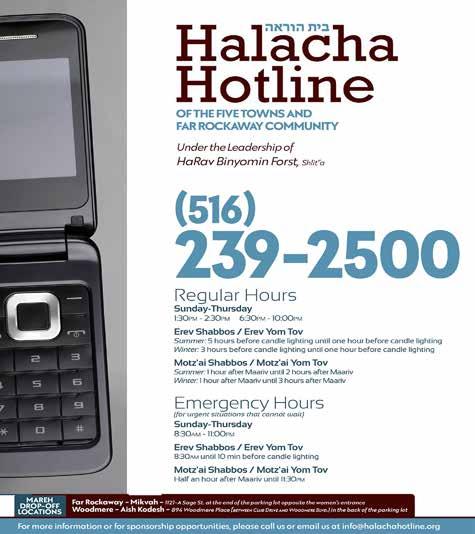
By Etti Siegel

Q:Dear Etti,
I loved the letter from the teacher who wrote about parents hovering and not letting their children experience struggle. Her point, that resilience can only grow when children face appropriate challenges, was right on target. I recently came across a study that drives her message home in a striking way, and I thought you’d appreciate the connection.
The study, “Tough Love: Kids Benefit from Teachers With High Grading Standards,” was reported by Kevin Mahnken (March 20, 2023, The 74) and conducted through Brown University’s Annenberg Institute for School Reform. Researchers Seth Gershenson of American University and his colleagues analyzed data from over 365,000 eighth and ninth grade math students across 4,415 teachers in North Carolina. Their goal was to see what happens when students are taught by teachers who hold higher academic standards and grade more rigorously.
The findings were fascinating. Students assigned to tougher graders performed better on end-of-year math exams and continued to outperform their peers in later courses like Geometry and Algebra II. The improvements were both significant and long-lasting, suggesting that the students didn’t just “study harder for one test.” They actually learned more deeply and retained more. Even more surprisingly, these students were less likely to be absent from class, indicating that higher standards didn’t deter them, but rather drew them in.
Dr. Gershenson explained that stricter grading “changes the way students engage with school.” Any increase in expectations, even a slight one, resulted in measurable gains. In other words, it’s not about being harsh. It’s about believing students are capable of rising to meet meaningful expectations.
This study also indirectly highlights the problem of grade inflation, which the researchers define as grades that are significantly higher than what test scores reflect. They found grade inflation to be more common in wealthier districts, often where parents have the time, confidence, and influence to advocate for their children’s grades. In contrast, when teachers maintained consistent and rigorous standards, students of all backgrounds benefited. The results were positive across 20 demographic groups: different races, genders, and academic levels. Not one group was harmed by higher standards.
That’s an incredible message in our current climate. It echoes what you and that teacher have both said: children don’t flourish when we protect them from struggle; they flourish when we let them meet it. Tough grading,

clear expectations, and natural consequences tell a child, “I believe you can handle this.”
In an age where some parents seem to want to bubble wrap their kids, this study is a reminder that resilience isn’t born in comfort. It’s built when a student experiences a setback, processes it, and tries again, guided by adults who believe in growth more than perfection.
-A Fellow Educator Who Believes in High Standards
A:Dear Fellow Educator, Thank you for taking the time to write in and for bringing that study to my attention. It’s an extraordinary piece of research and such a powerful affirmation of what so many good teachers have known all along: high expectations are an act of love.
The Brown University Annenberg study you referenced is worth every educator’s attention. It dismantles a myth that has quietly crept into education and parenting alike: the belief that protecting children from difficulty will make them happier and more confident. As you pointed out, Gershenson and his team showed the opposite. When students are held to meaningful standards, they meet them.
This agrees with what Dr. Wendy Mogel writes in The Blessing of a Skinned Knee: our job as adults isn’t to clear every obstacle but to give children “the gift of ordinary frustration.” Those small struggles, like a lower grade, a hard quiz, a forgotten paper, are the “scraped knees” that build strength. When parents or schools remove every consequence, they also remove the opportunity for growth.
Dr. Daniel Siegel, in The Power of Showing Up, explains this message well. He explains that children thrive when they feel “seen, soothed, safe, and secure.” But that sense of safety doesn’t come from constant rescue. It comes from trust: knowing that when things get hard, the adults in their lives believe they are capable of handling
it. That form of trust is one of the most powerful forms of love a child can experience.
Modern motivation research agrees. Edward Deci and Richard Ryan’s Self-Determination Theory identifies three needs that drive human growth: autonomy (feeling ownership of one’s choices), competence (believing in one’s ability), and relatedness (feeling connected to others). When teachers and parents step in too quickly by lowering standards or solving every problem, they unintentionally undermine all three. Children lose autonomy (“I can’t handle this myself”), competence (“I’m not good at this”), and even relatedness (“Adults don’t trust me enough to try”).
High standards, on the other hand, strengthen those needs. They send the message: you are capable, and I’ll walk beside you while you try your best. That combination of challenge and support is where confidence is born.
For parents reading this, here’s what that looks like in practice:
When your child brings home a disappointing mark, pause before emailing the teacher. Ask your child, “What do you think you could do differently next time?”
When your son or daughter says a test was unfair, respond, “That must have felt frustrating. What can you learn from it?”
When you feel the urge to fix, replace it with curiosity and trust that your child can learn from the experience.
Real growth doesn’t happen in the comfort zone or the panic zone; it happens in what psychologists call the stretch zone: that middle space where things are hard but possible. Teachers who hold students in that space are doing important work.
So yes, the data says it, the psychologists say it, and our own hearts know it: tougher grading, higher expectations, and the courage to let children experience struggle aren’t acts of harshness; they are teaching moments that our children need to become healthy adults.
Thanks again for writing in,
- Etti

By Bassy Schwartz, LMFT
People often talk about therapy with a mix of curiosity and confusion. It’s become something people either swear by or completely avoid. Some imagine it as an emotional deep dive that only certain people “need,” while others see it as a luxury — something for people who can’t quite manage life on their own.
But in reality, therapy isn’t a “type of person” thing — it’s a part-of-being-human thing.
If you’re in therapy and you’re reading this, keep going — you might learn something new or hear a fresh perspective from the other chair. If you’ve never been to therapy, consider yourself a skeptic or just don’t think it’s worth the money, I wonder how this will go for you.
The Myth of the “Therapy Type”
Some people talk about therapy as if it’s a personality category: the “therapy types” journal, reflect, and are always “working on themselves.” The “non-therapy types” are practical, stoic, and just deal with life. But that’s not really how it works.
Therapy isn’t a club or a culture; it’s a tool. And it’s a tool that can look different for every person. For some, it’s a lifeline — a space to heal deep pain or trauma. For others, it’s simply a quiet hour to understand themselves better, to make sense of patterns that repeat in their relationships or their parenting.
No one is immune from being shaped by their early relationships. Every one of us carries emotional habits — ways we protect ourselves, connect with others, or shut down — that were formed long before we could name them. Therapy just gives language and awareness to what’s already happening inside of us.
It’s not about changing who you are. It’s about seeing yourself clearly enough so that you can evolve from where you have been stuck.

Silent Shift
Maybe part of what makes therapy feel confusing is that most of the work that happens there is not exactly measurable. When someone takes medication, you can see their symptoms improve. When someone starts exercising, you can see their strength and energy change. But when someone goes to therapy, you might not see anything from the outside — yet something profound may be shifting on the inside.
Therapy is relational, not informational. It’s not about being given advice or told what to do. It’s about being met — deeply and consistently — by another human being. For many people, that’s the first time they’ve ever felt truly heard, understood, or safe enough in their whole lives.
That experience alone can rewire how a person relates to themselves and to others. It’s not mysterious; it’s just quiet work. It’s the slow and steady process of learning to stay with your own emotions rather than escaping them.
And because it’s not quick, it can feel confusing from the outside. Therapy doesn’t offer a “fix.” It offers growth.
When people think of therapy, they often imagine a person lying on a couch, talking endlessly about childhood. And yes,
sometimes therapy does revisit the past. But not to dwell there. Rather, it’s to understand how those early experiences still show up in the present.
Here’s what therapy really does:
• It helps us slow down enough to notice our patterns — the ways we get defensive, shut down, or overextend ourselves.
• It invites us to speak our truths without feeling judged or shamed.
• It lets us practice relating differently — to our partners, our kids, our parents, and most importantly, ourselves.
Over time, this process changes us. We start to pause before reacting. We start to understand where our triggers lie — and what feels soothing. We begin to see our own stories with compassion instead of criticism.
It’s not magic. It’s presence.
In couples therapy, for example, partners often learn that they’re not fighting about who took out the garbage. They’re fighting about feeling unseen, unheard, or alone. Once you understand that layer, everything changes.
There’s also a belief around therapists being the “experts” — as if we chose this field because we’re not plagued by the same wounds that hurt the humans we’re sup -
porting at work. Full disclosure — the opposite is usually true.
The best therapists I know use their own experiences of sitting with deep pain, longing for belonging, and learning the power of secure connection as part of their training. Yes, there’s the formal education, the supervision, the specialization — all of that definitely matters. But for me, the best training has been the experience of being held in someone’s presence, in feeling what real attunement can do.
Those who sat with us — who stayed steady in our hardest moments, who modeled what safety and empathy look like — showed us how powerful it can be simply to authentically align with another human being. That’s the real work. And it’s exquisite.
So, What Really Happens?
Therapy is simply a structured space to listen to that information — with someone who helps you make sense of it. It’s not for the “broken” or the “overly sensitive.” It’s for the brave — those willing to look inward and grow.
And yes, therapy is an investment. It costs time, energy, and often money. But so does living with unexamined pain. So does repeating the same arguments, feeling stuck in the same patterns, or living with quiet resentment or anxiety. The question isn’t “Is therapy worth it?” It’s “What would it be worth to feel more grounded, connected, and whole?”
Bassy Schwartz, LMFT is the founder of Core Relationships, a boutique therapy practice in the Five Towns offering individual, couples, and family therapy. Her work centers on helping clients build safer, more authentic connections by healing the patterns that block intimacy and trust. Bassy is trained in Emotionally Focused Therapy (EFT) and integrates trauma-informed care and relational insight in her approach. She believes therapy is not about “fixing” people — it’s about creating the safety to be fully human.
By Miryam Werdyger and Sarah Ziet
The gap between generations can feel as challenging as trying to jump across the Grand Canyon, particularly when it comes to communication. In this fast-paced world, technology is changing more quickly than a breaking news story can be fact-checked and corrected.
The way we connect and share is always on the move. While it’s exciting, it sometimes feels like we’ve got a big ol’ chasm between the young and the wise. But hey, bridging that gap isn’t just about sending clear texts; it’s about building respect, deepening relationships, and creating communities that feel like a warm hug or at least a friendly fist bump!
The Digital Jungle: Navigating Communication Styles
Let’s talk about the younger generation, those so-called digital natives. They’ve been texting, emoji-ing, and video calling since they could crawl. For them, communication is like a fast-food drive-thru – quick, flashy, and full of hashtags! On the flip side, many of our beloved older adults grew up in a time when communication was more like a fine dining experience –slow, deliberate, and full of detail. They’re the kings and queens of letter-writing and phone calls, where every word counts!
This difference can lead to some serious “Huh?” moments. A young person might think a long email is like watching paint dry, while an older person might see a two-word text as a sign of disrespect, like sending a birthday card with just a stamp! To fix this, both sides need to step it up, especially the younger ones. They’re the ones who can navigate the wild world of modern communication like pros, so they can adapt to meet the seniors halfway.

So how do we make those intergenerational relationships more meaningful?
Let’s break it down with five pillars that prioritize understanding over speed, kind of like taking the scenic route instead of the express lane!
1. Empathy and PerspectiveTaking
At the heart of it all is empathy. The younger generation needs to remember that how someone communicates is shaped by their life experiences. If an older adult takes a while to respond, it’s not because they’re stuck in slow-mo; they might just prefer a good old-fashioned conversation! So, maybe take a moment to write out a complete sentence instead of “LOL” and pick up the phone for those deep chats. It’s like giving a high-five to their preferred style!
2. Challenging Stereotypes
Stereotypes are like those annoying flies at a picnic, always buzzing around and ruining the fun! We often think old-
er adults don’t get tech or only reminisce about the good old days. But let’s get real; many seniors are tech-savvy and have stories that could put Netflix to shame! Ask them about their lives, and you might just uncover a hidden treasure trove of wisdom.
3. Mindful Technology Use Technology is just a tool! Use it wisely. Before you hit send on that text, think about whether it’s really the right way to communicate. Sometimes, a phone call or even a face-to-face chat can convey warmth and clarity that a text just can’t. It’s all about prioritizing connection over convenience, like choosing a hug over a handshake!
4. Seek Out Intergenerational Connection
Let’s break down those walls! We need to create opportunities for younger and seniors to hang out and collaborate. Whether it’s mentoring, volunteering, or just grabbing coffee together, these interactions help bridge the divide and turn those age stereotypes into relatable stories.
5. Listen Actively
We’ve got to listen – like really lis -
ten! Active listening isn’t just waiting for your turn to speak; it’s about tuning in and soaking up those life stories. Ask open-ended questions that invite sharing, and you might just unlock a treasure chest of memories and insights. “What was your biggest career win?” or “What was a life challenge you had as a young adult?” can open the door to a fascinating tale!
The Shared Benefit of Bridging the Divide
In the end, effective intergenerational communication is like a two-way street filled with mutual respect and a dash of humor. When the younger generation adapts and listens, and the older generation stays open to new ideas, everyone wins! The young gain wisdom and emotional intelligence, while the older generation gets a taste of tech-savvy fun and fresh perspectives. Let’s embrace our differences, break down those stereotypes, and create connections that make our communities stronger.
Remember, the generational divide is not a permanent fixture; it’s a communication challenge we can tackle together –preferably with a smile and a good joke! Check in from time to time and ask yourself, “Are you really listening?”
Have something to share? We’d love to hear from you!
Miryam Werdyger and Sarah Ziet are Certified Life Coaches and mentors specializing in Effective Communication Skills for individuals, couples, parents, groups and singles navigating the dating world. They can be reached at coachmiryam@icloud.com or via WhatsApp/text at 516-924-7695.

Meat / Yields 8 servings

By Naomi Nachman
This is a one-pot wonder. Super quick and easy to make, it has everything you need to fill a kid’s
tummy quickly, especially after a long and cold bus ride home from school in the winter.
◦ 2 Tablespoons canola oil
◦ 1 large carrot, diced
◦ 3 stalks celery, diced
◦ 1 medium onion, diced
◦ 4 cloves garlic, minced
◦ 8 cups chicken broth 2 teaspoons Italian seasoning
◦ Kosher salt, to taste
◦ Freshly ground black pepper, to taste
◦ 1 package frozen dumplings
◦ 2-3 cups shredded rotisserie chicken or leftover chicken from soup
◦ 3 cups fresh baby spinach or kale

1. Heat olive oil in a large pot over medium heat. Add carrots, celery, and onion; sauté 3-4 minutes.
2. Add garlic; sauté 30 seconds longer. Stir in chicken broth, Italian seasoning, salt, and pepper. Bring to a boil over medium-high heat. Cover; boil for 15 minutes.
3. Add dumplings; cover and boil 6-8 minutes. Stir in shredded cooked chicken and spinach; cook until heated through and the spinach has wilted, about 2 minutes.
Naomi Nachman, the owner of The Aussie Gourmet, caters weekly and Shabbat/ Yom Tov meals for families and individuals within The Five Towns and neighboring communities, with a specialty in Pesach catering. Naomi is a contributing editor to this paper and also produces and hosts her own weekly radio show on the Nachum Segal Network stream called “A Table for Two with Naomi Nachman.” Naomi gives cooking presentations for organizations and private groups throughout the New York/New Jersey Metropolitan area. In addition, Naomi has been a guest host on the QVC TV network and has been featured in cookbooks, magazines as well as other media covering topics related to cuisine preparation and personal chefs. To obtain additional recipes, join The Aussie Gourmet on Facebook or visit Naomi’s blog. Naomi can be reached through her website, www.theaussiegourmet.com or at (516) 295-9669.


I think we’re just gonna kill people that are bringing drugs into our country. They are gonna be like dead.
– Pres. Trump
Narco states are getting a taste of gun-boat diplomacy.
– Jesse Watters, Fox News
REP. NANCY PELOSI (D-CA): [Trump is] just a vile creature. The worst thing on the face of the Earth.
CNN’s ELEX MICHAELSON: You think he’s the worst thing on the face of the Earth?
PELOSI: I do, yeah. I do
I don’t know of a greater criminal in history.
- Actor Harrison Ford, talking about Pres. Trump, in an interview with The Guardian
Don’t worry, because we’re all still trying to figure out exactly what it means.
- Dictionary.com about its word of the year “6-7”








I’m not suggesting, I haven’t suggested Donald Trump is Hitler.
- Illinois Gov. JB Pritzker (D) in an interview with MSNBC Nicole Wallace
I don’t think any Democrat has.
- Wallace in response
After the polls close tomorrow night, I will impost a 100% tariff on anyone moving to Texas from NYC.
- Tweet by Texas Gov. Greg Abbott (R)
I don’t miss playing the game. I don’t. There hasn’t been a day since I retired where I’ve missed playing the game. But if I could wake up and play in the World Series, I’d do it.
– Yankee great Derek Jeter on “The Herd with Colin Cowherd”
No, Jake. There has been gerrymandering going on for 200 years. There is such extreme gerrymandering going on that in a state like Massachusetts, it has like 40% of the people voting for Trump, they have zero representatives. The Republican Party has zero representatives sent to the House. Think about that. In New Mexico, 45% of the people voted for Trump and vote Republican, and zero is sent to the House, zero representatives from the Republican Party.
- Arnold Schwarzenegger schooling CNN’s Jake Tapper, who suggested that the Republican party “is starting” the practice of gerrymandering
There’s a doomsday view of climate change that goes like this:
In a few decades, cataclysmic climate change will decimate civilization. The evidence is all around us—just look at all the heat waves and storms caused by rising global temperatures. Nothing matters more than limiting the rise in temperature.
Fortunately for all of us, this view is wrong. Although climate change will have serious consequences—particularly for people in the poorest countries—it will not lead to humanity’s demise. People will be able to live and thrive in most places on Earth for the foreseeable future.
- Bill Gates, in a new editorial which is a reversal of his long-held view on global warming
The logic of the tarifflationistas sounded straightforward. They claim that if you raise tariffs on imported goods, consumers would pay more for everything. But new data from the Harvard Tariff Price Tracker tell a very different story. A year after the tracking began, prices do not show signs of tariff-induced increases. What’s more, the only meaningful price growth lately has come from goods completely untouched by tariffs.
- John Carney, Breitbart
We were all too aware that as a first black couple, we couldn’t afford any missteps. And that as a black woman, I was under a particularly white hot glare.
- Michelle Obama, in her new memoir
We didn’t get the grace that I think some other families have gotten. - Ibid.
At this time, neither Congress nor the over 300 million Americans who actually own the White House are aware of what you have done to safeguard the objects in the East Wing that hold cultural and historic significance to the country. We are especially troubled because you have a history of demolishing historic property without notice or consent.
- From a letter –which was addressed to “What Remains of 1600 Pennsylvania Ave NW Washington, DC 20500” –sent to Pres. Trump by 60 members of Congress with Ballroom Derangement Syndrome
Republicans Donate $50 million to Kamala 2028 Campaign
- The Babylon Bee headline
Tragic: Dick Cheney Dies Before Getting To See World War III - ibid.





By David Ignatius
Oh, what a lovely trade war. The United States and China got to test their heavy tariff and embargo artillery without inflicting significant damage on each other. And then, at their summit meeting in South Korea on Thursday, both countries’ leaders took a step back from the brink of the economic “decoupling” that many analysts have forecast for nearly a decade.
“Both sides saw what real decoupling would mean. They looked over the precipice and decided, ‘I don’t think so,’” explains Christopher Johnson, the CIA’s former top China analyst who now runs China Strategies Group, a consulting firm. This “temporary patch-up” will give each government breathing room, he told me in an interview.
Donald Trump’s critics will argue that this was a Chinese “TACO” – “Trump always chickens out” – as the president agreed to halt the imposition of 100 percent tariffs on Beijing that even he had admitted were “not sustainable” and set a lower rate. Trump backed away after China agreed to a year-long pause in its potentially crippling embargo on rare-earth minerals on which it holds a near monopoly. China showed it could deny Trump “escalation dominance” with its export controls, Johnson contends.
But to me the summit looks more like a win-win, as the Chinese tediously like to say, than a defeat for Trump. The two sides flexed their muscles, scared the financial markets just enough to be credible and then found a temporary compromise that opens the way for what Johnson predicts will be a year of summitry with reciprocal visits to China and America.
As the French saying goes: “Seule le
provisoire dure ” Only the temporary lasts. That appears to apply to the world’s two leading superpowers, which are better served by preservation of the status quo than some “grand bargain” that could be dangerous for both.
Trump described the meeting with his characteristic hyperbole. “I would say on a scale from 1 to 10, with 10 being the best, I would say the meeting was a 12,” he told reporters on Air Force One as he left South Korea. What strikes me watching Trump and Xi maneuver in this moment is that they share a taste for autocratic, one-man rule, but bring to it radically different personalities, values and experiences.
The two share an obsession with their place in history and are fanatical self-promoters. Like Trump, Xi is a nonstop propagandist. The five volumes of his collected speeches and writings are known as “Xi Jinping Thought.”
“Xi clearly sees himself as a man of destiny, the latest caretaker of Chinese civilization whose mission is to guide his country on the path to national rejuvenation,” argues Joseph Torigian, a professor at American University and author of “The Party’s Interests Come First,” a brilliant biography of Xi’s father. Trump similarly sees himself as an instrument of national renewal who will, as millions of his red-hatted followers proclaim, “Make America Great Again.”
Yet, the differences between them are stark: one president seems to revel in corruption, the other views it as a poison that could destroy his party’s control; one took a gilded path to power as the son of a real estate tycoon; the other suffered terribly during the purge years of the 1970s; one plays a short game with wildly oscillating

policies; the other a long game built on meticulous plans and clearly articulated goals.
Where Trump is a disrupter who uses his erratic and impulsive decisions as bargaining weapons, Xi is a disciplined and ruthless enforcer. But Lingling Wei, a top China reporter for the Wall Street Journal, argued recently that Xi has learned from his interactions with the bombastic Trump and adopted a code that amounts to, as the headline on her story put it, “punch hard, concede little.”
The most unlikely fact shared by the two men is that they are at war with the governing class beneath them. Trump’s strange position as a populist billionaire fighting a war against what he views as the “deep state” elite is well known. Less so is Xi’s campaign to purge what he saw as the corruption and weakness that enfeebled the party, military and intelligence elites.
Xi pledged in 2012 as he rose to power that he would fight “tigers and flies at the same time, resolutely investigating law-breaking cases of leading officials.”
A former U.S. intelligence official told me that in an early meeting with fellow party leaders, Xi placed a blue folder in front of each of them documenting their relatives’ corruption. Since 2012, Xi’s party inspectors have disciplined more than 6.2 million people, according to the Wall Street Journal. The number of people investigated for infractions has risen from around 180,000 in 2013 to 889,000 last year.
The purge has been especially fierce in the Chinese military. Xi realized that senior officers in the People’s Liberation Army were getting their posts by bribing superiors and then extracting similar payments from their underlings. In 2023, Xi
removed two top commanders on the PLA Rocket Force; the next year, he purged two former defense ministers. This month, just before a big party plenum meeting, he sacked nine more top commanders, including the general who headed the Eastern Theater Command, which oversees Taiwan operations.
A symbol of Xi’s war against military corruption is his choice of Gen. Zhang Shengmin, the military’s top anti-graft inspector, as vice chairman of the Central Commission, which is headed by Xi himself. He said back in 2014, when he began to purge the military, that when he read reports of PLA corruption, “I feel deep disgust and often can’t help but slam the table. … If the army is corrupt, it can’t fight.”
What’s ahead now? Johnson says Trump seems to be aiming for a relationship with Xi that mirrors the one that President Ronald Reagan had with Russian leader Mikhail Gorbachev. To get there, he had to de-escalate. His instructions to Treasury Secretary Scott Bessent were, “‘Let’s make a deal,’” Johnson says.
Trump seems to view major-power foreign policy as a tough-guys club, and he obviously regards Xi as a fellow member. But Trump may underestimate just how ruthless and disciplined Xi is. Certainly, he proved a much tougher adversary in the now-paused trade war than Trump imagined.
The idea of a world governed by these two autocrats is loathsome. But if that’s what we’re stuck with for now, it’s certainly better to have them talking than fighting.

PBy Marc A. Thiessen
resident Donald Trump says he is returning home from Asia with commitments for trillions in new investment in the United States. Let’s hope he is leaving behind his plan to take in hundreds of thousands of Chinese students at U.S. universities.
This summer, the Trump administration wisely announced plans to “aggressively revoke” visas of Chinese students in the United States “including those with connections to the Chinese Communist Party or studying in critical fields.” But then Trump reversed course, announcing in August that he would increase the number of Chinese students attending American universities to 600,000. This would more than double the approximately 275,000 Chinese students in the United States, and allow China to surpass India as the country with largest enrollment in the U.S.
That is a terrible idea.
The FBI reports that China is engaged in a systematic effort to target U.S. universities, using Chinese students and researchers to conduct espionage and steal “technologies needed to advance China’s national, military, and economic goals.”
In some cases, students appear to spy on our military. In 2020, recent Chinese graduate students at the University of Michigan pleaded guilty after being caught photographing defense infrastructure at a naval air station in Key West, Florida. In August 2023, five Chinese students at the University of Michigan were caught outside Camp Grayling, 200 miles north of their school, during a U.S. National
Guard training operation that included the Taiwanese military. In 2024, a Chinese graduate student at the University of Minnesota was convicted of using a drone to take photos of naval bases in Norfolk.
But more often, students are recruited to target research at U.S. labs and universities. In 2022, then-FBI director Christopher A. Wray reported that the FBI was investigating more than 2,000 cases of Chinese intellectual property theft in the U.S. and opening up new Chinese espionage cases at a rate of one every 12 hours – many of them involving U.S. colleges and universities.
For example, in 2020 the Justice Department indicted a Chinese researcher at Harvard who was arrested attempting to smuggle vials of biological research to China. The U.S. also indicted an undercover Chinese military officer who was a student at Boston University researching U.S. military projects, and who had allegedly compiled information for the Chinese People’s Liberation Army on two U.S. scientists with expertise in robotics and computer science.
Amazingly, some Chinese researchers on campus don’t even hide their PLA affiliations. In 2018, the Financial Times reported that American universities had hosted more than 500 visiting scholars from People’s Liberation Army-affiliated schools over the previous decade, many of whom wrote joint papers with U.S. academics. Why has the U.S. government permitted students openly linked to the Chinese military to receive U.S. visas?
Many Chinese students may conduct

espionage for Beijing willingly. Others are certainly coerced by the regime. In 2017, China passed a National Intelligence Law requiring that all Chinese citizens support and cooperate with state intelligence work, whether at home or abroad, meaning that Chinese nationals at U.S. universities have no choice but to inform the Chinese Communist Party if they are asked to do so. As Stanford Review reporters Garret Molloy and Elsa Johnson noted in an investigation this year, family members of Chinese students can be taken to police stations in China if students won’t hand over certain documents. “If you do not comply with the national intelligence law, your family back in China is under threat,” Molloy told me. “Therefore, students have a very strong incentive to do exactly what the party says.”
Rep. John Moolenaar (R-Michigan), chairman of the House select committee on China, recently sent a letter to the presidents of Stanford, Carnegie Mellon, Purdue, the University of Illinois, the University of Maryland and the University of Southern California warning that “the unchecked enrollment of Chinese nationals in American institutions risks facilitating the technological transfers that strengthen Beijing’s military and economic competitiveness at our nation’s expense.” Chinese students, Moolenaar continued, are giving China “access to cutting-edge research in fields such as artificial intelligence, quantum computing, semiconductors, and aerospace engineering.”
There is a reason China has made protecting visas for Chinese students a top priority. They help the Chinese Commu-
nist Party carry out what Wray called “the largest and most sophisticated theft of intellectual property and expertise in the history of the world.” Given this fact, why on earth would the Trump administration give the Communist China the opportunity to double the number of its students in the U.S. to help carry out that espionage?
In 2012, President Barack Obama signed legislation prohibiting Iranian students from studying energy, nuclear science or nuclear engineering in the United States. We should be imposing similar restrictions on Chinese students, not expanding their access to U.S. research and technology.
Asked by Fox News’s Laura Ingraham why the administration would welcome 600,000 students from Communist China to attend U.S. universities, Commerce Secretary Howard Lutnick absurdly argued that without those Chinese students filling spots in America’s top schools, U.S. students “would go up to better schools, and the bottom 15 percent of universities and colleges would go out of business in America.” In other words, by Lutnick’s logic, we should let Chinese students displace Americans at the best U.S. universities, pushing Americans down the academic ladder to schools so bad that they would otherwise close, while giving the Chinese students the opportunity to collect intelligence at the most sophisticated research institutions in America.
How, exactly, is that putting “America First”?
© 2025, Washington Post Writers Group
By Vivian Yee and Rania Khaled
CAIRO — When he returns to Cairo for a visit after 20 years in America, Masry, the main character of the classic Egyptian film “Bittersweet,” has to readjust to the daily indignities of life in Egypt all over again. But one of his biggest shocks comes when he goes to a government office for a new passport.
To process his application, the official in charge asks for “tea” with 100 spoonfuls of sugar, a request that mystifies Masry, until his friend explains that the official wants a bribe.
“Shall I help you,” the official says to the scandalized Masry, “or would you like to go to the back of the line with a ‘good conscience’?”
Handing over cash to skip a line for extra help or as a thank you is so taken for granted in Egypt that companies sometimes consider such “tips” a routine business expense. Parking valets, servers, door attendants and delivery people get them, just as they might in other countries. But so do receptionists at private medical clinics, government clerks and even hospital nurses, some of whom request tips for tasks like bringing their patients water.
To anyone watching “Bittersweet” in Egypt in 2025, 15 years after its release, the size of the bribe is what sticks out.
In 2010, 100 Egyptian pounds was around $18. Today, several economic crises and currency devaluations later, Masry’s unpaid bribe would be worth only about $2.
Even that might be a stretch for middle-class or poor Egyptians now. Inflation has been stuck in the double digits since the country’s latest economic crisis started in early 2022, reaching a record high of 38% in September 2023.
Inflation declined to 11.7% last September, after Egypt received multibillion-dollar bailouts from the International Monetary Fund, the United Arab Emirates and the European Union and moved to stabilize the economy.
But progress on economic reforms re -

mains slow. And Egyptians are still raw from years of sacrifice, belt-tightening and deepening poverty.
“Inflation got to everything, even tips,” said Marina Kaldas, 29, a social media manager in Cairo. “In the past, people could pay 10 to 20 pounds, and it would be totally enough. But now if you paid someone just 10 pounds, he wouldn’t be able to do anything with it.”
When Kaldas’ father went to the hospital in March for kidney failure, she said, the nurses ignored his requests for water or for help changing his clothes until she began tipping them — an exasperating expense, even if it was only about $1 a day for each nurse.
Because of the economic situation, Kaldas said she had understood. “Low wages force people to rely on tips,” she said. “They need to have extra money.”
Tipping might be an ingrained habit in Egypt, but opinions vary widely about the appropriate time to give and whether payment for certain favors is a token of gratitude, or plain old bribery.
Two years ago, Kaldas found herself stuck in a long line at an office when she needed to renew her driver’s license in a
hurry. While waiting, she saw others bribing a government employee to get their licenses without a driving test, she said.
Kaldas disapproved — what about road safety? — but she was not above tipping the same clerk after he allowed her to skip to the front of the line, giving him 1,000 pounds (about $33) to thank him on top of the regular fees, she said.
If the same thing happened today, she said she would have to tip him up to 1,800 pounds (about $38).
Higher tips are increasingly hard to afford for many Egyptians. Still, some see giving extra money as a religious duty or as an act of charity, a way of bridging the otherwise yawning gap between people with something to give and those with next to nothing.
Though Egypt says it has expanded welfare programs, the most recent official statistics, from 2019, estimated that just under 30% of Egyptians were living in poverty. With the coronavirus pandemic and the most recent economic downturn, the percentage has almost certainly risen. The government is also slashing bread, gas and electricity subsidies crucial to many poor Egyptians.
Mai Mohammed Sadek, an English teacher in Cairo, said she tried to give 10 to 15 pounds (about 20 to 30 cents) to parking valets and grocery store baggers, up from her usual 5 pounds before the economic crisis.
“It’s always been part of the culture, but maybe your intentions are a little bit different now,” she said. “You’re doing this because you know how hard it is, so you’re helping, instead of saying thank you.”
But regardless of the recipient’s need, she said it irritated her whenever she pulled into a public street parking spot and one of Cairo’s many self-appointed parking attendants suddenly materialized to “help” — then made clear, through body language or by wishing her happy holidays, that a tip was expected, even though she had found the spot and parked the car herself.
“Like, what did you do?” she said. “Nothing!”
Gifts that buy the tipper an advantage over others, such as permission to cut a line, also offended Sadek’s sense of fairness, she said.
For some who tip, however, such exchanges are the only lubricant for the squeaky, worn-down wheel of Egyptian life. And for those who receive them, collecting tips is a socially acceptable way to survive in a merciless economy.
This year, Amr Ahmed, 55, a computer technician in Cairo, was at a medical clinic so packed that he knew he would be waiting for hours for a doctor.
Sensing from the receptionist’s friendliness that he could help — for a price — Ahmed slipped him 50 pounds, (about $1) to secure an earlier appointment.
A few years ago, he might have given just 5, he said.
“Sometimes you feel embarrassed when you pay so little, because you know how little it is,” he said. “When you give people money, you want to give them something they can appreciate.”

By Hikari Hida

Japan has about 100,000 people who have lived for a century or more — the most in the world, and more per capita than in any other country. The frailty that comes with age is creating challenges for Japan, where a record-low birthrate means ever more retirees and fewer working-age people to support them.
But for some people, reaching 100 is just another milestone in a full life. We met five remarkable centenarians who credited their longevity to eating well, Japan’s affordable health care, exercise and family support. But for these five, there is also something else: their work.
As a 12-year-old, Seiichi Ishii was walking home from school one day when he came across a “help wanted” sign in the window of a bicycle repair shop in the Shitamachi district of Tokyo. He had always admired the long navy jumpsuits that bike repairmen wore, and he wanted to step into one himself.
More than 90 years after that start, Ishii is still fixing bikes at his own shop.
Although the legs of the jumpsuit are too long for his shrinking body, he goes to bed every night excited about the customers who might show up the next day. “If I die here, in my workshop, I will be happy,” he said. “I am a working man, and that doesn’t change with age!”
Ishii, 103, loves removing bolts and tires and puzzling out how to piece everything back together, though his hands have grown shaky and his vision is blurrier than in his younger days.
Ishii remembers living through the war, when nothing was guaranteed. His income from the repairs supplements a monthly pension of 50,000 yen, or about $330. “You never know what will happen,” he said, making miso soup for one in the cluttered kitchen behind his shop.
Working on bikes brings him even more joy than singing karaoke, which he does every Sunday at his favorite snack bar. He rides a tricycle to get there. On special karaoke outings, he wears his old jumpsuit with the hems rolled up.
The Ramen Chef
or six days a week, Fuku Amaka-
wa works the lunch shift at her family’s ramen restaurant alongside her son and daughter, using long chopsticks to swirl egg noodles in pork broth and sprinkling chopped spring onions into bowls filled with hot soup.
“I can’t believe I’ve managed to work this long without getting bored,” she said while disinfecting serving trays.
Amakawa, 102, said she has always been a bit stubborn. She put off her arranged marriage as long as she could. But after she made the leap, she opened the restaurant with her husband. Its 60th anniversary was this year.
“It is really beautiful that I can still work. Physically and emotionally, it changes the quality of my life,” she said, sitting below an autographed photograph of Takuya Kimura, a singer and actor who visited the restaurant last year. Amakawa’s skin glistens, which she attributes to all the steam in the kitchen.
One of her biggest fears is losing the ability to walk, and she said the work helps her stay fit. Last year, she felt pain in her chest and panicked, afraid she was having heart problems. But a doctor told
her not to worry: It was just muscle pain, from lifting heavy pans.
Bright yellow rapeseed flowers, Masafumi Matsuo’s favorite, filled the fields behind his home when he was young. He loved the mild bitterness of the vegetable, which turns sweet when cooked and which he farmed and sold. But his son, who now runs the family farm, decided to replace the flowers with rice, a less laborious crop to maintain.
Matsuo, 101, also grows eggplants, cucumbers and beans across different seasons. “I work to stay healthy,” he said on a July morning, dragging a plastic stool out into the field, where he sipped water during breaks from watering his rice seedlings.
Matsuo was born, grew up and raised three children in his town, which is nestled in the mountains of Oita, a coastal prefecture on the southwestern island of Kyushu. His wife died four years ago, which devastated him. Every morning, he climbs the stairs, clutching the railing, to the second floor, where he has made
a Buddhist shrine to his wife and brings her freshly cooked rice.
Matsuo, who survived esophageal cancer and, at 99, a bout of COVID, spends his weekends playing with his year-old great-grandson, Toki. After farming each day, he goes inside to rest at his kotatsu, a heated table that’s covered with heavy blankets. He slides down into their warmth as grasshoppers bounce around on the windowsill behind him.
Tomoko Horino always knew there was more in store for her than staying home. Inspired by a salesperson she had met, she wanted to sell makeup. But she was a young mother of three, and cultural norms meant it would not be considered proper for her to work.
At 39, she ran into an old friend whose husband was recruiting salespeople for the same makeup brand she’d fallen in love with years before. With her children older, she took the job. Horino loved seeing her customers’ faces light up as they tried a new lipstick color or foundation that she’d suggested.
“When I first tried on makeup, I felt so pretty,” she said. “I wanted to make others feel the same way.”
Her husband, who worked in an office, wasn’t happy to have a wife who also worked, but the family was in a dire financial situation. All he asked was that she knock on doors where she wouldn’t be recognized. She complied, traveling at least an hour from home to sell her products. Soon she was making more than he was.
“I love making people feel beautiful,” Horino said. When she sees a customer’s self-confidence rise, “that is the most important and joyful part of this,” she said.
When Tomeyo Ono plopped onto a cushion to begin her performance, there was total silence. Then, from somewhere
“If I die here, in my workshop, I will be happy. I am a working man, and that doesn’t change with age.”
Now widowed and living alone at 102, she makes her sales over the phone, with only occasional home visits. Keeping busy helps her fend off loneliness. She spends the rest of her time knitting, feeding tuna-flavored kibble to the neighborhood cat and waiting for neighbors to drop by for a cup of oolong tea. Although she has outlived most of her clients, she’s never considered quitting her job.

deep in her petite body, she started to recite the folktale of a bull and a baby bear, with perfect enunciation.
As she spoke, she gestured wildly with her hands, the audience hanging on every word. At the end, the room filled with applause.
With a repertoire of 50 stories, Ono is a teller of minwa, or folktales, a career she took up for fun after turning 70. “I’ve never had a proper job before;
can I do this?” she said she thought at the time. “I was raised in the suburbs, and girls didn’t know that we could have dreams back then.”
Now 101, she is the oldest, and loudest, member of a storytelling collective. After the 2011 tsunami washed away her home in Fukushima, she vowed to incorporate the experiences of its survivors into her work.
“I’m living to tell my stories,” Ono said, tears rolling down her cheeks. She said she was terrified by the idea of folktales, or memories of the tsunami, being lost.
Every day, she writes in her journal and eats natto — a sticky dish made from fermented soybeans — folded between two pieces of fluffy white bread. Occasionally, she dozes off while reading the newspaper as her daughter-inlaw tidies up around her. “I get special treatment because I’m the oldest,” she chuckled.
Lately, Ono said, she “no longer dreams of the living,” seeing only friends and family from the past. She is determined to keep telling stories until she joins them, she said.
© The New York Times

By Avi Heiligman



Every year on November 11, the United States observes Veterans Day to expresses its gratitude for those who served in uniform. The date marks the anniversary of the armistice that ended World War I in 1918. After World War II, the day was expanded to include veterans of all wars, and in 1954, the name was changed from Armistice Day to Veterans Day. Over the past two and half centuries, hundreds of thousands of Jewish soldiers, sailors and airmen have served in the ranks of the American military. Here are some of the stories of those who have served the United States while in uniform.
The Jewish War Veterans (JWV) was founded in 1896 by 63 veterans of the American Civil War who formed the group to refute allegations that Jews didn’t serve in uniform. It is the oldest active veterans’ organization in the United States and provides many services including helping veterans in need and combating antisemitism. Additionally, they have published several books and articles to preserve the legacy and history of those who served serve in uniform.
Lieutenant Irving Katzman was an infantryman with the 117 th Regiment, 30 th Infantry Division and received a battlefield commission while fighting in Europe. He was wounded twice – the first time in Normandy and he was hit a
second time by an artillery fragment near Aachen. While in Normandy, he was decorated for taking out seven German machine gun nests that were causing problems for the Allied advance.
On July 31, in France, his unit was unable to advance due to heavy enemy fire. Katzman voluntarily advanced alone into enemy territory to identify the location of the German guns. He later recalled, “After crossing a river I had to go 1,600 yards into enemy territory, I had to crawl around sleeping Germans and spent the night in a hayloft above their billet.” He returned to American lines with a detailed report on the German positions and soon artillery was able to take out the enemy strongpoint.
Katzman earned a Silver Star for his actions in addition to the Bronze Star for helping his unit get out of another tight spot. Katzman was decorated again for rescuing his executive officer and was awarded the Soldier’s Medal.
The Distinguished Service Cross citation for Joseph Glider of Philadelphia does not mention details of his actions and just says it was for “extraordinary heroism in connection with military operations against an armed enemy while serving with the 47th Infantry Regiment, 9th Infantry Division, in action against enemy forces on 16 June 1944.” The book,
Jews in American War, put out by the Jewish War Veterans goes into details of Glider’s heroic actions.
Glider and another officer were on a reconnaissance mission to look for an antitank gun and two machine guns. They hadn’t gone very far when the guns they were looking for opened fire and killed the driver of their vehicle. The two other Americans were severely wounded, and despite having three bullets wounds in his chest, Glider went into action. He pulled the other wounded officer and the driver out of the wrecked vehicle. Then Glider went looking for the position of the enemy guns, found it and then gave the coordinates to a mortar crew. The German guns were soon eliminated. Glider soon collapsed from his wounds but recovered. In addition to the Distinguished Service Cross, Glider received the Purple Heart with oak leaf clusters for his wounds.
On January 24, 1963, a Boeing B-52 Stratofortress with the call sign Frosh 10 was flying at around 500 feet on a low altitude training mission over Maine. The wind picked up and soon the B-52 was in trouble. Due to severe turbulence, the pilot tried to gain altitude but a mechanical failure caused the pilot to lose control. The call to abandon the plane was given, but only three crew members made it out before the plane crashed into a moun-
tain. One of the three was killed when he hit a tree, leaving pilot Lieutenant Colonel Dante E. Bulli and Jewish navigator Gerald Adler as the only two survivors. Adler’s parachute didn’t open, but he landed in the deep snow after falling through tree branches still in his ejection seat. Despite surviving the fall, he wasn’t out of the woods yet as the temperatures there plummeted to 20 degrees below zero. He spent the night waiting to be rescued, and finally, after 20 hours, a helicopter appeared. Both Adler and Bulli were hoisted onto the helicopter. Adler had suffered from frostbite and several broken bones and spent a long time recovering from his injuries. Further inquiries into the crash and a similar one a few days later in New Mexico revealed that the vertical stabilizer in the B-52 could fail in specific conditions. The sacrifice made by those in the military is rarely told, and these Jewish Forgotten Heroes are just a few of the many whose bravery and dedication deserve to be remembered.
Avi Heiligman is a weekly contributor to The Jewish Home. He welcomes your comments and suggestions for future columns and can be reached at aviheiligman@gmail.com.

DU N DURT
Power & Soft Washing
We clean siding, stucco, decks, driveways, concrete, pool patios, pavers & sidewalks. Say goodbye to grime, mold & allergens! Call/WhatsApp: 718-688-2964 Email: dundurtny01@gmail.com
VACUUM SALES AND REPAIR
All areas call Max Flam 718-444-4904
THE LEATHER SHOPPE
The spot for all your custom leather Judaica. Tallis/tefillin bags, lulav and esrog bags, havdallah sets, challah covers, shtenders, pesach sets, matzah/afikomen bags. WhatsApp: (732) 523-0007 or email: theleathershoppe732@gmail.com for a full catalog. We ship.
PEACEFUL PRESENCE STUDIO
Men’s private yoga, Licensed Massage & Holistic Health Guidance 436 Central Ave, Cedarhurst Info. & free video training www.peacefulpresence.com 516-371-3715
DIAL-A SUB-LEGENDARY & experienced teachers available for emergencies. Substitutes teaching all subjects.
$180 per day. Payment a must before entering a class. Please call (516) 265-4872
GERBER MOVING
Full Service Moving Packing Moving Supplies
Local Long Distance. Licensed Insured 1000’S Of Happy Customers Call Shalom 347-276-7422
HANDYMAN AVAILABLE
For big or small jobs, Sheetrock, carpentry, painting, electrical, plumbing, install & repair appliances Call Ephraim at 347-593-4691
MANAGEMENT STAFF WILL ASSIST
you with:
* Obtaining Medicaid and Pooled Income Trust
* In-home Assessments, Individual and Family Counseling
* Securing reliable home care assistance
* Case and Care Management services Dr. S. Sasson, DSW, LCSW (718) 544- 0870 or (646) 284-6242
Traveling EMT
For school trips & Shabbatons, hotels, all social events. last summer was sold out! Make reservations early! Please call (516) 265-4872
HAIR COURSE:
Learn how to wash & style hair & wigs. Hair and wig cutting, wedding styling Private lessons or in a group Call Chaya 718-715-9009
ZEVIZZ WOODTURNING JUDAICA
Challah knifes, batei mezuzah, besamim holder, kiddish cups, havdalah candle holders, yad for sefer torah, pens, stenders, bowls and more 952-356-2228
MY MOTTO IS DON’T WAIT TO buy real estate
Buy real estate and wait Your realtor for life 516-784-0856 Alexandra at Realty Connect USA
PRIVATE DRIVER AVAILABLE For all your needs. Reliable. Safe. Experienced and Trustworthy Call Yaakov 917-825-7057
REAL ESTATE MANAGEMENT Services – Do Not Manage Your Properties Alone! Contact Aliyah Suites for all your real estate management needs and affordable office space near you! (516) 366-1049 Management@aliyahsuites.com Marc Jeret (MJ) Team Leader & Licensed Real Estate Agent





















CAN’T AFFORD YOUR PROPERTY TAXES? MORTGAGE? Must sell for any reason? Call for FREE Consultation. Call now 212-470-3856 Cash buyers available!
CEDARHURST
Prime Restaurant Location For Lease.
For more information: Call/Text/WhatsApp Owner: (516) 206-1100
CEDARHURST OFFICE FOR RENT
2nd-floor space with Central Ave entrance, furnished. 175 sqr ft. $850 includes utilities & Wi-Fi. Perfect for therapist or office use. No long-term commitment. Available immediately. Text/WhatsApp 516-371-3715.
2 BEDROOM BASEMENT
Apartment available immediately in Bayswater. Airy and bright. Private washer/dryer. New kitchen appliances. Near shuls and transportation. $1800 rent. (917) 574-2381
ZAREINU
Is seeking a Co-Rebbe position for this year for a sixth and seventh grade boys class in a local Yeshiva. Great pay! Warm environment with administrative support!
E-mail resume: info@zareinu.org or call 718-406-8343 ext 229
ZAREINU
Is seeking an assistant Rebbe position for this year for a sixth and seventh grade boys class in a local Yeshiva. Great pay! Warm environment with administrative support!
E-mail resume: info@zareinu.org or call 718-406-8343 ext 229
DELIVERY PERSON NEEDED to deliver this Newspaper every Thursday morning to locations in Brooklyn. Must have Mini van or SUVand availability to work Consistently every week. Good pay - Please email gabe@fivetownsjewishhome.com or call (917) 299-8082






REGENTS EXPERT Tutoring regents in Algebra and Geometry A Darchei Torah instructor. Guaranteed results Text 347-491-8045 WhatsApp 347-767-1755
SEEKING ELEMENTARY TEACHERS and assistants for General Studies for the ‘25-’26 year. Assistants should have skills to take over for teachers if needed. Far Rockaway area boys’ school, M-Th, PM hours, strong support. Excellent salary. Send resume to teachersearch11@gmail.com.

SCHOOL ADMINISTRATIVE
Secretary – Boys HS in Forest Hills seeks mature, middle-aged female. $65–70K. Mon–Thu, occasional Sundays. Warm environment. Email malky@candidrecruits.net or call/WhatsApp (845) 801-5114
YESHIVAT KOL YAAKOV
In Great Neck, NY, is seeking general studies teachers for both the elementary and middle schools, for the upcoming academic year. Mon-Thur afternoons. Competitive salary, warm and supportive environment. Send resume to m.kalati@kolyaakov.org
MDS REGIONAL NURSE
5 Towns area Nursing Home management office seeking a Regional/Corporate level MDS Nurse to work in our office. Must be an RN. Regional experience preferred. 2-3 years MDS experience with good computer skills required. Position is Full Time but Part Time can be considered. Great Shomer Shabbos environment with some remote options as well. Email: officejob2019@gmail.com
A multi-tasker needed for general office work. The ideal candidate is someone who is detail-oriented, responsible, and can take ownership. Looking for someone who is eager to learn, and expand his/her skill set while possessing the ability to work independently and as part of a team. Experience with Excel required. Five Towns location. In-office position only, not remote. Please send resume to 5tpart.timecareer@gmail.com
A Five Towns Real Estate Company is seeking a full-time Bookkeeper. The right candidate must be proficient with QuickBooks and Excel. They must also be self-motivated, organized, detail oriented, reliable, and able to work independently or as a team player. Warm, frum office environment with excellent salary & benefits. Please email resume to HR@capsprop.com

HASHAVAS AVEIDA
Apple airpods found on Wednesday morning on the way to the Woodmere dock. To claim, 516-351-8105.
SHMIRAS HALASHON
Text 516-303-3868 with a time slot of your choice to be careful on lashon hara. Be a part of the 1,000 people for klal yisroel!
BEIS HAMEDRASH CONG.
Chasdei Uvois Oshpitzin
Talmidei chachomim are willing to learn mishnayos, say kaddish and be the shliach tzibbur to daven for the umid on the yartzeit yom hashanah of your parents or close relatives or loved ones To arrange please call
Rabbi Miller 917-445-6220


By Rivki D. Rosenwald Esq., LMFT, CLC, SDS

Board games and card games, some of my favorites.
Unfortunately, they seem to be less and less attractive to many.
They’d almost rather be bored than play a board game. And cards are just not in the cards for them.
Staring at a phone or typing into it or just being is now what is almost the number one pastime.
And I don’t mean talking on the phone!
No, why would anyone do that? They might have to come up with something to
mean hide and seek. Because everyone who is the seeker would get distracted on technology or maybe space out and forget to go find the hiders.
Oh no – these games take concentration, conversation and commitment.
Code Names, Sky Joe, Settlers Of Catan, Apples to Apples, Consensus… the list can get exhaustive.
The idea is to be willing to be present in a very “I’m in” way.
Why is it worth it?
It’s actually fun. Amazingly fun.
These games take concentration, conversation and commitment.
say quickly. It’s so much easier for them to check with friends or Siri, Google, and AI than to come up with a quick retort. Who wants to stimulate a dormant mind like that?
These games are a place to interact and foster relationships. I’m not saying it’s always calm. There, after all, is a healthy, competitive spirit awakened! Sometimes, a little too healthy!
But, it gets everyone involved and excited. Certainly, a lot more than staring at TikTok or hanging out on Instagram.
I can’t tell you all the great games that people are missing out on. And I don’t
People laugh together. On top of that, often, all different ages can participate together. And it’s a wonderful bonding experience.
And most of all, I need more people to play with!
Rivki Rosenwald is a Licensed Marriage & Family Therapist working with both couples and individuals and is a certified relationship counselor. Rivki is a co-founder and creator of an effective Parent Management of Adolescent Years Program. She can be contacted at 917-705-2004 or at rivkirosenwald@gmail.com.

